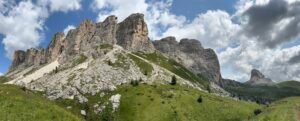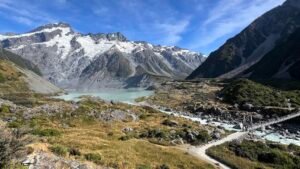Portugal is a country of diverse landscapes with a little something for everyone. We took what we like to think of as a sampler trip, tasting the best of mainland Portugal by visiting Lisbon, Porto, and the Algarve.
Lying along the Atlantic coast of the Iberian Peninsula, seafood lovers will rejoice no matter what area is visited. We spent a little over a week in late March exploring the history of Portugal in Lisbon, sampling amazing port wine in Porto, and hiking and boating along the cliffs of the Algarve. This gave us a tiny glimpse of why Portugal is such a popular destination these days and left us wanting to come back in the future to explore even more.
Portugal Map
Below is a map of our trip including points of interest, activities, and restaurants. Toggle the sidebar for details.
Trip Overview
This trip begins and ends in Lisbon, with travel to Porto in the north by high-speed train. For the time in Algarve, a rental car is necessary.
- Lisbon | Days 1-2
- Porto | Days 3-5
- Algarve | Days 6-10
Arrival & Helpful Tips
Getting Around
The cities in Portugal visited as a part of this itinerary, Lisbon and Porto, have public transportation in the form of metros, trams, and buses. However, we also found them to be quite walkable and when that failed, finding a ride via Uber was extremely affordable and efficient. We recommend downloading the Uber app and setting up an account before arriving in Portugal.
In the Algarve, we recommend renting a car to have the freedom to fully explore the many towns dotting the coastline. We found driving in Portugal to be very easy and straightforward.
Arrival
If arriving from outside the EU, you will need to go through immigration and customs. At this time, no visa is needed for U.S. passport holders, although this is expected to change in 2026 when the ETIAS (European Travel Information and Authorization System) comes into effect.
Portugal is a great add-on destination from another European country. We combined our trip to Portugal with one from Spain, so we did not need to go through immigration or customs.
Lisbon: Arrival & Food Tour
Where We Stayed
We stayed at an Airbnb in Lisbon’s Baixa neighborhood. Its central location meant the apartment was only steps away from all the action including restaurants, city sights, and the metro station. We ended up walking everywhere we needed to go, aside from the Belém area and to/from the airport.
Getting to the City
We took the metro from the Lisbon airport to our Airbnb which was a 45-minute ride, and required changing lines once, but very cost efficient at EUR 1.85 each.
While there is a rechargeable transportation card in Lisbon called Navegante (available for purchase at all ticket kiosks), we didn’t use the public transportation enough to make it worth the effort to obtain one. Instead, we simply tapped to pay with our credit card.
Food Tour
A delayed flight and a named coastal storm couldn’t stop us from joining a food tour on our first evening in Lisbon. We joined Eating Europe’s Undiscovered Lisbon Food & Wine Tour.
Over the course of about four hours our group meandered our way through the Baxia and Mouraria neighborhoods of Lisbon. We sampled Bifana (pork sandwiches), samosas, Bacalhau à Brás (an incredible mix of sautéed onions, shredded cod, and fried potato sticks), local cheese and smokes sausages, and capped off the night with our first Pastel de Nata (custard tart).
The food was delicious but we also really enjoyed the variety of the types of places we visited. Some were family-run restaurants in business for generations, others were more upscale affairs, and we ate our pastries in the middle of the bustling street. Our guide was energetic and humorous, keeping up the group’s enthusiasm despite the horrible weather between stops. We also learned a lot about food culture in Lisbon and felt prepared to order on our own the next time. We recommend this tour as a great introduction to Portuguese cuisine!
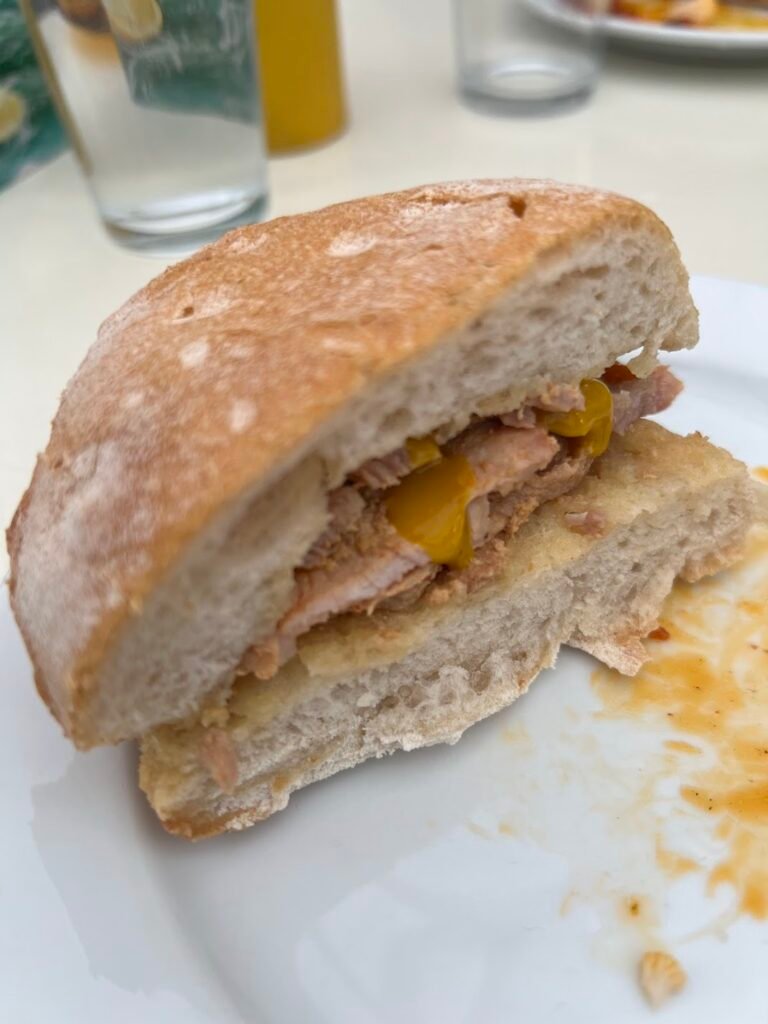
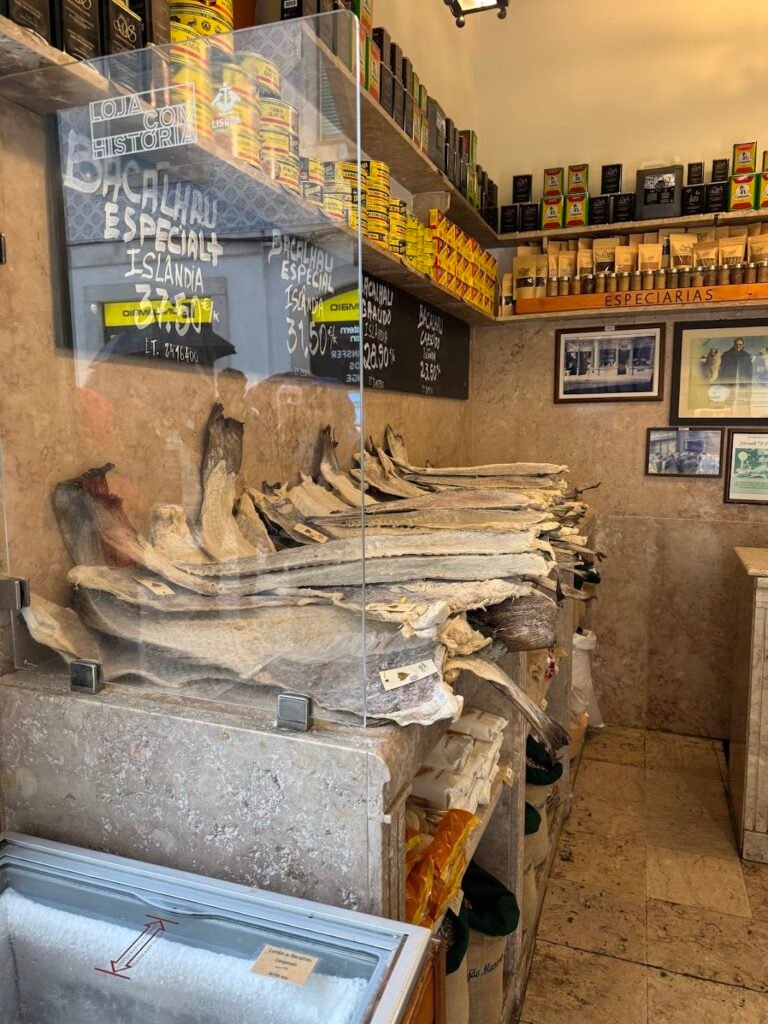
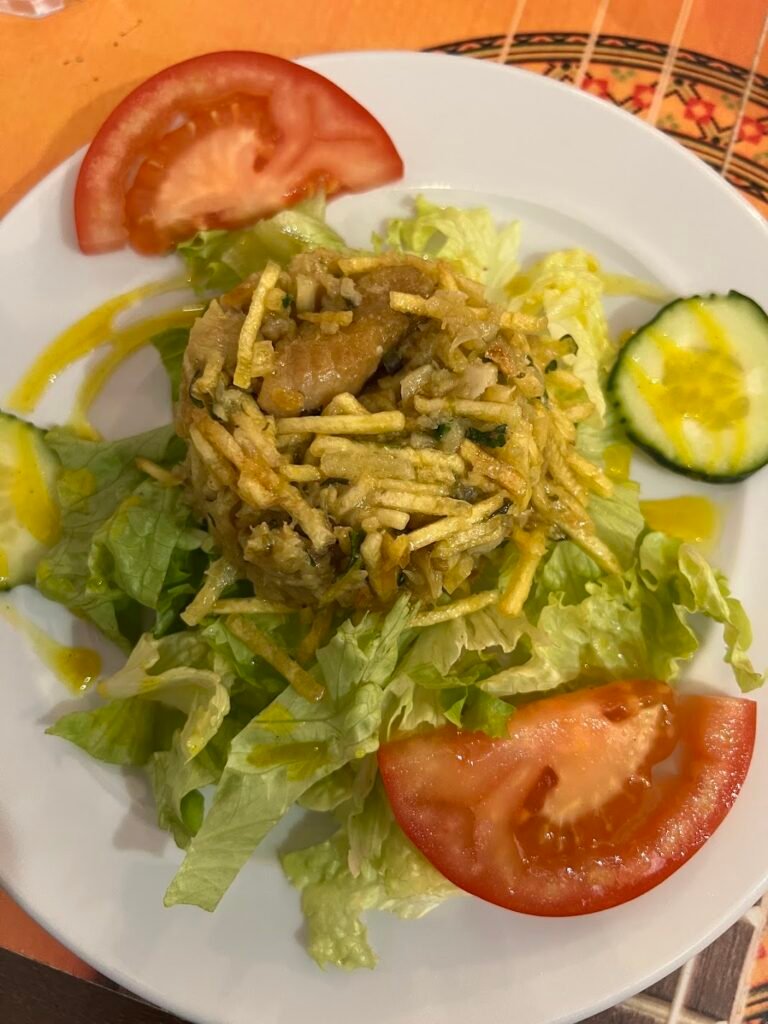
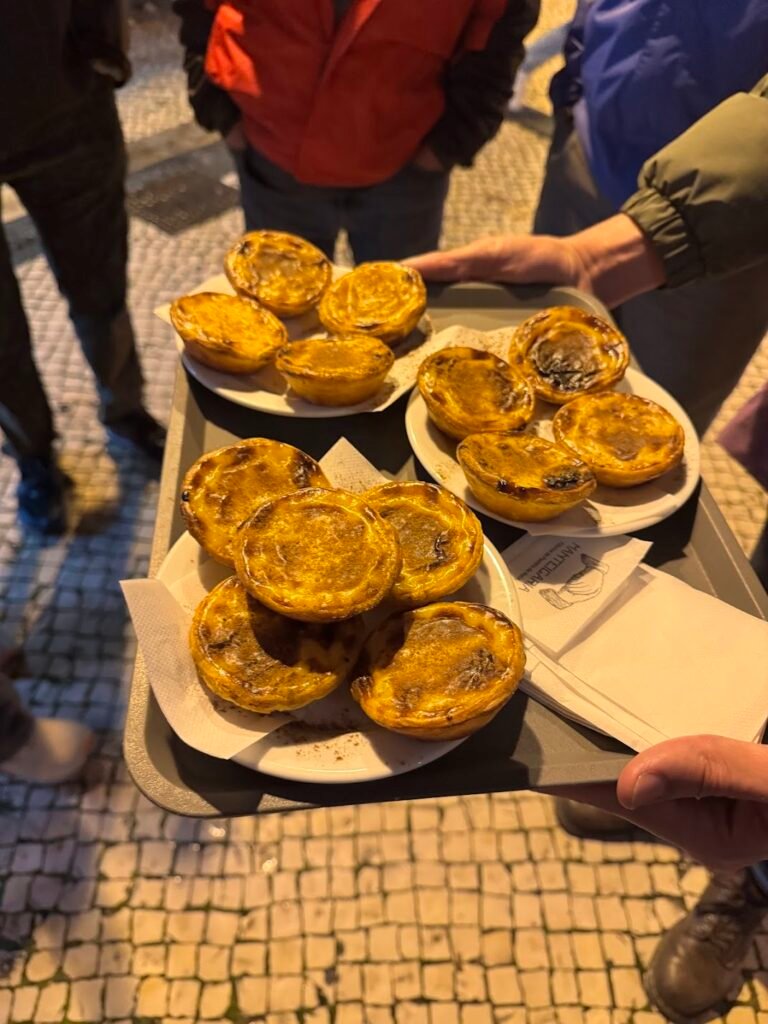
Day 1|Lisbon: Walking Tour & City Sights
Walking Tour
Our first full day in Lisbon we joined Inside Lisbon’s Best of Lisbon Walking Tour. This tour was fantastic and helped us to gain not only an understanding of the city, but the forces that shaped Portugal’s history including politics, exploration, and the devastating earthquake of 1755. We also got incredibly useful insider tips like how to use public elevators (that are otherwise virtually hidden!) to get from one level of the city to the other, up much higher.
This tour took us through most of the main neighborhoods of Lisbon including Rossio, Carmo, Chiado, Alfama and Comércio Square. Along the way we tasted another Pastel de Nata and a codfish cake with green wine (not actually green, but a young, light wine). We also tasted our first Ginjinha, a Portuguese liqueur made from an infusion of ginja berries. We purchased our drinks served in chocolate shot glasses from delightful ladies running a stand in Alfama.
We highly recommend this tour for anyone looking to learn a lot more about Portugal. It provided a frame of reference for us for the rest of our trip. Our only complaint was that the tour supposed to be three hours in length but ended up running almost four hours!
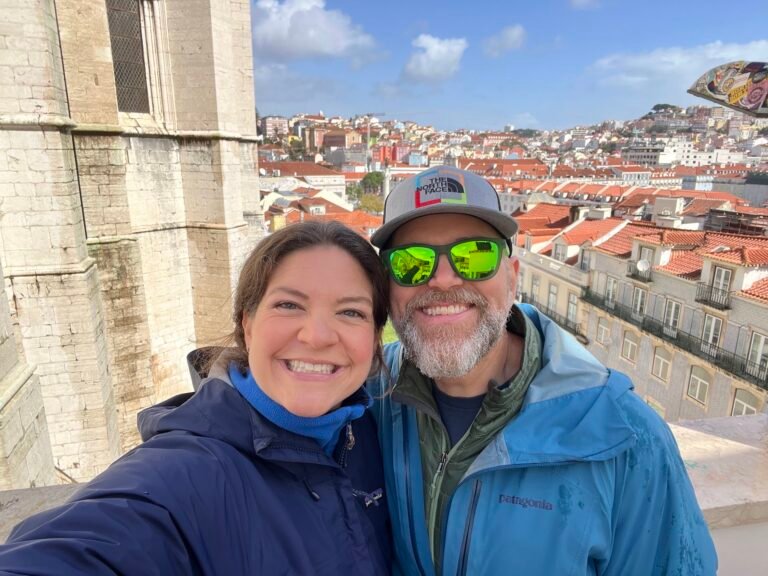
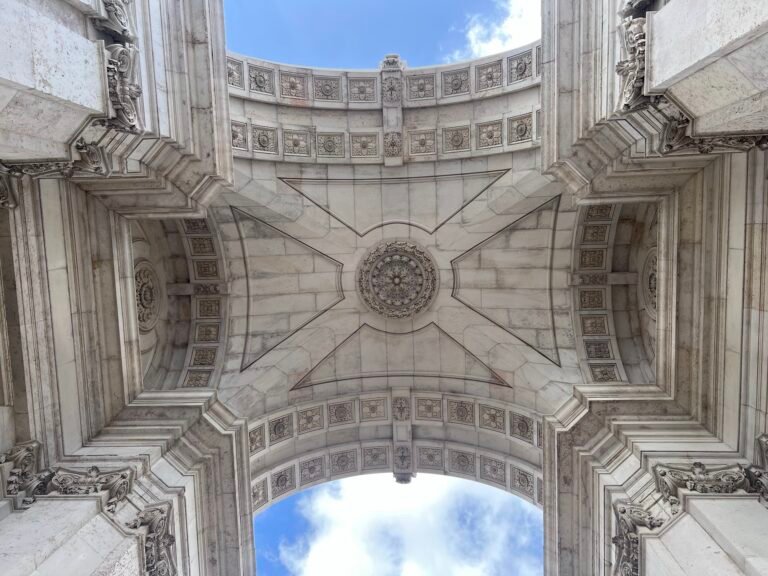
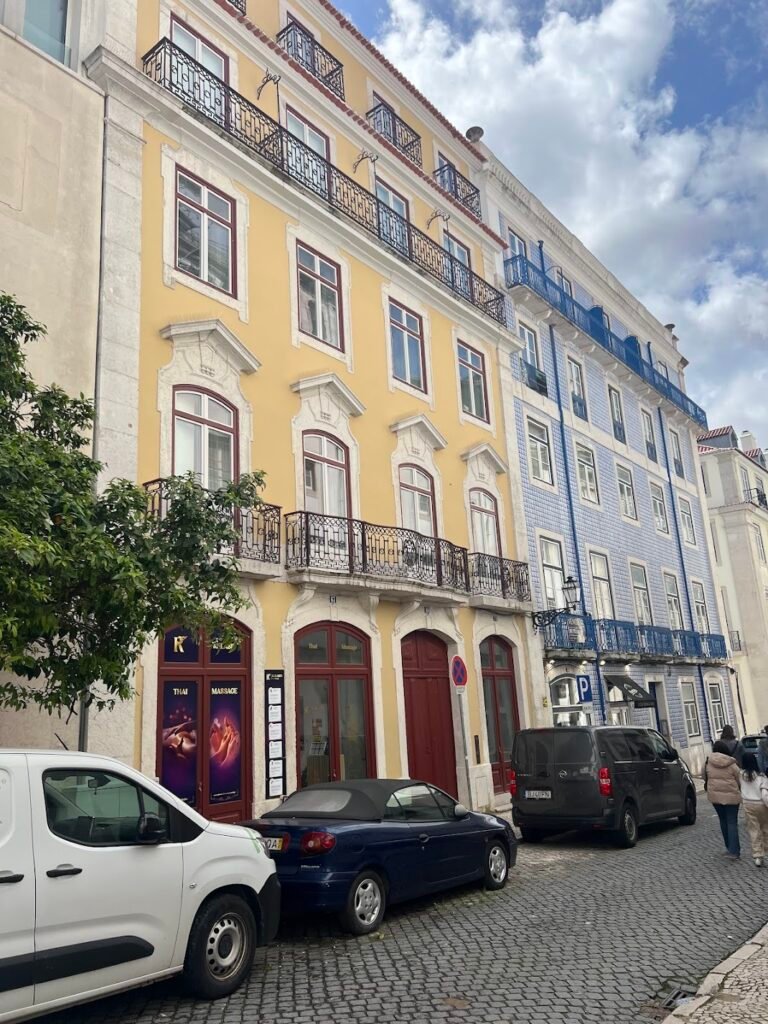
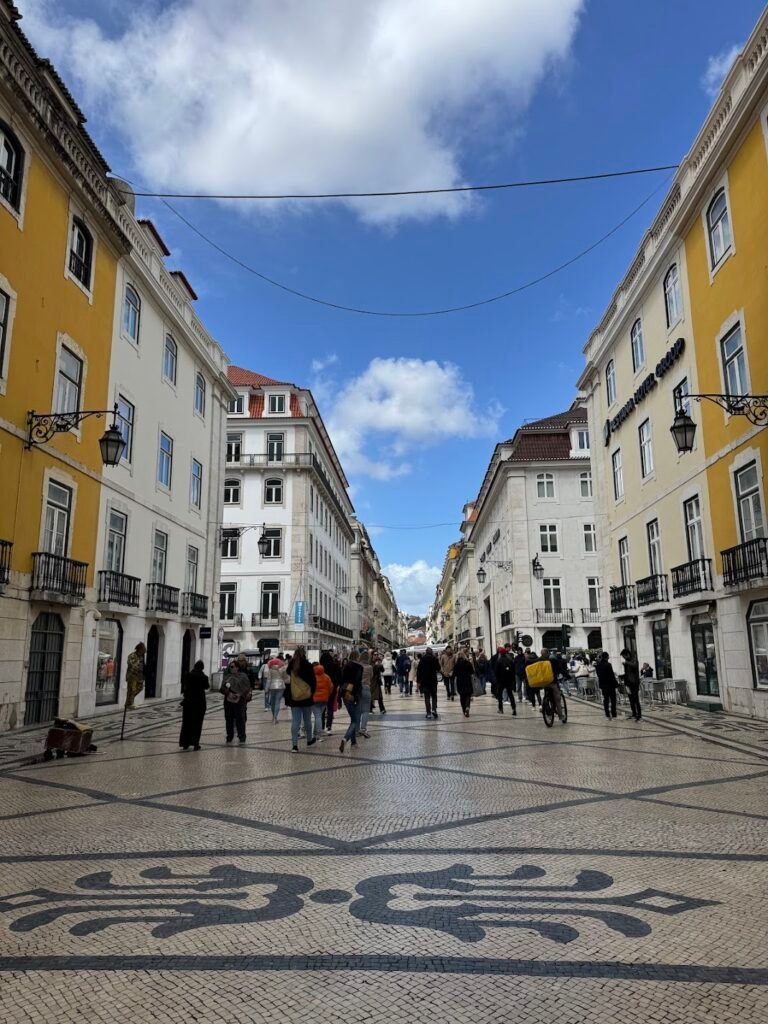
City Sights
Lunch
We had wanted to try lunch at Miss Can, a very small tapas restaurant known for their canned fish, but no seats were available and we were famished and didn’t want to wait. The most famous Bifana shop in the city, As Bifanas do Afonso, was our second choice but the line was nearly 50 deep so we skipped that too. We mention these in case you want to check them out for yourself. We ended up popping into a no-frills tasca for a quick pork sandwich. Tascas are Portuguese eateries where locals come together to enjoy simple, traditional dishes.
Museu Arqueológico do Carmo
This museum lies in the center of Lisbon on the site of the former Convent do Carmo. The convent was built in the 14th Century but subsequently damaged in the 1755 earthquake. It is now home to a museum housing artifacts spanning all periods of Portuguese history. The open-air nave has tombs, fountains, windows, statues, and other relics.
We really enjoyed our visit to this museum and spent about one hour. Admission was EUR 7/pp. Hours vary by season, but the museum is generally open every day except Sundays. Check the website for current hours.
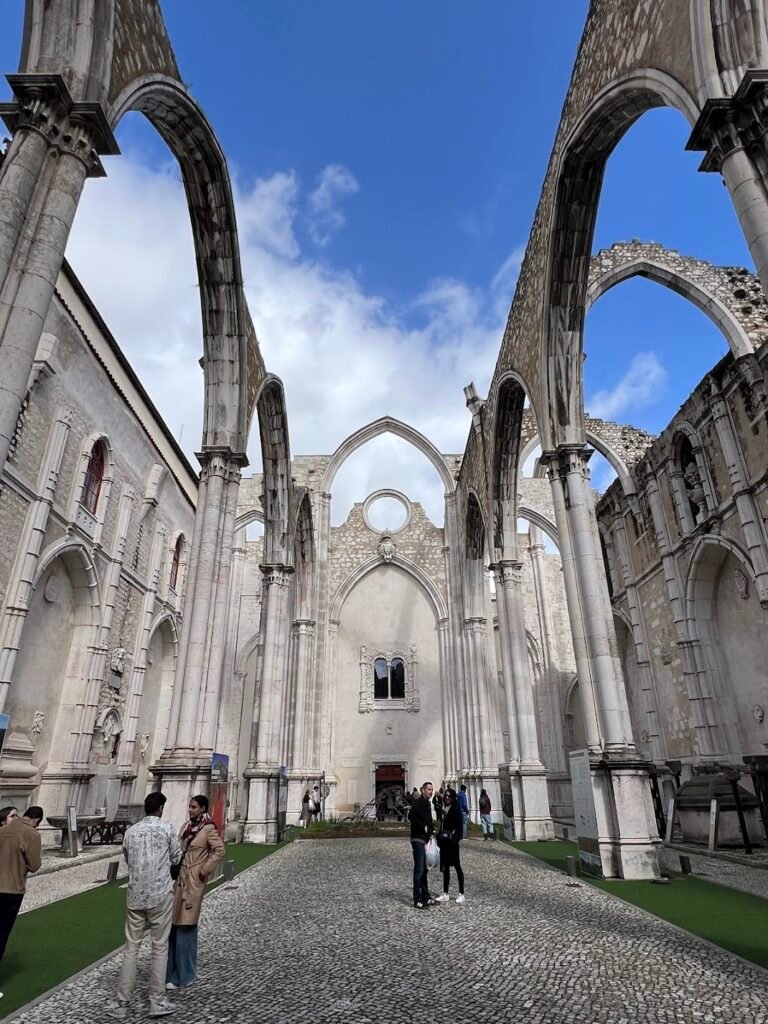

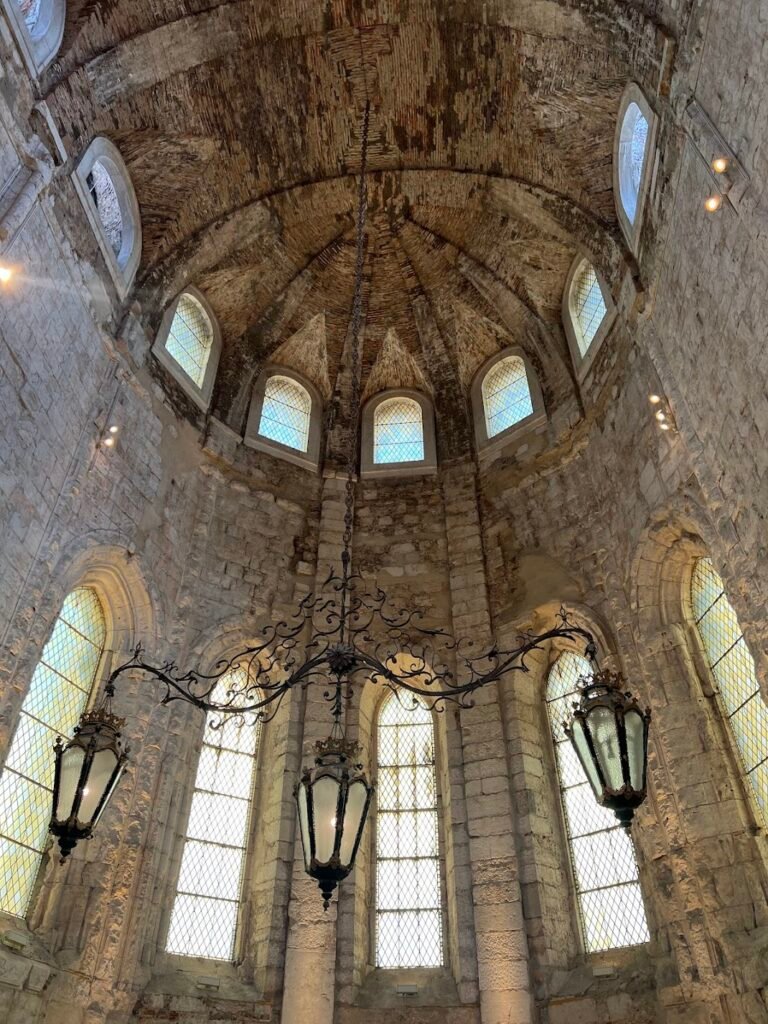
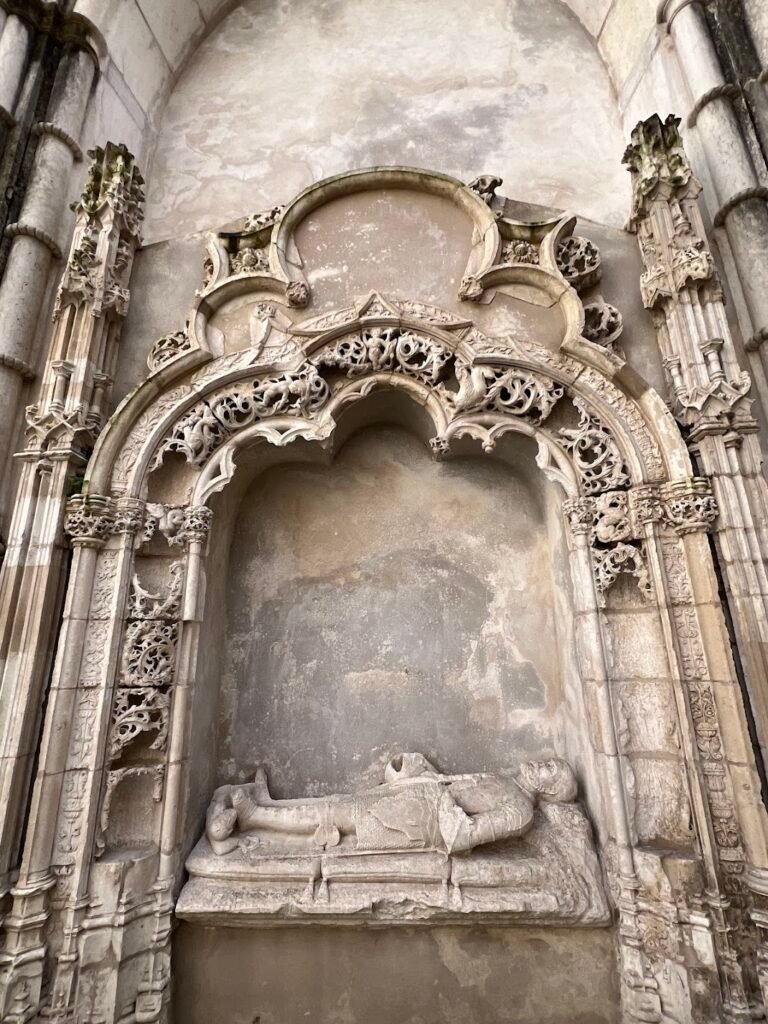
Lisbon the perfect city to just wander around, get lost in the maze of cobblestone streets, and pop into any store or attraction that catches your interest. In the afternoon, we walked by or visited:
Lisbon Cathedral
This is the oldest church in the city, built in the 12th Century. We did not go inside but the facade and area surrounding it was beautiful to take in.
Santa Justa Lift
While it is now a tourist attraction, the lift was originally a civil project to connect the lower streets of Baixa to those on the higher Carmo Square. The iron-decorated lift stands out, nestled between more historic-looking buildings. While you can pay (and wait in a long line) to take the elevator to the top of a terrace and walkway, you can instead walk to a platform for free right next to the walkway. This is exactly what we did as part of our walking tour and found the views to be just as a great.
A Ginjinha
We wanted to experience the original Ginjinha, and you can do so at A Ginjinha. This tiny, standing-only bar has been run by the same family for five generations and in business since 1840. The line moves quickly and the shots are EUR 1.55 each, cash only.
The Fantastic World of Portuguese Sardines
Even if you don’t buy anything, this store with its carnival-like atmosphere is fun to walk through. You’ll know you’re in the right place when you pass a mini-ferris wheel of tinned sardines in the window. Once you enter you’ll see floor to ceiling tins of every fish imaginable. There’s even a sardine king throne!
Livraria Bertrand
Founded in 1732, you can visit the world’s oldest operating bookstore with the Guinness Book of World Records in the window to prove it. There are books of every type and genre, and if you purchase one, you can ask to have it stamped as having been purchased at the world’s oldest bookstore.
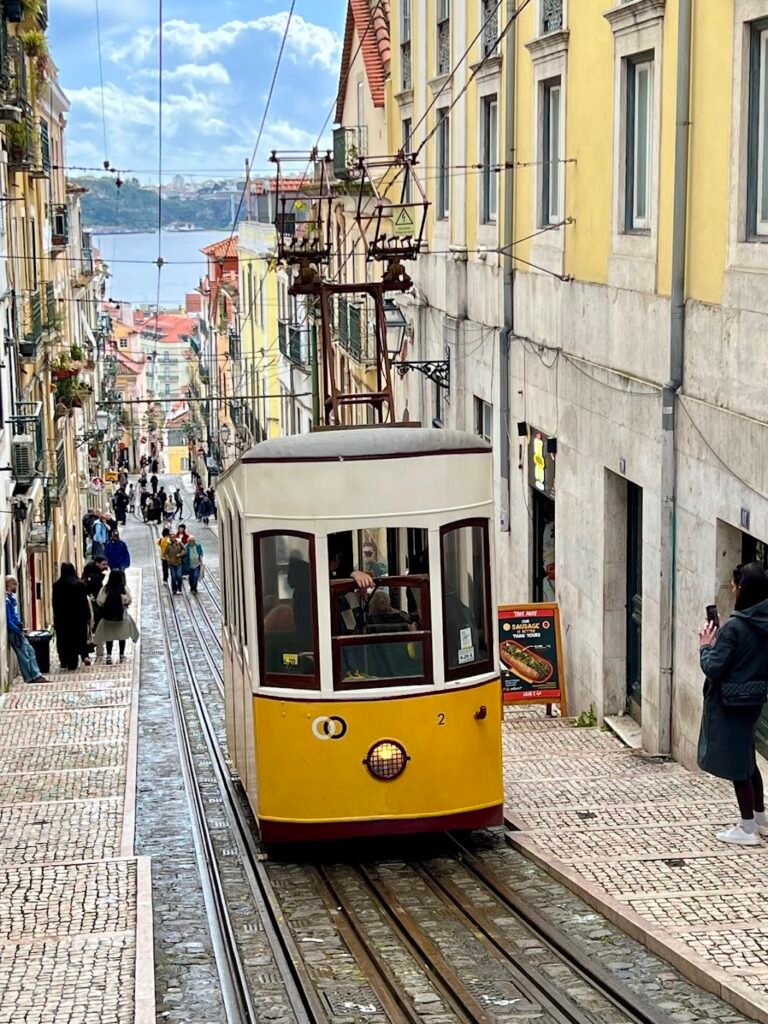
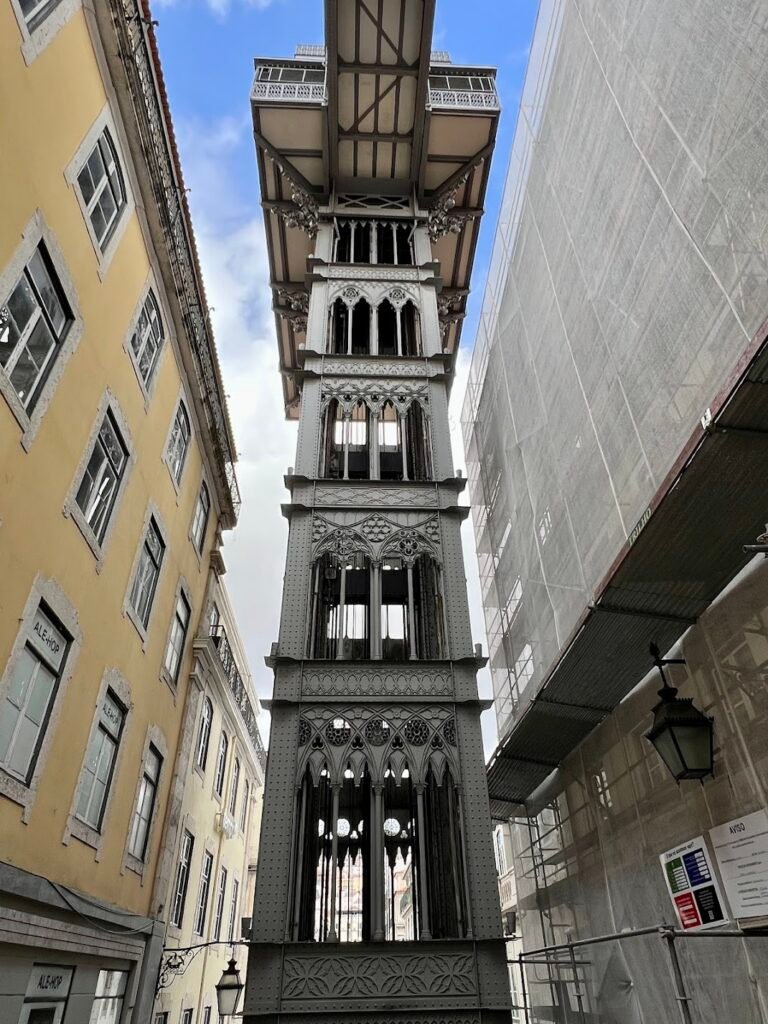
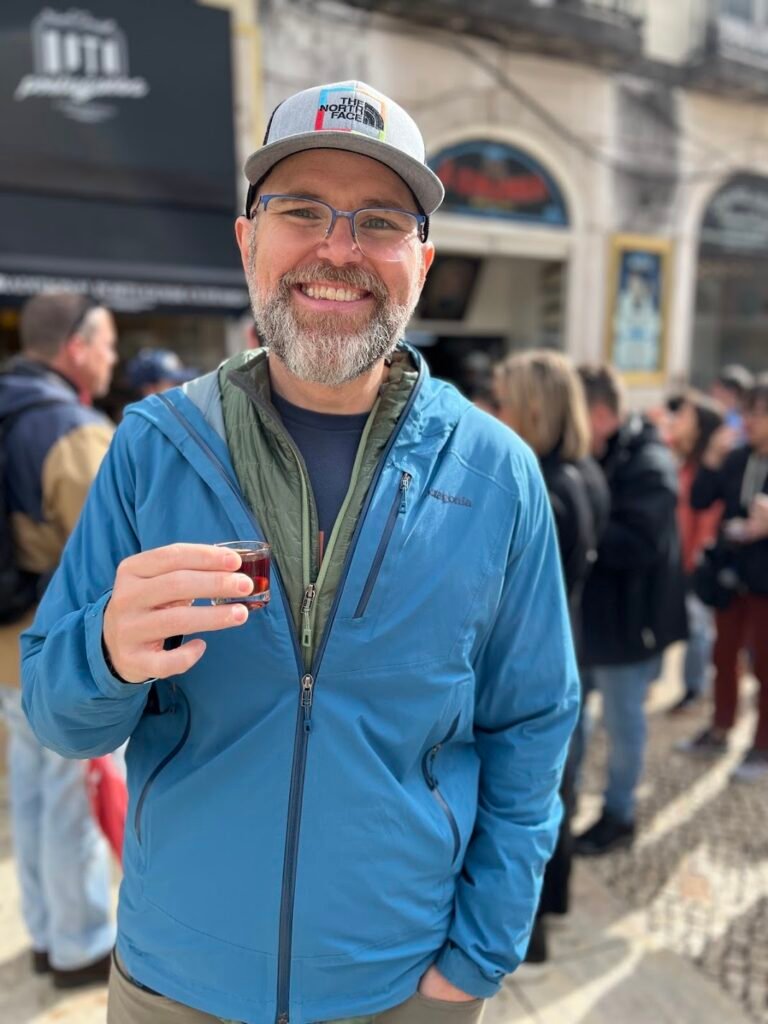
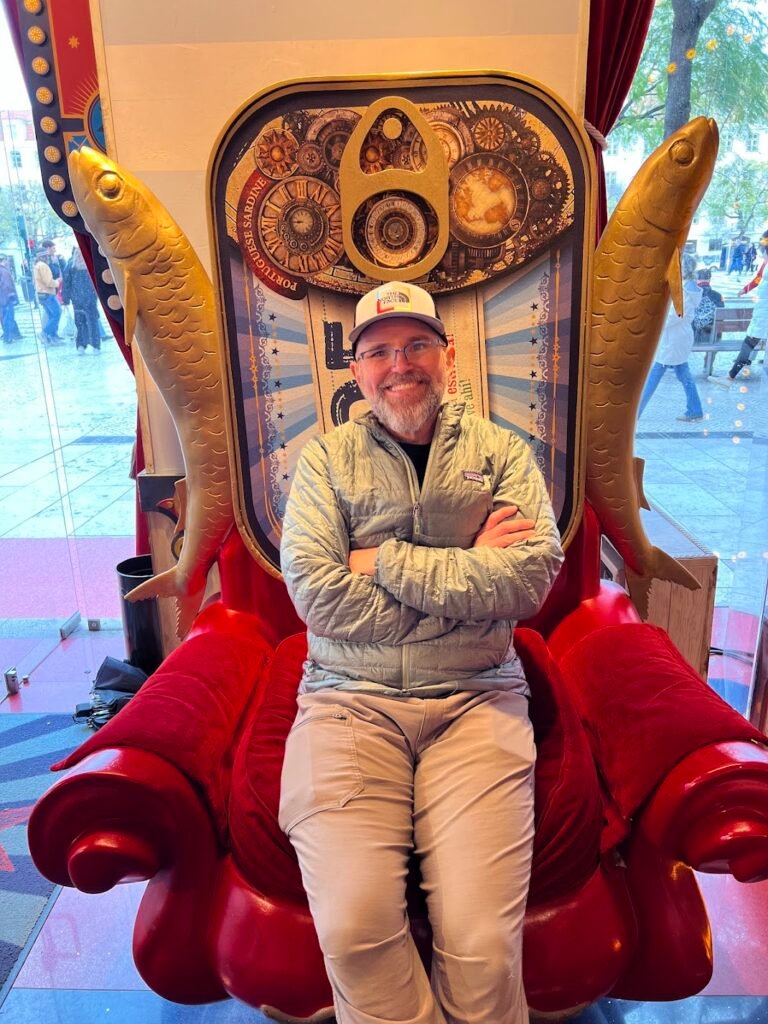
Dinner
You’ll have your pick of tasty choices for dinner in Lisbon. We had what was our favorite dinner of our entire two-week trip at Fumeiro de Santa Catarina. Specializing in smoked foods, the dishes are served tapas style.
We dined on sourdough with butter & olives, smoked cod with beans, grilled octopus, shrimp, and a meat platter with pulled pork, steak, and chorizo. A bottle of red from Portugal’s Alentejo region, almond cake with cream, and a glass of port topped things off. The flavors were truly outstanding and the staff was lovely.
The restaurant is tiny so be sure to make reservations in advance. We were able to do so easily online via The Fork.
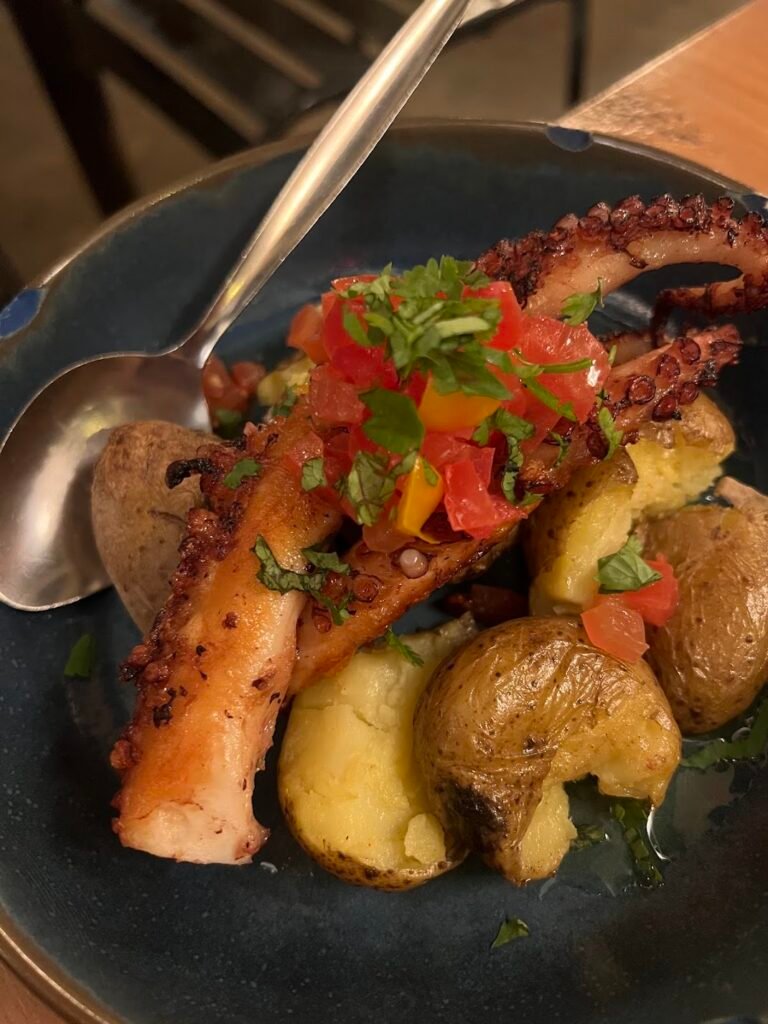

Day 2|Lisbon: Belém
A note on today’s itinerary: We originally planned to take a day trip to Sintra. Located just outside Lisbon and accessible via a 45-minute train ride, Sintra is home to historic castles and estates. Our itinerary had us visiting Quinta da Regaleira, Park and Palace of Monserrate, Pena Park, and the Moorish Castle. Due to the storms that battered the area, these sites were closed to visitors as crews cleaned up downed trees and ensured the buildings were structurally safe.
We were really bummed, but want to note we were able to quickly get refunds on all our pre-purchased tickets (these sites do sell out in advance). Instead, we took a more leisurely day to explore Belém rather than try and cram everything into one long day. We still have visiting Sintra on our list. Next time!
Pastel de Belém
Having tried several Pastel de Nata, now it was time to try Pastel de Belém. This is THE original custard tart made from a recipe that has remain unchanged since 1837 after have been handed down from the nearby Jerónimos Monastery.
We got four and devoured them instantaneously, unanimously agreeing these were superior to the Pastel de Nata we had tried thus far. If you go and don’t care about sitting down at the cafe, follow the signs for the “Historic Counter”. We avoided waiting in a huge line, walking right up and purchasing our pastries at the counter (EUR 1.50 each, payable by cash or card).
Note: To avoid time-consuming rides on public transportation to get to the Belém area, we took an Uber from our Airbnb for less than 10 Euro and had a great experience.
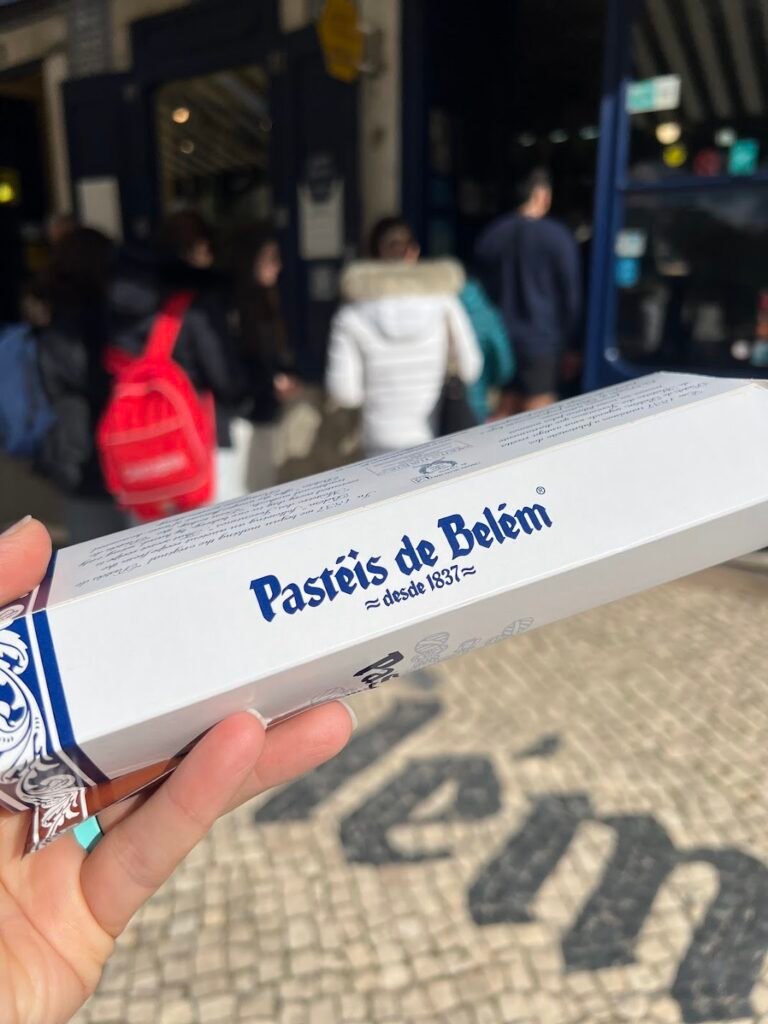
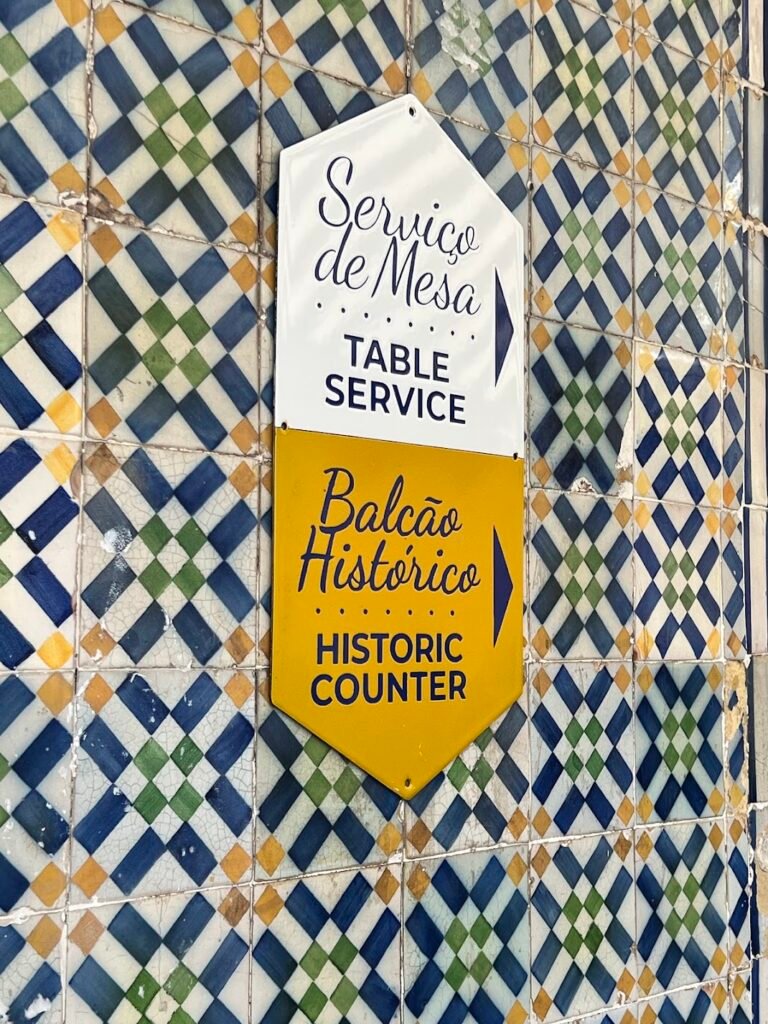
Jerónimos Monastery (Mosteiro dos Jerónimos)
Mere steps away from the cafe is the Jerónimos Monastery, one of the most-visited sites in Lisbon. The building was designed to commemorate the return of Vasco da Gama from India, with construction beginning in 1501 and continuing into the 17th Century. The gothic design and carved limestone are incredibly impressive inside and out. The complex is absolutely worth a visit!



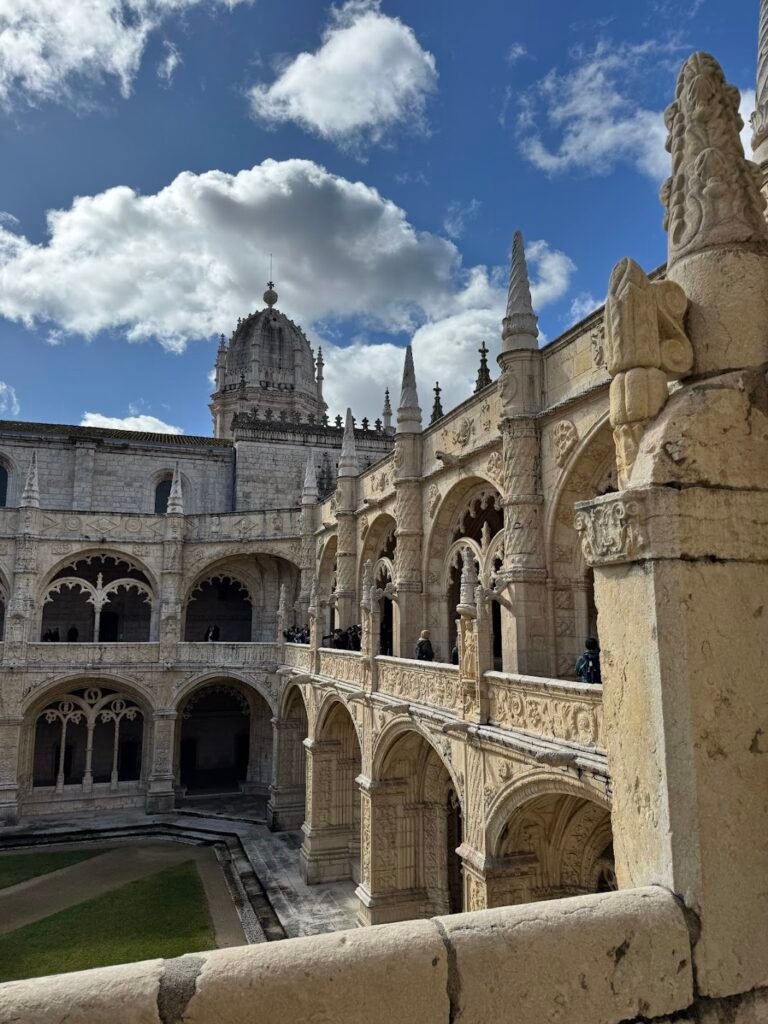
Need to Know
- Hours: Generally open Tuesday-Sunday 9:30am-5:30pm, but check the website for current hours.
- Tickets: Purchasing advance tickets online will help you avoid waiting in line at the on-site ticket office. We purchased our tickets on the official website the evening prior, for EUR 18/pp. The tickets were for either a morning (9:30am-1pm) or afternoon (1-5pm) entry.
- Our Experience: We arrived around 10am and while there was a long line of ticket holders outside the monastery, it moved quickly and we were inside in about 15 minutes. We spent about 40 minutes exploring inside.
Church of Santa Maria (Church of Santa Maria de Belém )
Directly next door to the monastery is the Church of Santa Maria. Before heading inside, don’t miss the ornate South Portal (side) entrance. Towering 105 feet high, its intricate features include carvings and detailed art work weaved around a statue of Henry the Navigator standing on a pedestal between the two doors. When we visited the interior was under heavy renovation work, but the beauty was evident and seeing the tomb of Vasco da Gama on display was neat.
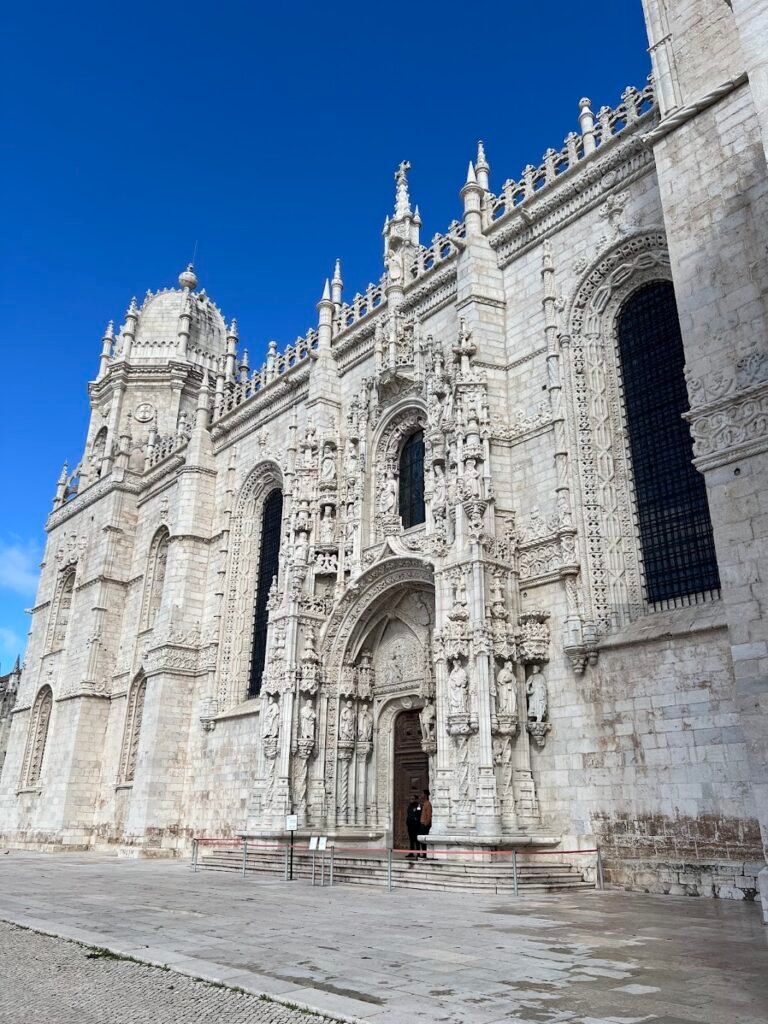
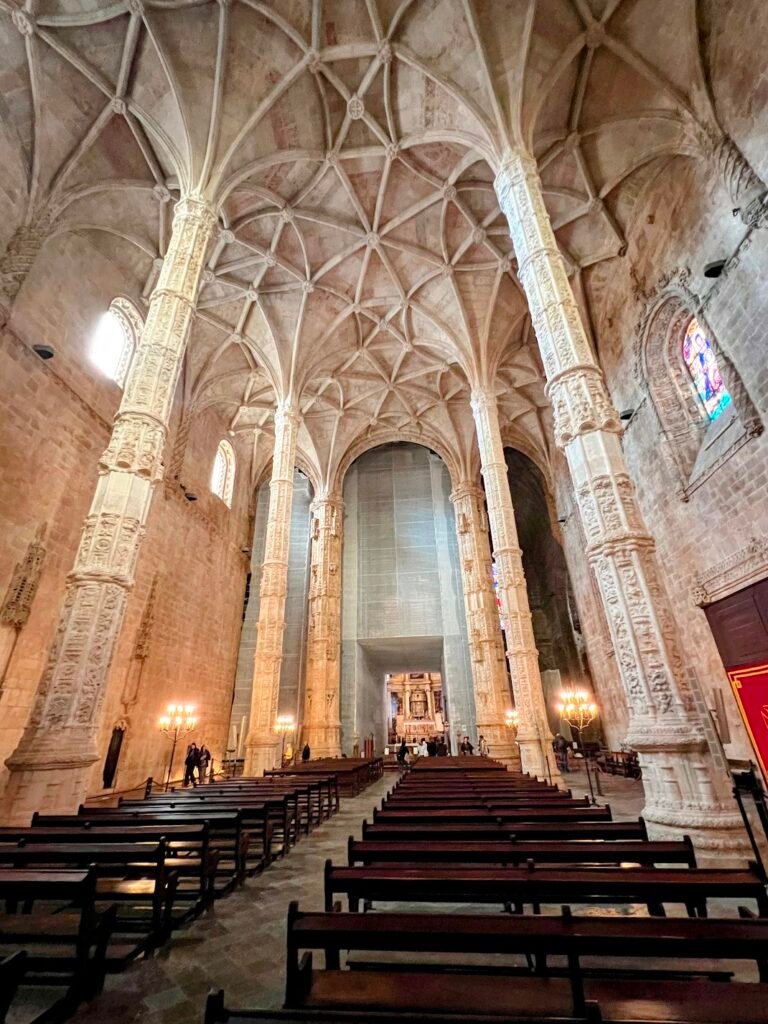
Need to Know
- Hours: Generally open Tuesday-Saturday 10:30am-5:pm and Sunday 2-5pm, but check the website for current hours.
- Admission: Admission to the church is free.
- Our Experience: There are separate lines to enter the monastery and the church. Be sure to pay attention and ensure you are in the correct line. Generally speaking, when facing the buildings the monastery entrance line will extend to the left, and the church to the right. We waited about 10 minutes to enter the church on a Sunday afternoon and spent about 15 minutes once inside.
Maritime Museum (Museu de Marinha)
One block east of the monastery is the Maritime Museum, dedicated to the history of exploration and navigation in Portugal. The exhibits are sprawling and include maritime instruments, scale models of ships, paintings, and more. A separate hanger-like building houses a collection of royal barges and other watercraft. We really enjoyed visiting this museum as a complement to our other experiences in Portugal, given the importance of exploration in the country’s history.




Need to Know
- Hours: Generally open daily 10:00am-5:00pm, but hours vary seasonally so check the website for current hours.
- Admission: EUR 8/ per adult. We purchased our tickets on site, payable via card or cash.
- Our Experience: On a Sunday, late morning, we encountered very few other individuals in the museum, especially as compared to the crowds in the monastery. We spent about an hour.
Lunch
There are various cafes and stands dotting the streets of Belém. We stumbled on the food cart Mexijitos located in the Jardim da Praça do Império (a square green space located along the Tagus River). We thoroughly enjoyed delicious el pastor bowls in their outdoor seating area.
Monument to the Discoveries
Celebrating the Portuguese Age of Discovery over the course of the 15th and 16th centuries, the Monument to the Discoveries displays carvings of 33 figures integral to Portugal’s history of exploration. While we visited it was closed for entry and could only be viewed from outside, but when it reopens there is an observation deck you can pay to visit.
Belém Tower
A short walk away along the river lies Belém Tower. Constructed in the 16th Century as part of a defense system, the tower has had a second life as a lighthouse and customs house, and is now a tourist attraction. Due to scattered storms the day we visited, we did not pay to enter, but thought it was worth seeing even from the exterior.
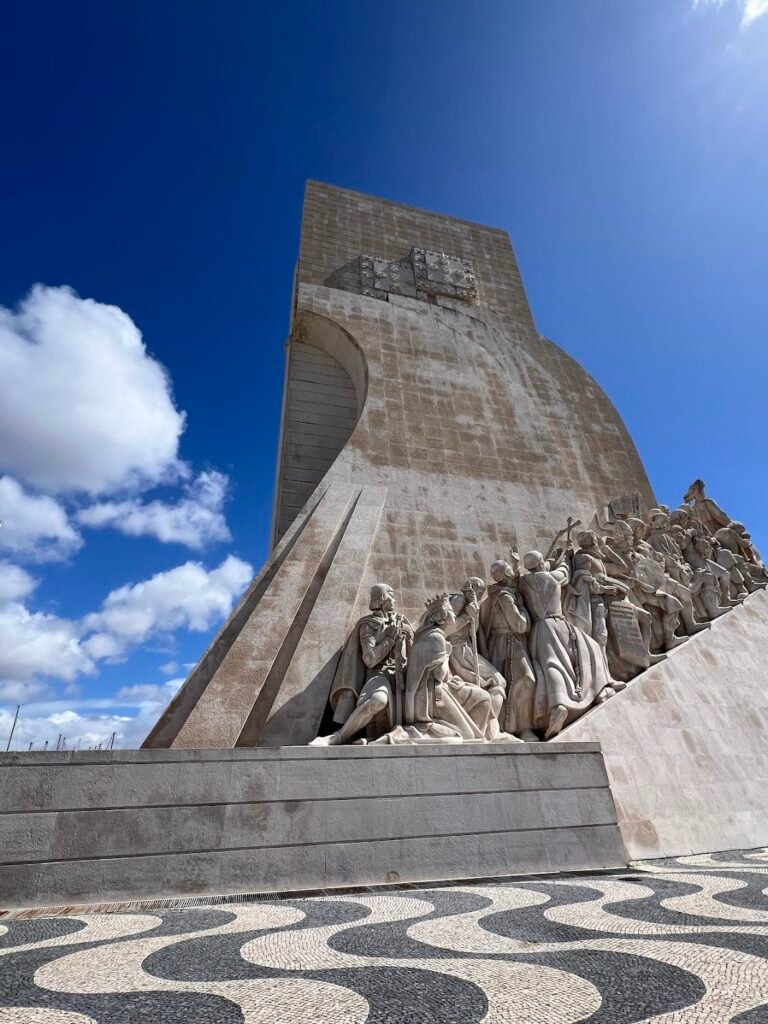
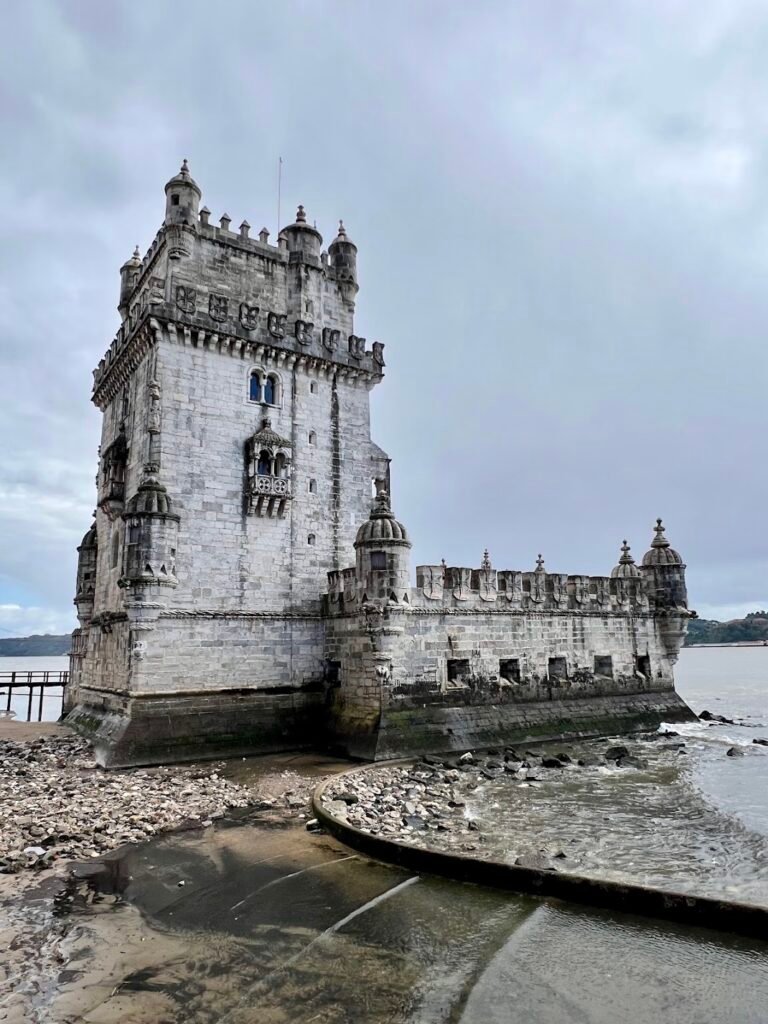
Drinks & Dinner
Craving craft beer, we headed to Brew! in downtown Lisbon. They had an amazing selection of drafts and cans, some from breweries just up the road from us in the U.S.! We enjoyed the laidback atmosphere and delicious beer.
We went to dinner at the bustling Time Out Market. Designed as a market to highlight local chefs and restaurants, the choices are almost overwhelming. We did a lap around all the stalls, settling on the Marlene Vieira food corner. We shared codfish fritters, roasted codfish, and grilled octopus with glasses of red wine. Although we ate at a communal table and could barely hear each other above the noise (the market was packed!), the food was incredibly upscale and absolutely delicious. Time Out Market is a really fun place to try different dishes, all under one roof.
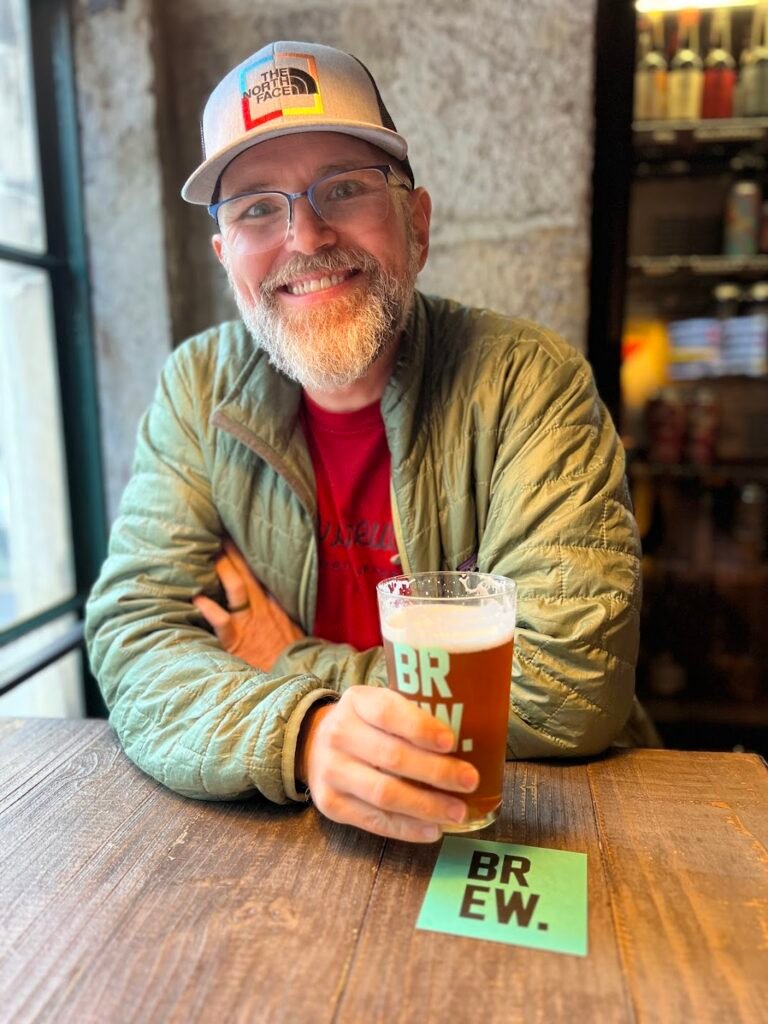

Day 3|Porto: Clérigos Church, Porto Bridge Climb & Fado
Travel
We traveled from Lisbon to Porto on the high-speed train Alfa Pendular. We purchased our tickets directly on the Comboios de Portugal website for about EUR 35 each for “Turistic/2nd” reserved seats. If purchasing your tickets online, be prepared to enter each traveler’s name and passport number. Once on the train, the conductor asked for our passports to match up to our tickets.
The journey from Lisbon (Santa Apolonia station) to Porto (Campanha station) took about 3 hours. The train was clean, comfortable, and had free wifi and ample luggage storage space.
Pro tip!: When you arrive at the Campanha station in Porto, you can transfer to the São Bento station via a regional train, for free, with your existing mainline ticket, provided you do so within an hour of arrival. This is a quick, 5-minute ride that will give you your first glimpses of the Douro River and Porto’s iconic bridges!
Where We Stayed
We stayed at an Airbnb on the charming pedestrian-only street of Rua das Flores in Porto. A mere 5-minute walk from the São Bento station and only a slightly longer walk to the other main attractions, we loved this location.
Lunch
At the recommendation of our Airbnb host, we had lunch at a cafe just steps away from our apartment in Porto called Mercador Café. Specializing in brunch, we loved our order of iced lattes and steak sandwiches with fries.
Clérigos Church & Tower
Dating back to the 1700s, the baroque Clérigos Church and its bell tower, which stands at 250 feet tall, are a great place to visit. The church is beautiful to walk through with its high-domed ceiling and large pipe organs. We liked climbing the 225 steps up to the two-storied tower best. Along the way, in the interior, we had viewpoints of the church below and there were some interesting exhibits and art. Once at the top, we had stunning 360-degree views of Porto.
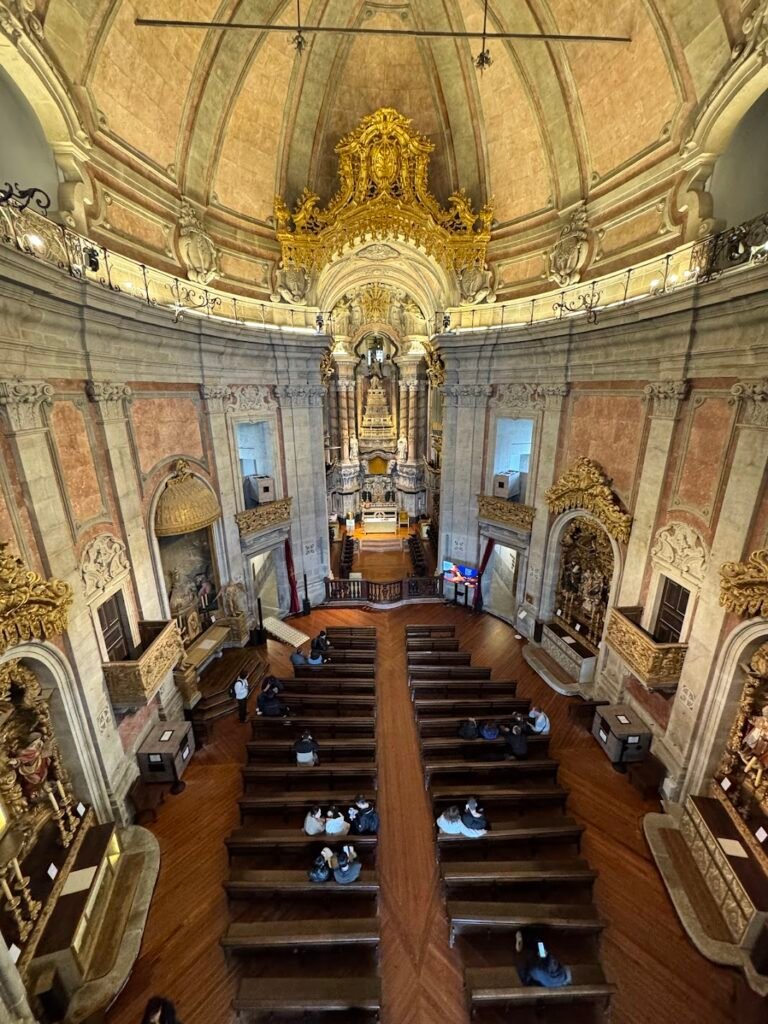


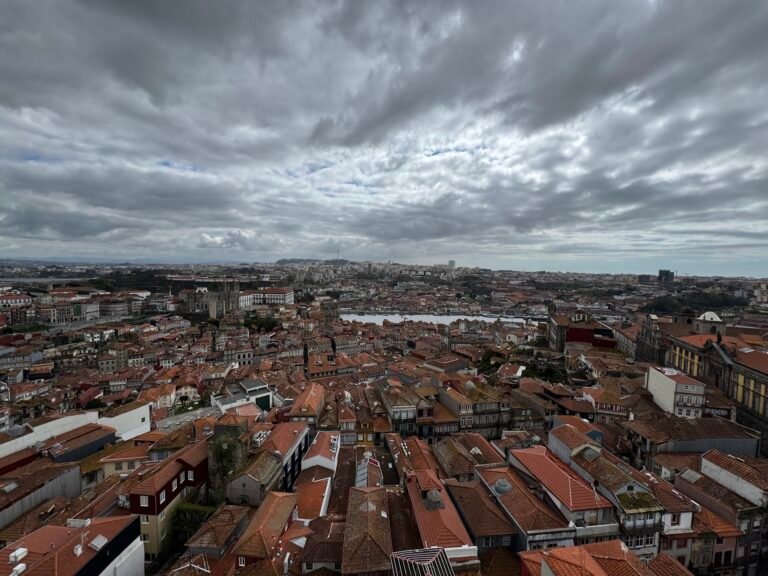
Need to Know
- Hours: Generally open daily 9:00am to at least 7:00pm, but hours vary seasonally and there are masses held on Saturdays and Sundays, so check the website for current hours.
- Admission: EUR 10/ per adult for admission to the tower and museum. If you just want to see the church, it is free to enter.
- Our Experience: We purchased our tickets on site, payable via card or cash, without waiting in any line. During the more crowded summer months, you may want to consider pre-booking a timed entry ticket online in advance. Time slots are every half hour.
Porto Bridge Climb
We made our way along the Douro River to the Arrábida Bridge, an arch bridge rising 230 feet above the river. We are always looking for our next adventure so what were we doing? Climbing it, of course!
We booked an excursion with Porto Bridge Climb. After arriving at the meeting point we stepped into our safety harnesses and before we knew it our group was climbing the 262 concrete steps to the top. Once at the middle of the bridge (the turnaround point), we had amazing views of the river below with Porto to the left and the Atlantic Ocean to our right. We had the chance to take plenty of photos and then to our surprise, we were served a glass of port in a chocolate cup! We really loved this experience which was short and sweet, at just an hour long.



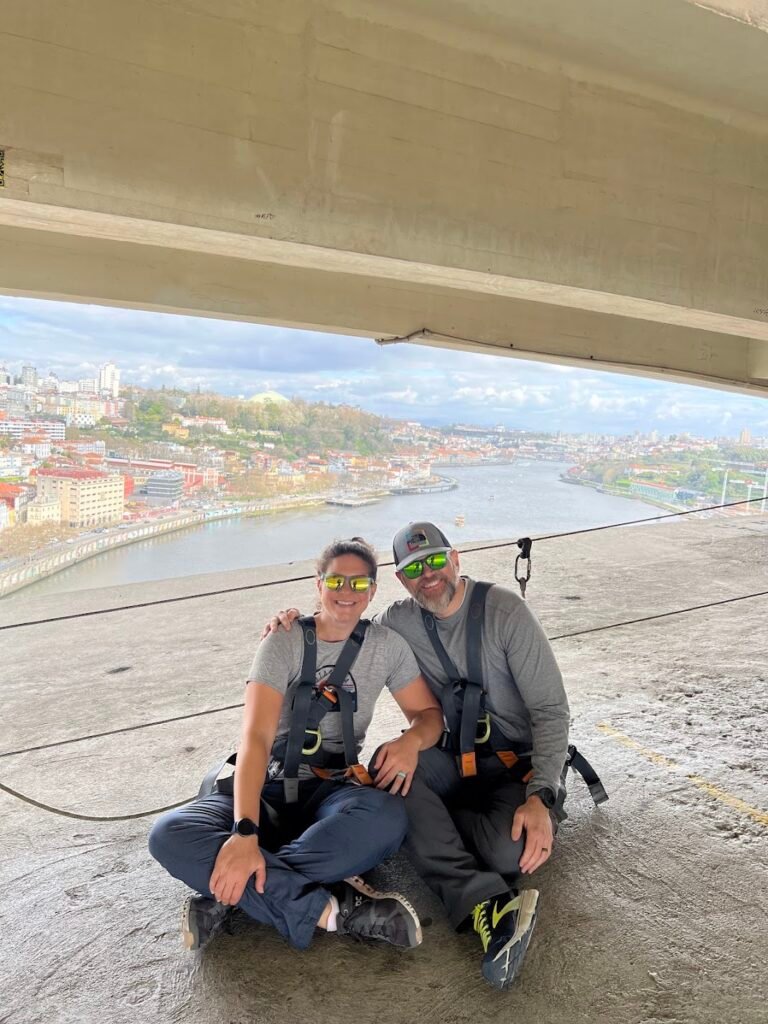
Need to Know
- Tickets: Climbs generally operate daily, in the afternoons. It is recommended to reserve a time slot via the website. When making a booking online, you reserve your time and then pay the full balance upon arrival. We paid EUR 20/pp.
- Our Experience: We made a booking online a few months in advance to ensure we got a spot on the day and time we wanted. The max group size is 13 people per time slot.
Note: Prior to the Fado concert we were feeling a bit peckish so we ate an afternoon snack at the tasca Sabor da Fazenda. Located just a block away from the Fado concert hall, we really enjoyed our codfish cakes, cheese, olives, and glasses of red wine.
Fado Concert
Fado is a form of music that originated in Lisbon and is often characterized by songs with themes of longing, symbolizing a feeling of loss. We wanted to experience this unique form of music and so we booked this Fado concert experience in Porto.
The venue was intimate and beautiful, taking place in a traditional 19th Century music hall. We were seated and served a glass of port and pastry before the performance began. The one hour show was amazing with a Fado singer accompanied by a Portuguese guitar and Spanish guitar. Interspersed among the 12 songs performed, the musicians provided explanations on the history of Fado, the songs, and the instruments. The songs alternated between those that were joyful and upbeat, to those more sorrowful. 10/10 for this experience!
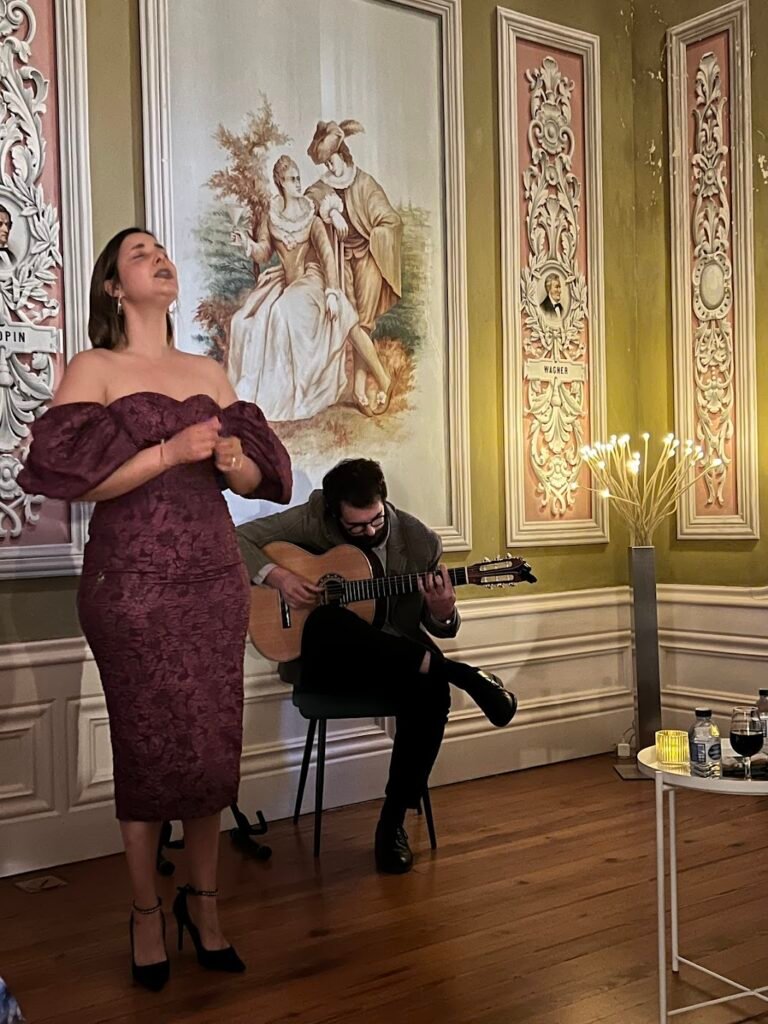
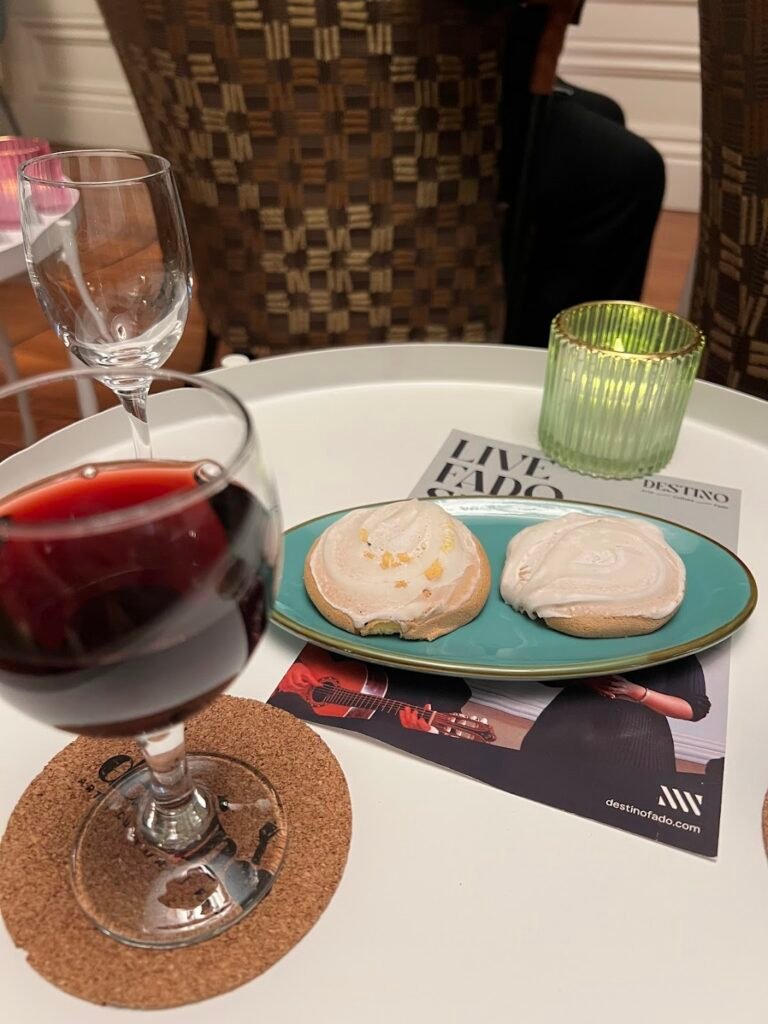
Dinner
For dinner we made our way to the Douro River and stopped in at Muro do Bacalhau. While we had no reservations, we were seated immediately and ended up having our favorite dinner in Porto. This Portuguese restaurant has amazing fresh seafood served sharing style. We had octopus cakes, duck rice, and steak. Accompanied by a lovely red wine from the Douro Valley and ending with a slice of madeira banana cake and a glass of tawny port. The meal was fantastic from start to finish and we would definitely recommend a meal here.
Don’t miss the great views of the Douro River and bridges at night!
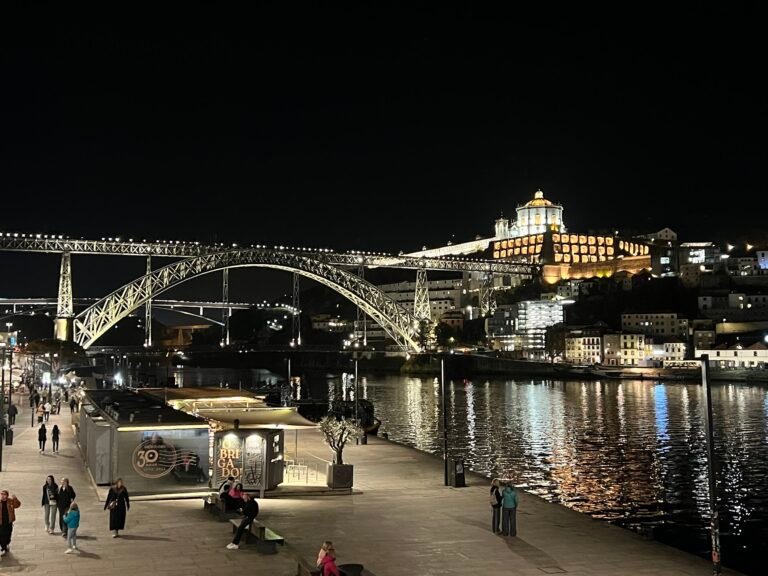
Day 4|Porto: Church of São Francisco & Port Houses
Church of São Francisco & Catacombs
Founded in 1245, the gothic-style Church of São Francisco looks fairly unassuming from the outside. The showstopper is the lavishly-decorated interior in which nearly every surface is covered in gold dust. There are floor to ceiling intricate wood carvings covered in this gold dust with multiple chapels. Unfortunately, no photos were allowed.
You can also visit the catacombs, where the remains of Franciscan monks and members of Porto’s wealthiest families are buried. There is an ossuary with human bones, some of which you can see through a glass floor. We spent about an hour touring the church and catacombs.
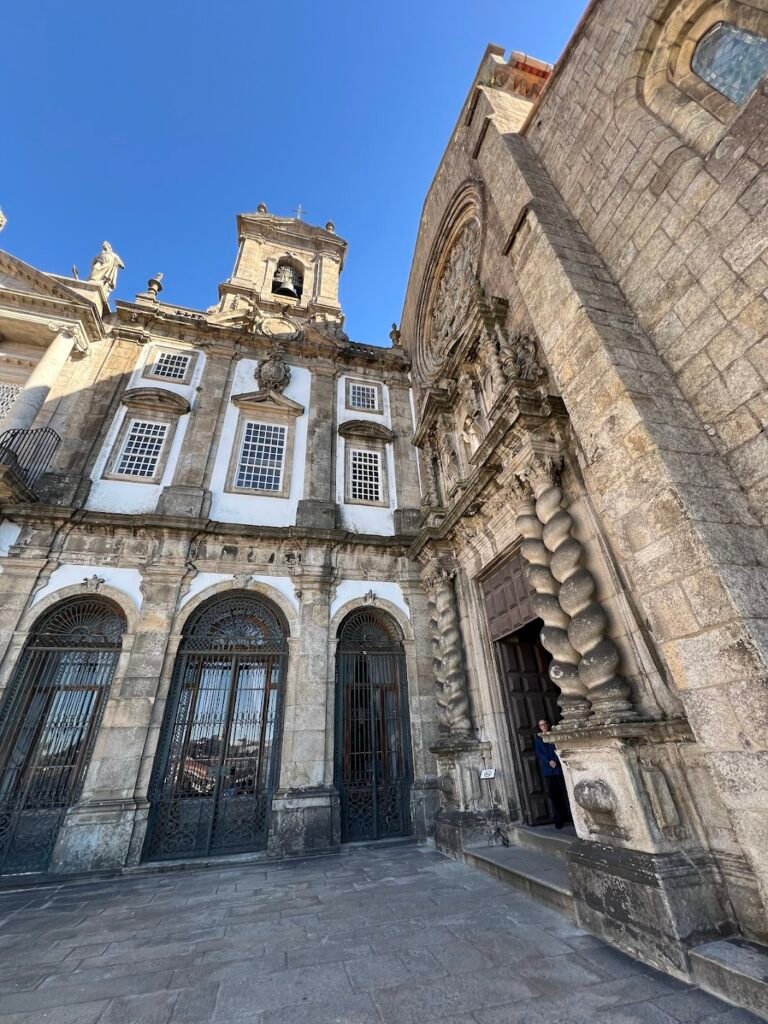
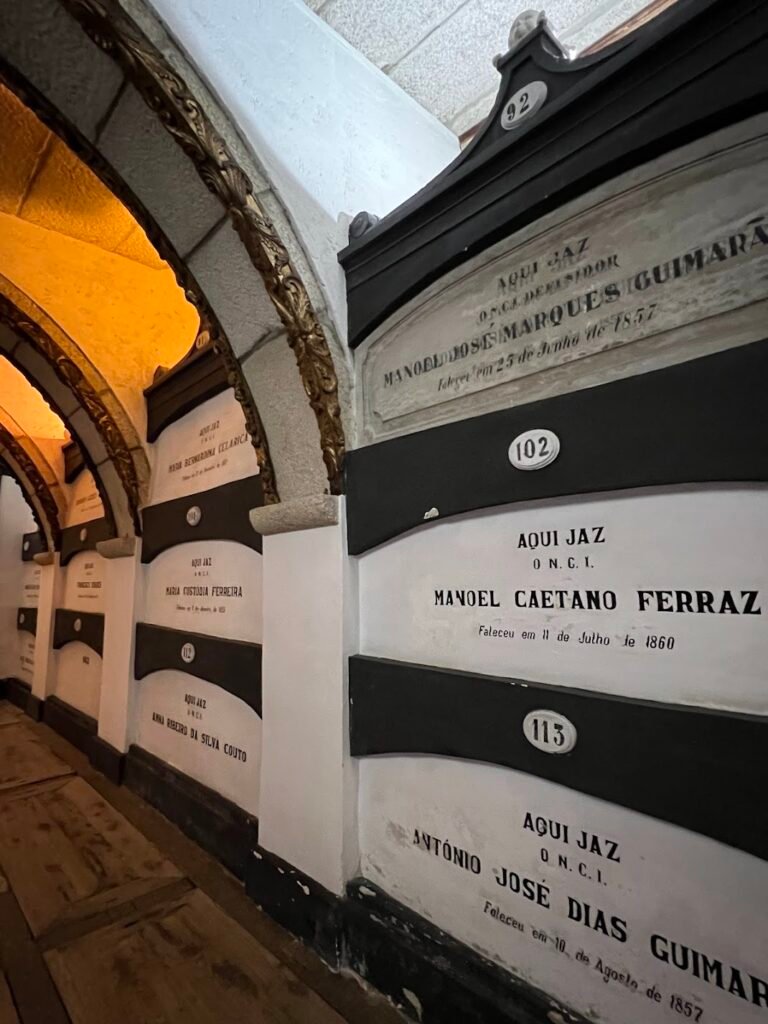
Need to Know
- Hours: Generally open daily at least 9am-7pm, but times vary seasonally so check the website for current hours.
- Tickets: We paid EUR 11/pp for admission to the church and catacombs. We bought tickets on site, payable via card or cash.
- Pro tip!: We recommend purchasing the explanatory pamphlet for EUR 1 extra which provides information on what you’ll see inside the church. There was scant information available once inside the church and the information that was there was all in Portuguese.
City Viewpoints
We couldn’t get enough of the views in Porto, especially those up high that provided a panorama including the river. While we think the view from the Clérigos Tower was the best, there are some other (free) vantage points we think are worth visiting as you walk through the city. You can enter any of these locations into Google maps to find the location.
- Porto Cathedral: Directly in front of the Porto Cathedral’s main entrance lies a square called Terreiro da Sé. Perched on a hill, this terrace provides fantastic views.
- Miradouro da Vitória: This viewpoint is high enough to afford views of the river and all the terra cotta roofs below.
- Luís I Bridge: This bridge is a double-decker metal arch bridge that connects the cities of Porto and Vila Nova de Gaia. We used this bridge to cross the river twice, walking across both the upper and lower levels. We think the top level has better views, but both were fun.
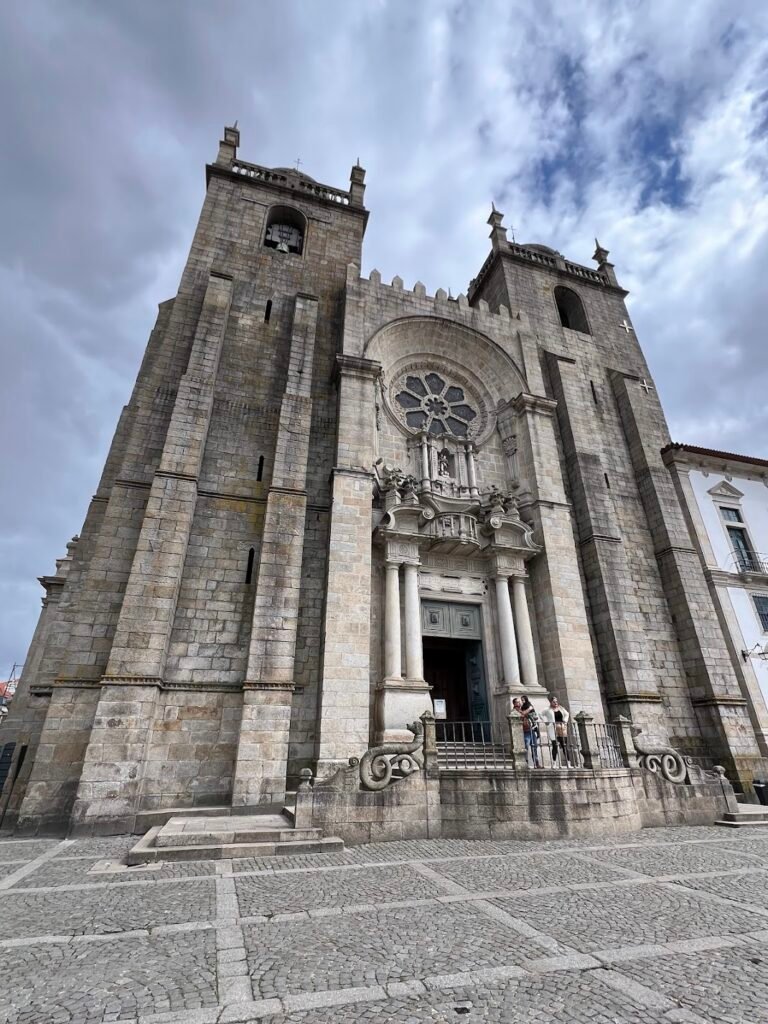
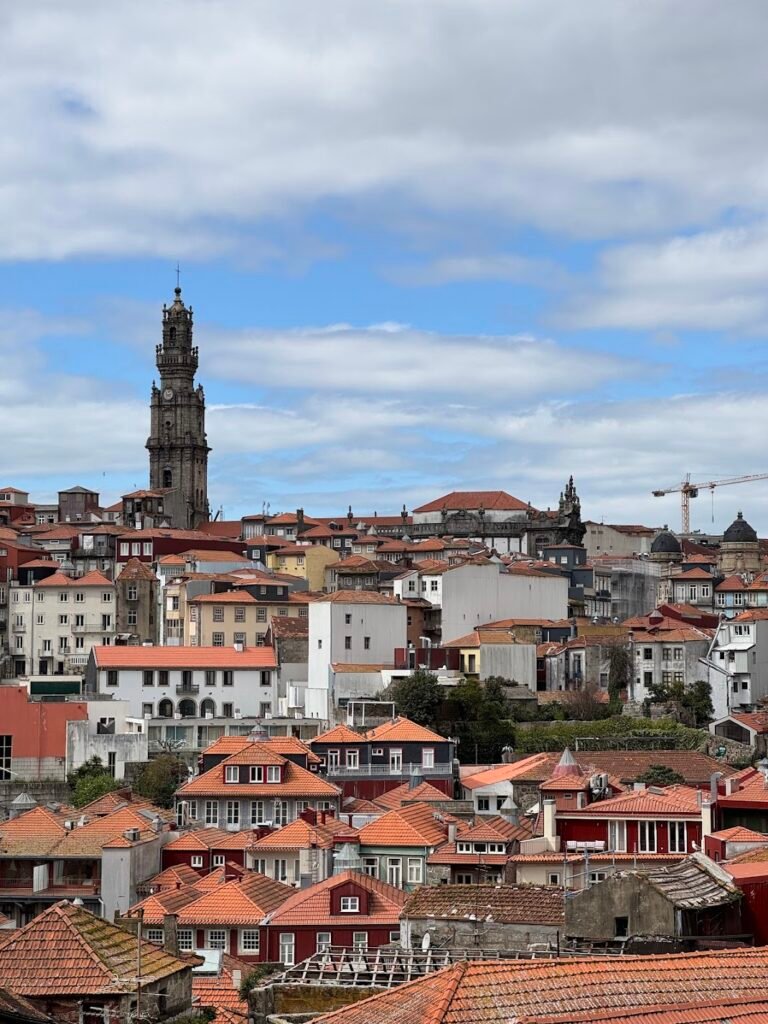
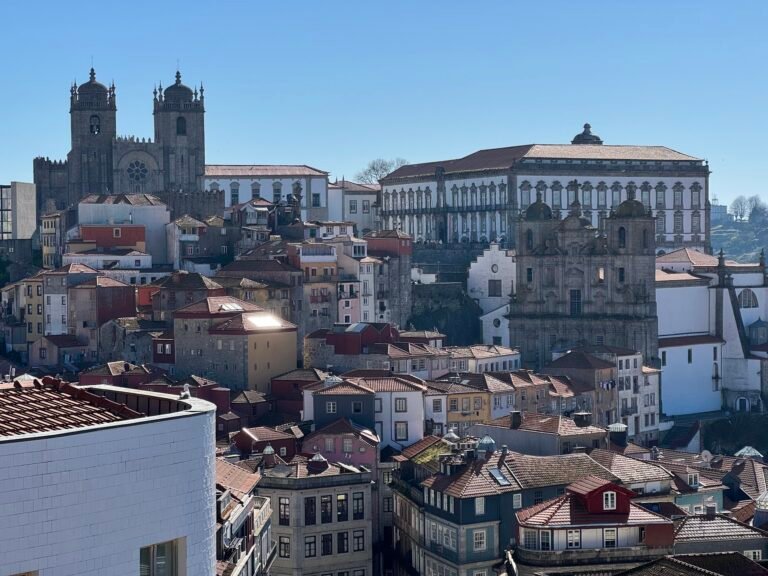

Tastings at Port Houses
While grapes for port wine are mostly grown in the nearby Douro Valley, the barreled wine is aged in port wine house cellars dotting the banks of the Douro River in Vila Nova de Gaia.
To get to our first tasting location, we walked from Porto across the upper level of the Luís I Bridge. For fun, we took the Gaia Cable Car from the Jardim do Morro station located just at the end of the bridge. We paid EUR 7 each for the one-way ride. Not only did this save us some walking, but it was fun to skim over the rooftops of all the port houses below. You can find information about pricing and the timetable on their website.
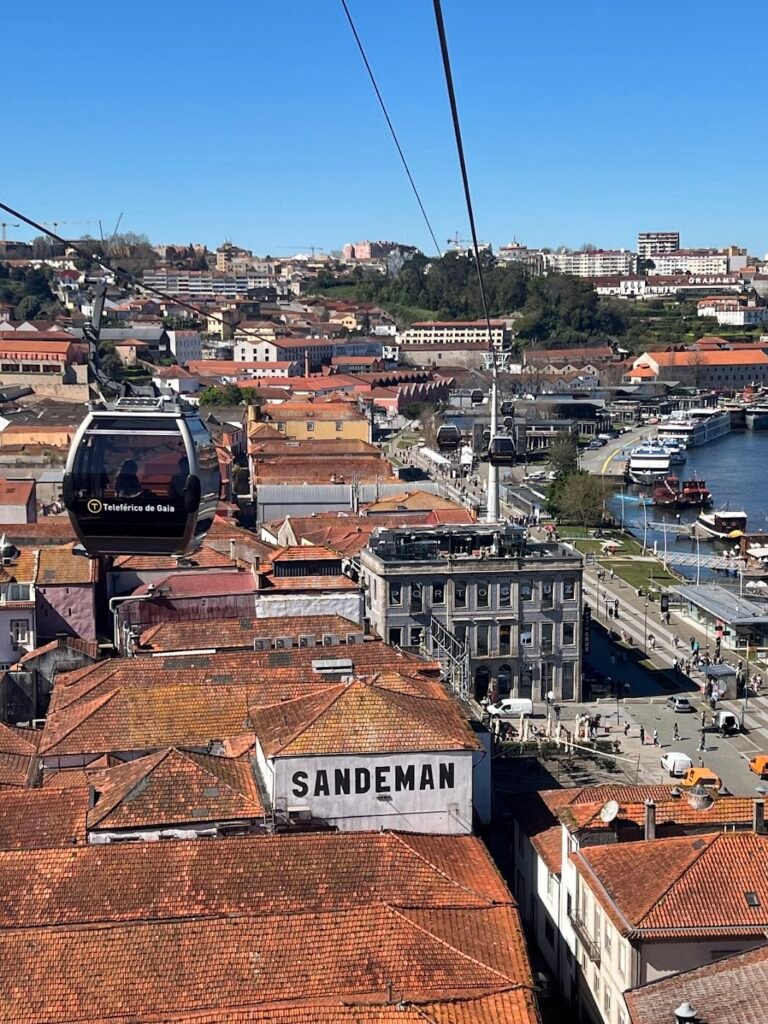

Taylor’s
While researching the best port houses to visit, Taylor’s repeatedly came up as home to a well-rounded tour and tasting. No reservations are necessary for their self-guided audio tour and tasting of three port wines, for which we paid EUR 25/pp.
The hour-long tour consisted of a succinct explanation of the port-making process including the growing process of the grapes in the Douro Valley. We also got to walk though the barrel aging room which smelled divine. Taylor’s has been in business since 1692, so the museum with historical artifacts and photographs was really interesting and helped round out our knowledge.
After the tour we enjoyed tastings of white, tawny, and LBV (Late Bottled Vintage) ports on the outdoor terrace. We couldn’t think of a better place to start our port journey than Taylor’s!
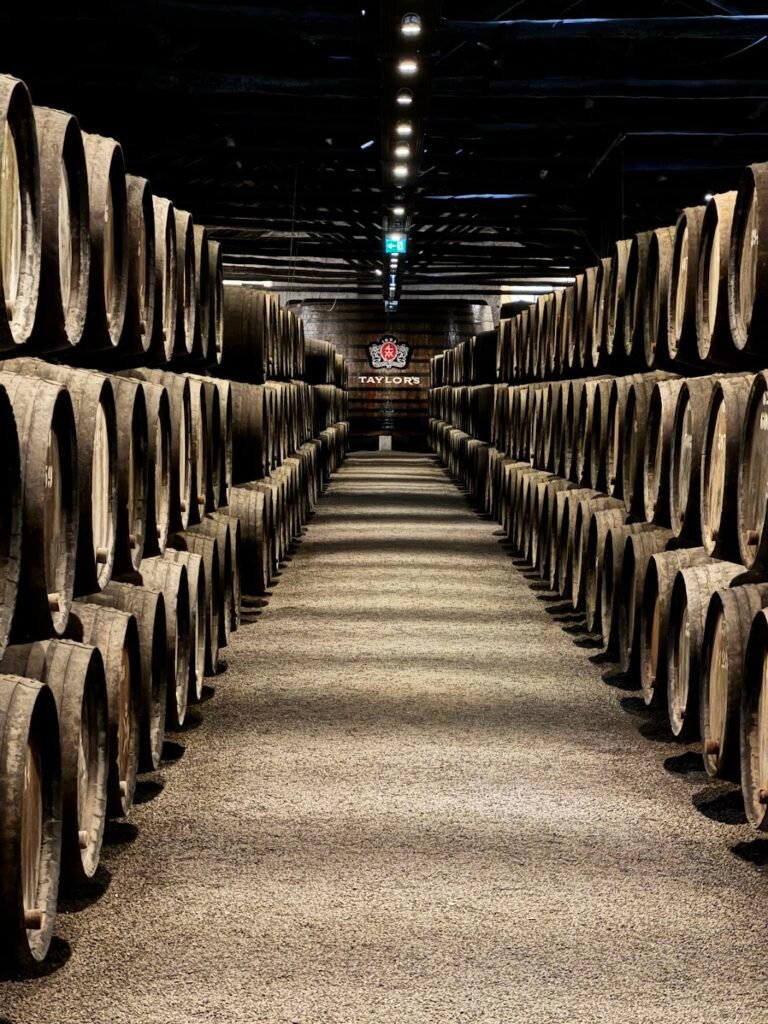
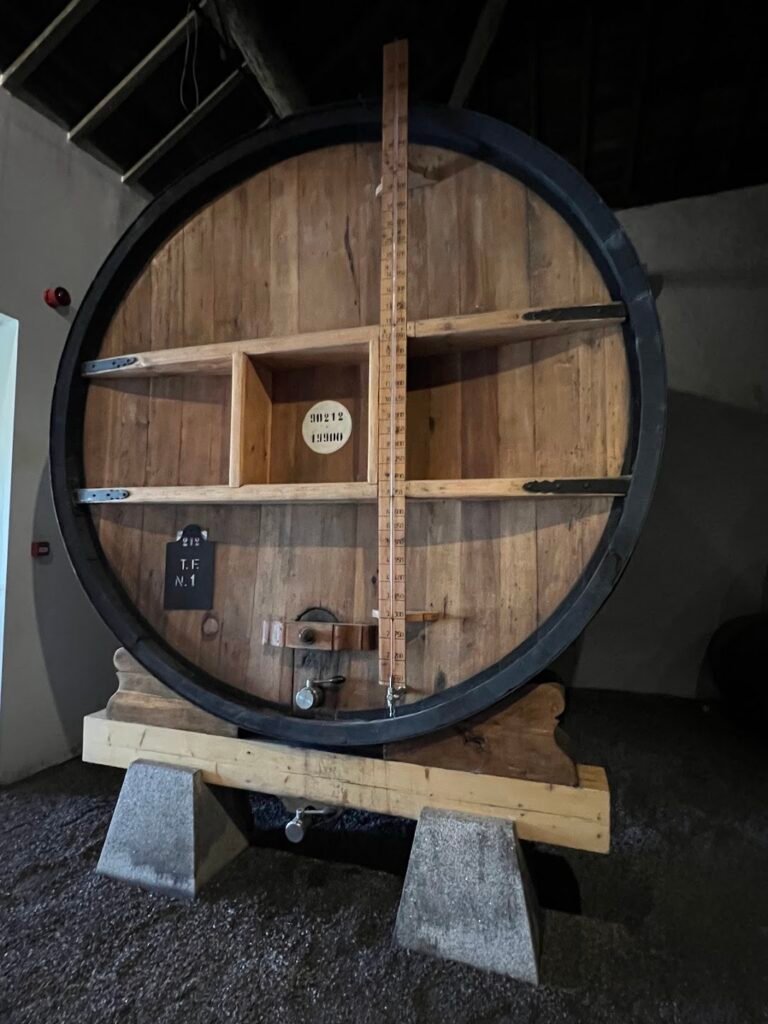
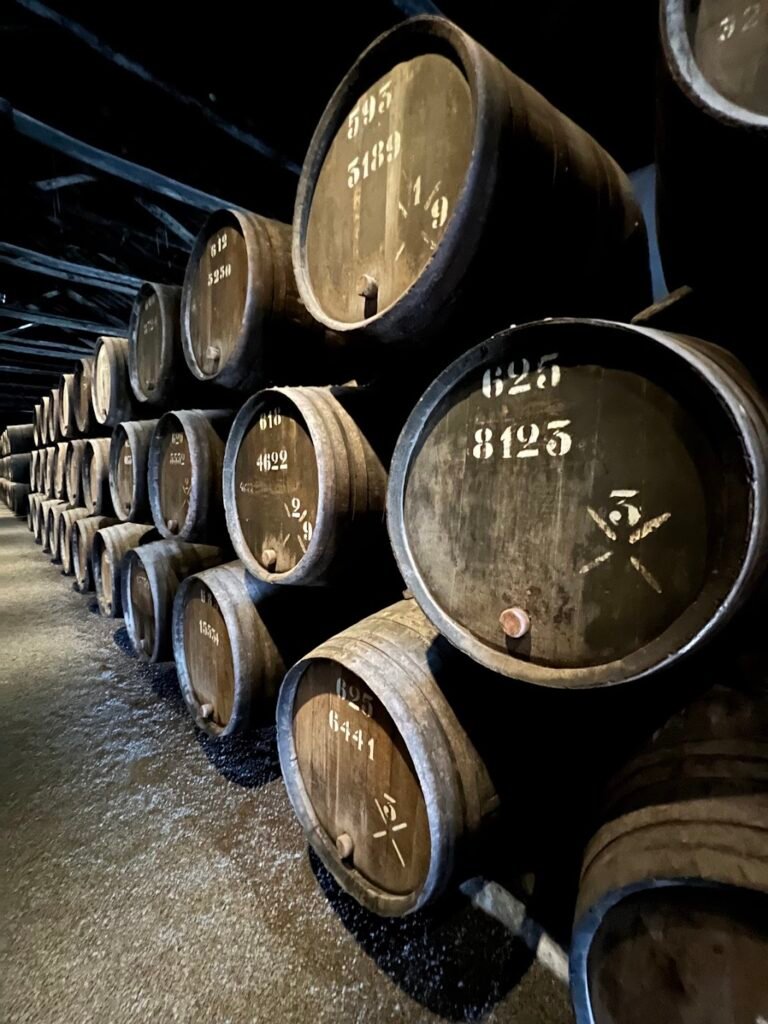
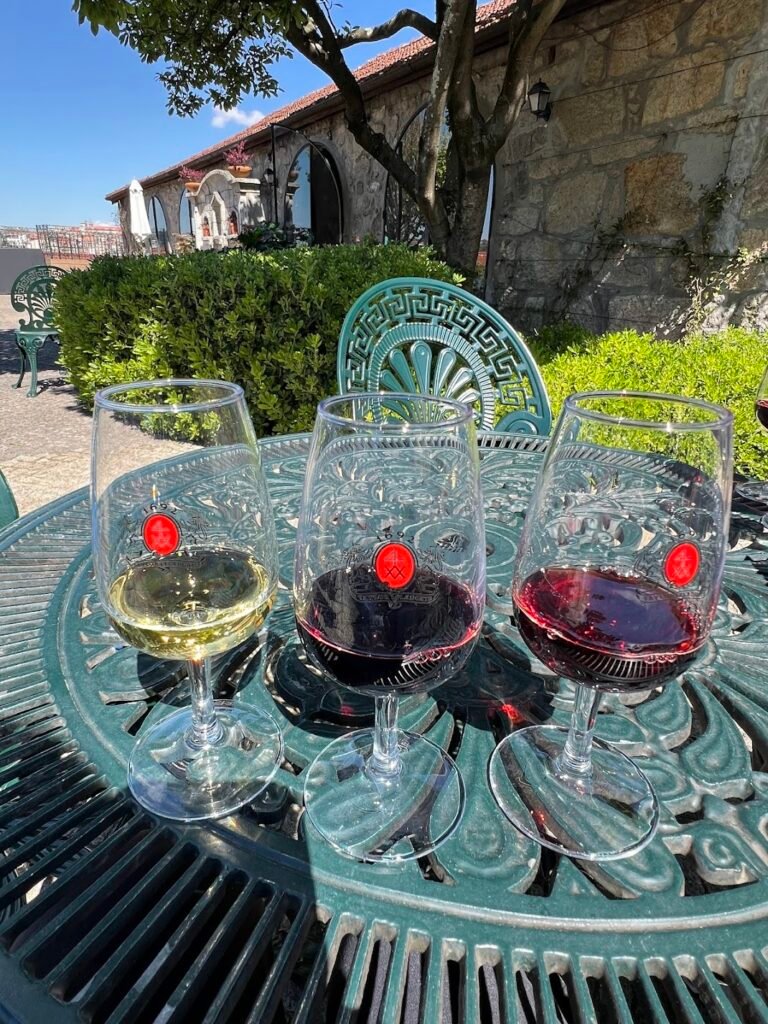
Lunch
Near the waterfront is a great food hall called Mercado Beira-Rio. It was like a less hectic version of the Time Out Market we went to in Lisbon. We had sandwiches and sweet potato chips from the stall Piadina Mia. Later in the afternoon we also stopped at the gelato stall in the market for amazing coconut, pistachio, and caramel milk cream gelato.
If you have the time, the waterfront promenade is a beautiful place to walk around.

Augusto’s
Augusto’s is one of the very few completely Portuguese-owned port cellars, making them our top choice for a second tour and tasting. Due to the small size, we made a reservation in advance online. You pay EUR 5/pp to make your reservation with the remaining EUR 10/pp paid upon arrival. If you pay in cash, you get EUR 10 towards any purchase made post-tour.
As the port cellar is very small (Augusto’s produces only 30,000 bottles a year) the tour was just 15 minutes long. After, we got to taste a 6 and 8 year port (our choice of red or white) and an LBV from 2019. We also purchased a tasting of their 20 year tawny port to try something different. We liked the 8 year old port so much we purchased a bottle to take home.
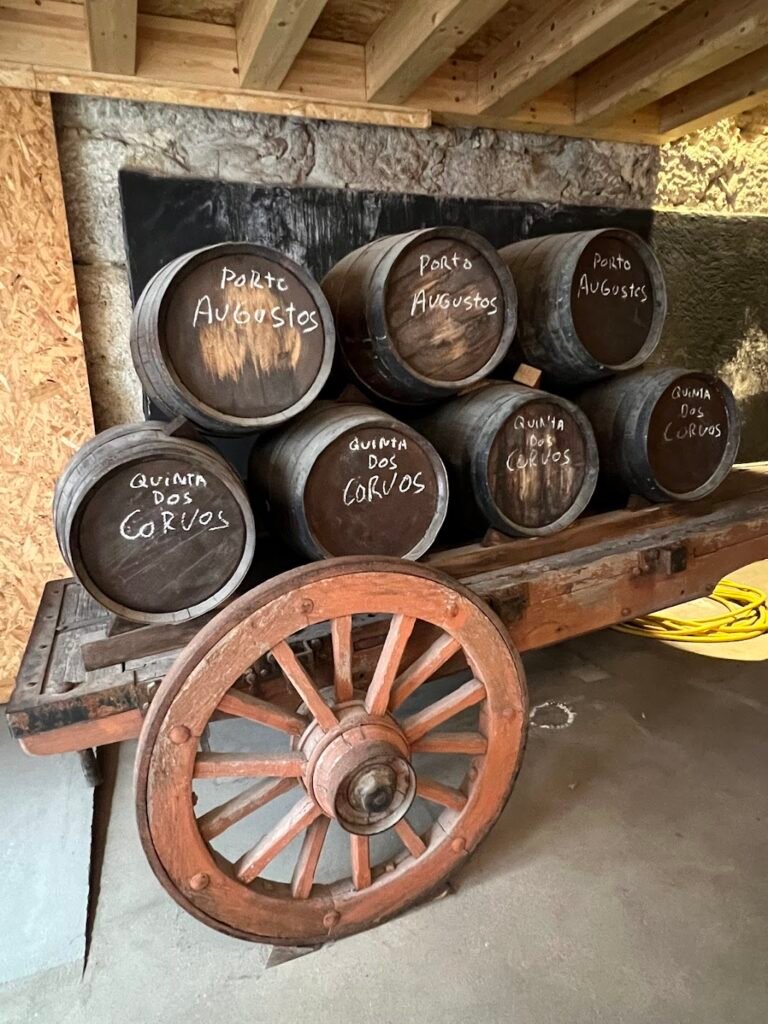
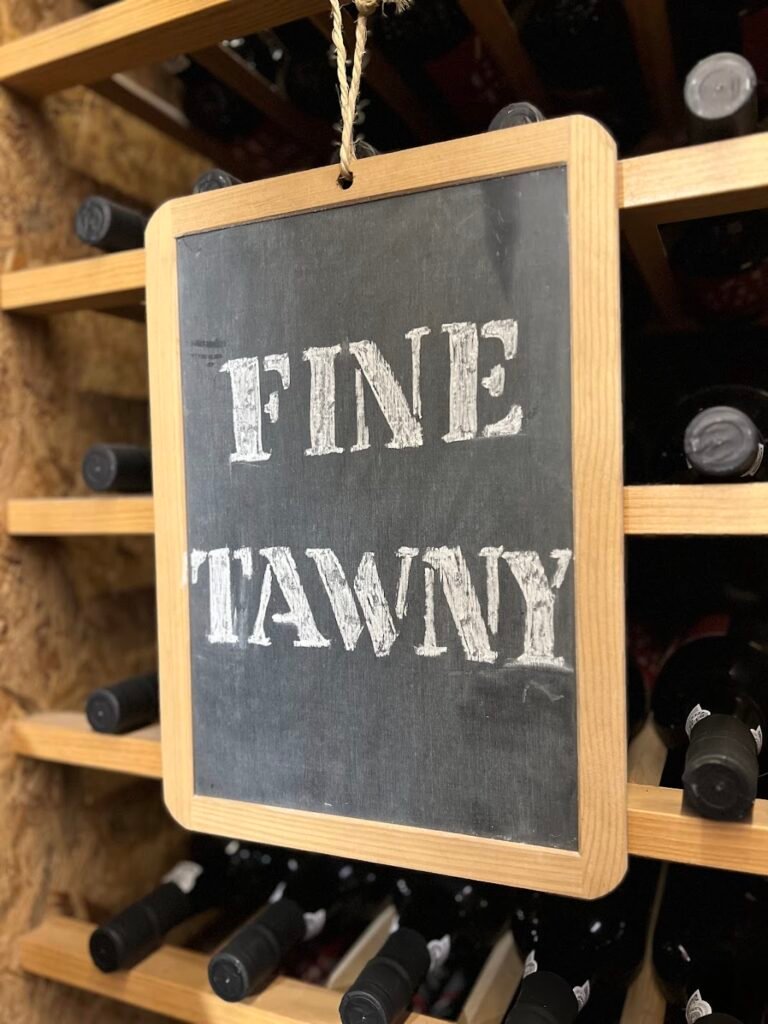
Dinner
Just around the corner from our Airbnb was the restaurant Chama. The concept is a surprise tasting menu and reservations are essential.
Our honest review is that the food was delicious and the tasting menu and wine were priced very affordably. However, the seating was uncomfortable and in very close quarters with fellow diners. The music, while fun (think Snoop Dog), was too loud at times and the wait staff was often aloof with patrons, so it wasn’t our favorite vibe. We had really high hopes for this meal but enjoyed others on our trip more. Back to the star, the food! Our eight courses consisted of:
- Bread with paprika butter, cream cheese, and olives
- Fish soup with mackerel, croutons, and pico de gallo (broth was ladled tableside)
- Alheira croquettes (meatball style from Northern Portugal)
- Beef shoulder tacos
- Shot of grappa with homemade honey
- Shrimp curry with crispy garlic rice
- Pork ribs with crispy fries, broccolini, and tomato
- Lime sorbet with amazing warm pastry tart


Day 5|Porto: Douro Valley Tour
The Douro Valley is a UNESCO World Heritage Site known for its lush, green valleys teeming with terraced vineyards. We were eager to round out our understanding (and tastings!) of wine from Portugal by visiting its most famous wine region. We joined this small group tour from Porto and although it was a very long day, it was one of the best and most memorable of our trip.
Our day began with a pickup near our Airbnb at 8:30am where we met our guide and six other guests. Along the way to the Douro, we made a brief stop in Amarante. In addition to using the toilets, we had a few minutes to admire the picturesque arched bridge spanning the Tâmega River and the nearby church.
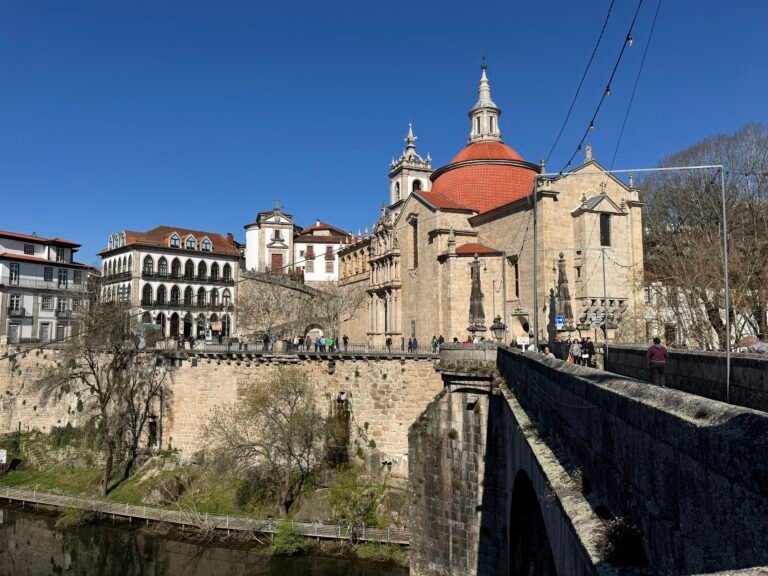
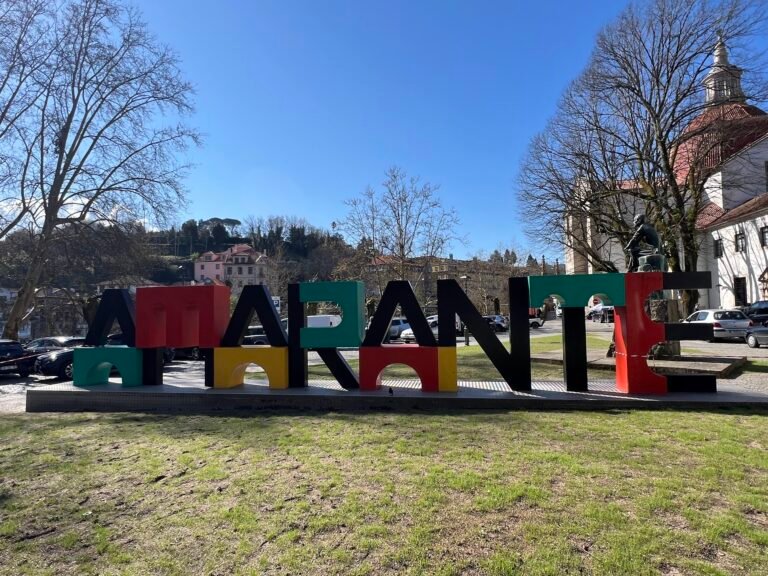
The drive into the valley was jaw-dropping and unlike anything we’ve ever seen. We were so happy our guide was able to pull off at a viewpoint so we could snag some photos.
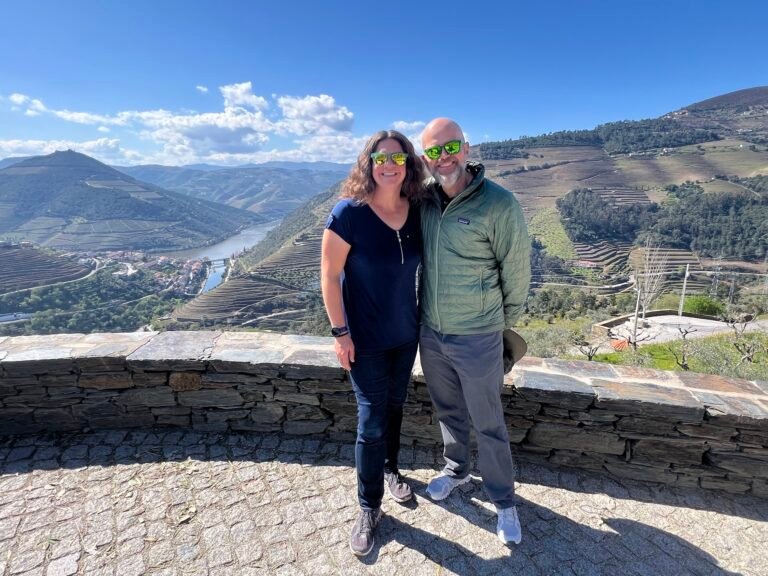
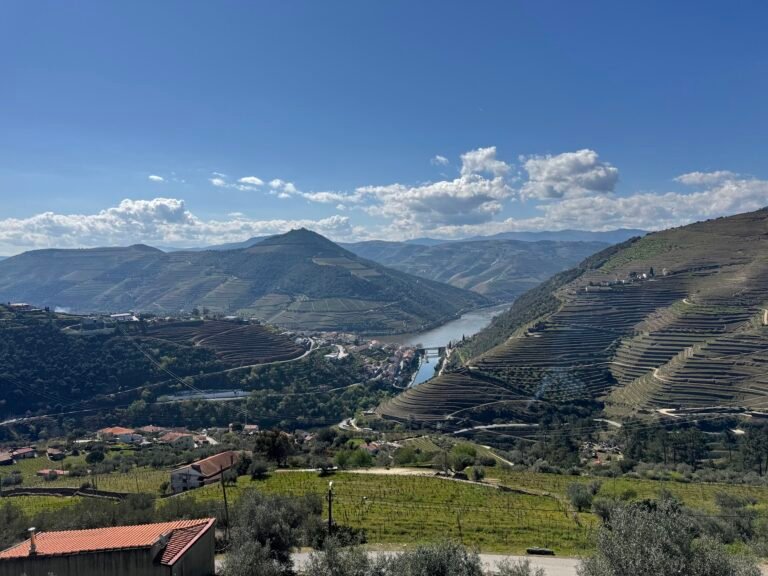
We made our way down a very windy road to the Douro River in Pinhão where we climbed aboard a small boat for an 11am hour long river cruise. Motoring by the terraces and seeing the vineyards from below was such a unique perspective. We were happy to have fantastic weather making the boat ride that much more enjoyable. We even had a port toast to celebrate, which felt extra special because it was a homemade port wine not produced by a company, but a local family.
At the conclusion of our boat tour, we drove a short way to Croft. Their estate, Quinta da Roêda, made for a wonderful experience where we were given a tour in the vineyard. We then sat on the terrace to sample a white, ruby, and tawny port.
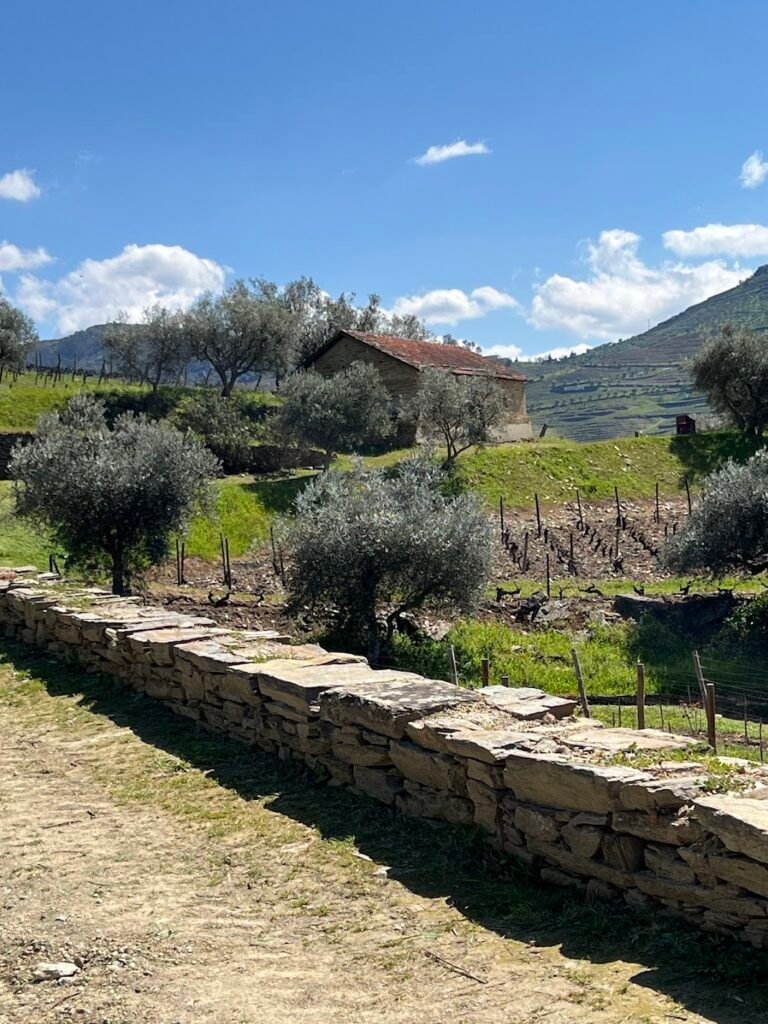
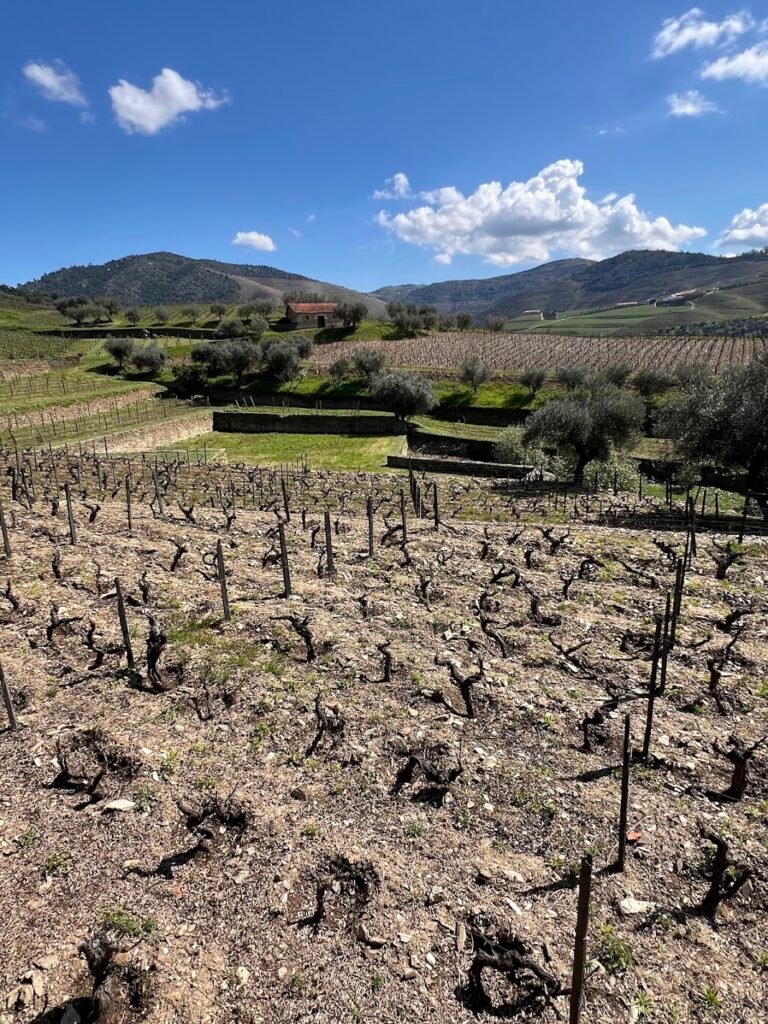
Our last stop of the day was at the small, family run estate Quinta de Santa Júlia. Situated on one of the oldest properties in the Douro, this was such a special experience. Our group was the only one there and we had an amazing lunch of bean and meat stew with rice and a slice of cake, accompanied by our choice of red or white win. We ate IN the kitchen and could watch it being prepared.
We then had a quick tour of the property (the views were to die for!) and finished with a tasting of their 22 year old vintage port. This was the best port we tasted on our trip.
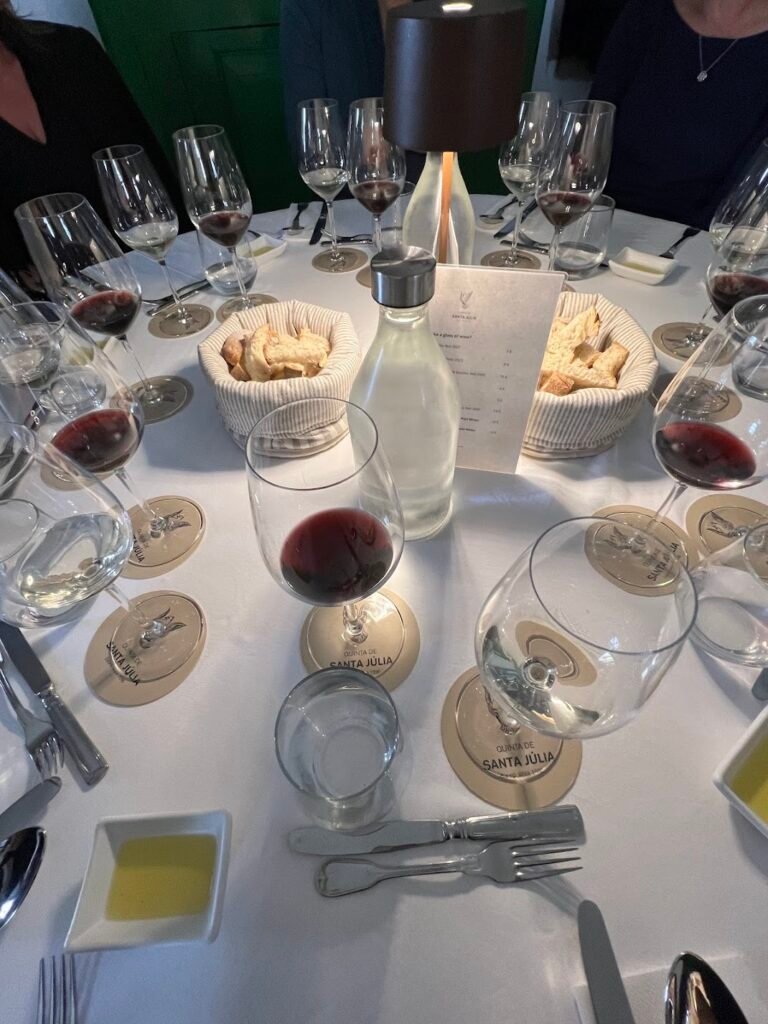

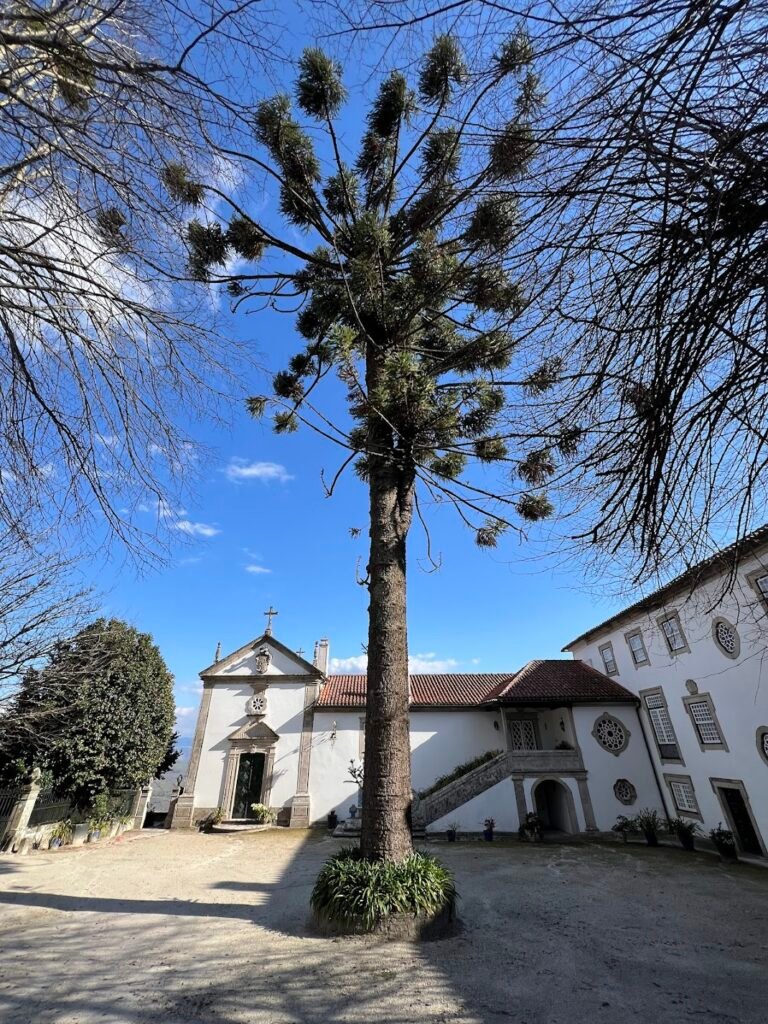
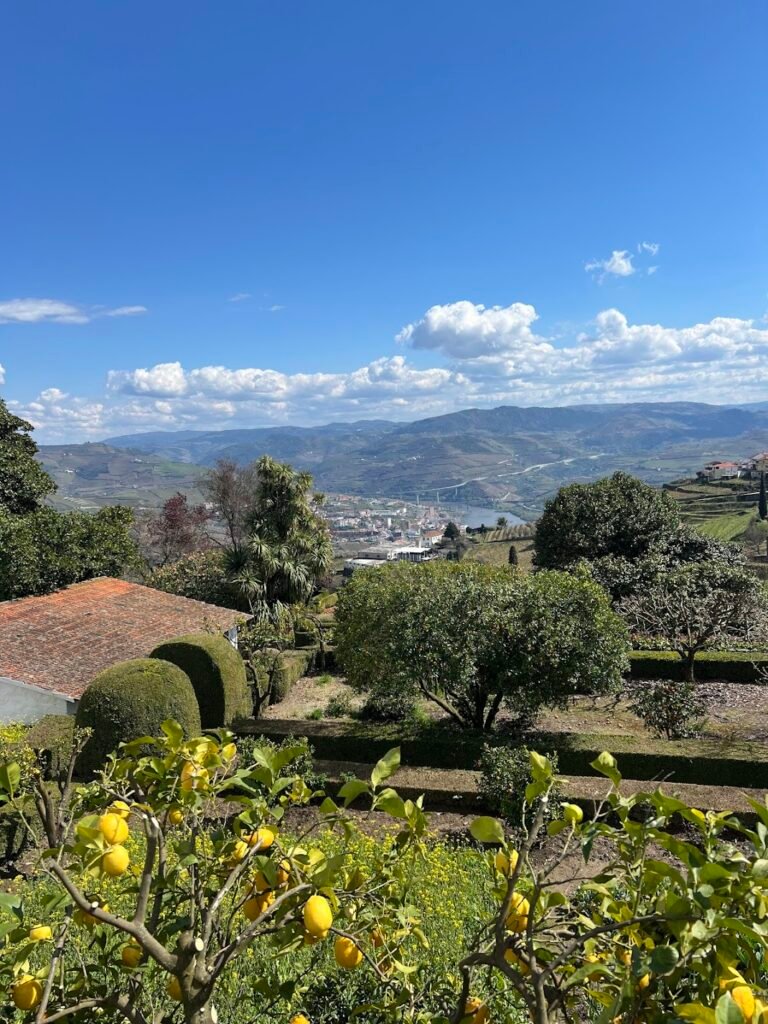
After our tasting, we piled into the van for the nearly 2-hour drive back to Porto, arriving just after 6pm. We would not hesitate to recommend this day tour. Our only advice would be to bring some snacks because lunch is not served until quite late and there aren’t opportunities to purchase anything along the day.
Dinner
We had dinner at the super fun restaurant Tapabento. Located inside the São Bento train station, this was a unique dining experience next to the railway tracks. Reservations are absolutely essential. We had a 7pm booking (the first seating of the night) and when we arrived the line, even if you had reservations, was out the door just to check in!
We finally got to try a port & tonic, a delicious local cocktail of dry, white port wine + tonic. We shared Alheira (sausage) croquettes, tiger prawn risotto, and duck. We were in and out pretty quickly, but really enjoyed the food and the lively atmosphere.
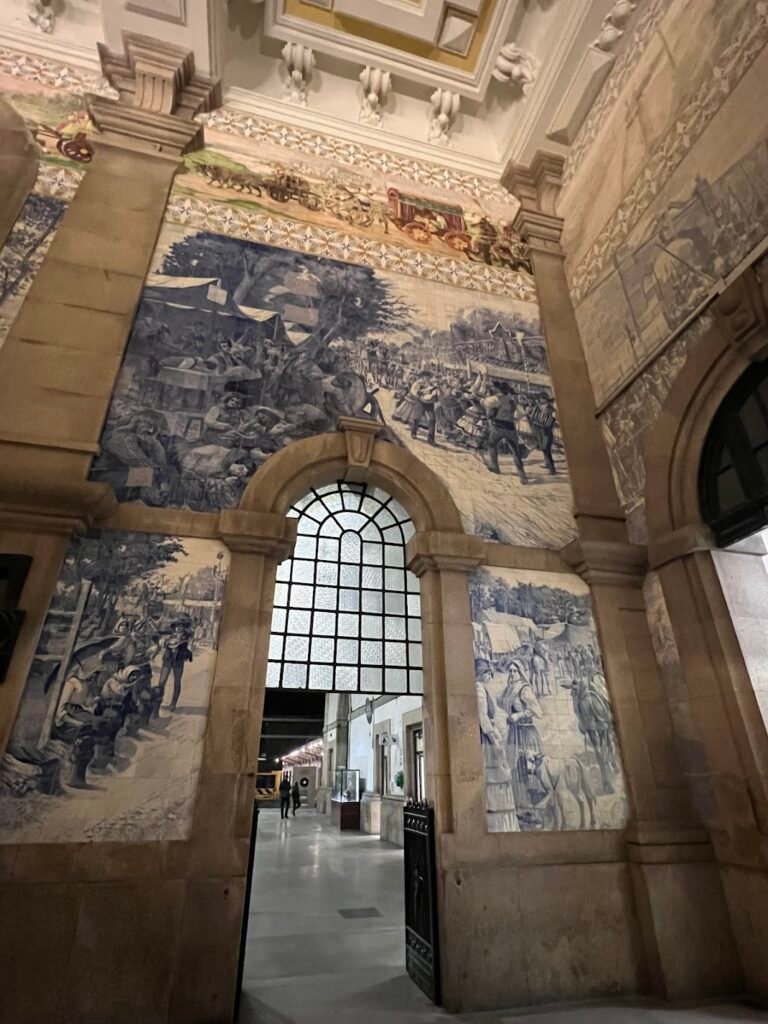



Day 6|Travel to the Algarve
A note on today’s itinerary: Our plans had us renting a car and driving from Porto to the Algarve because we wanted to visit the Arouca 516 Suspension Bridge, the world’s longest pedestrian suspension bridge. The bridge, which spans the Paiva River, is connected to the Paiva Walkways, a 5-mile series of boardwalk trails hugging the river. Unfortunately the storms struck again and the boardwalks were damaged, closing the walk when we were due to visit. The operator was very quick to offer a refund which was much appreciated and we want to visit in the future.
Instead, we picked up our rental car and stopped in the town of Nazaré on our way to Portugal. We were really happy with our choice but if we had the chance to re-do this portion of our trip, we would have simply flown to the Algarve (or taken a train) and rented a car once there. The tolled highways are great, but fees can really add up. Driving the 6 hours from Porto to Lagos, and 2.5 hours from Lagos back to Lisbon at the end of our trip cost nearly EUR 100 in tolls!
Nazaré
Nazaré is a coastal town most famous for the colossal waves that grace its shores during the winter months. While we visited during a relatively calm day of seas at the end of March, this was still a great town to explore for a few hours. It took us about 2 hours to drive here from Porto.
Fort of São Miguel Arcanjo
This fort is built on top of cliffs and is surrounded by the sea on three sides. If you’ve seen famous pictures of the towering waves in Nazaré then you’ve probably seen the fort with its notable red lighthouse. The fort’s terrace affords wonderful views of the sea below and is also home to the Big Wave Museum. There is an exhibit explaining why such large waves form here and surfboards from historic rides throughout the years, along with interesting information about the records.
At only EUR 2/pp to enter, the museum and fort are well worth a visit. To get here, we parked our car on the street (for free) in the Sítio neighborhood and walked about 15 minutes down the paved path.
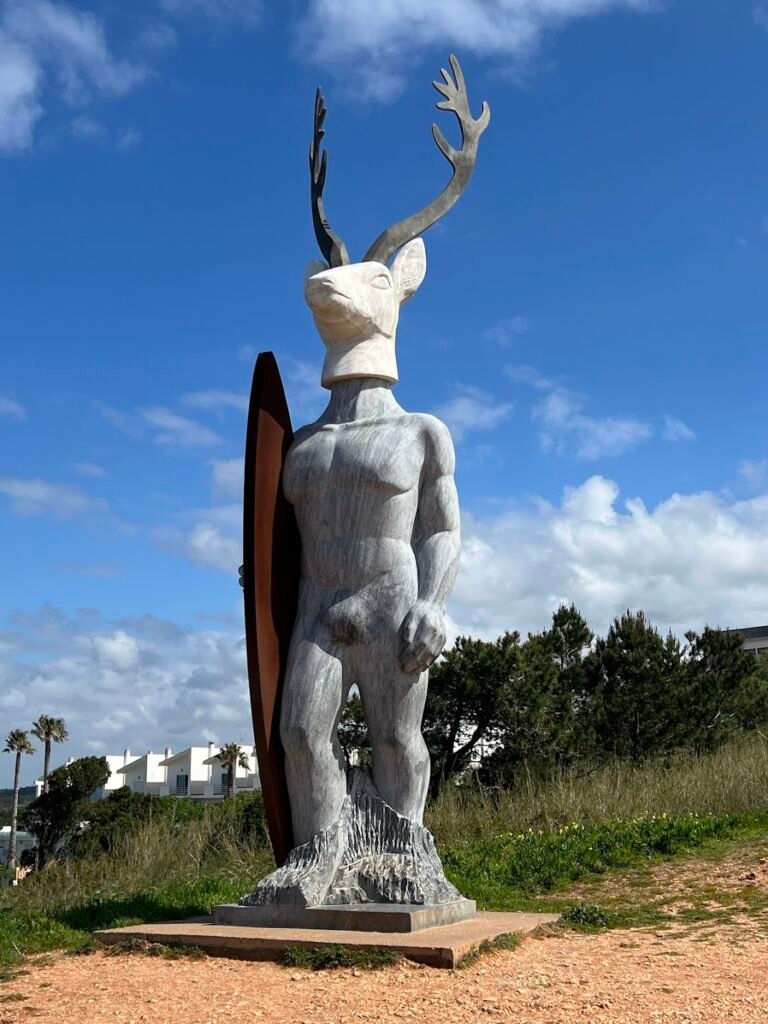
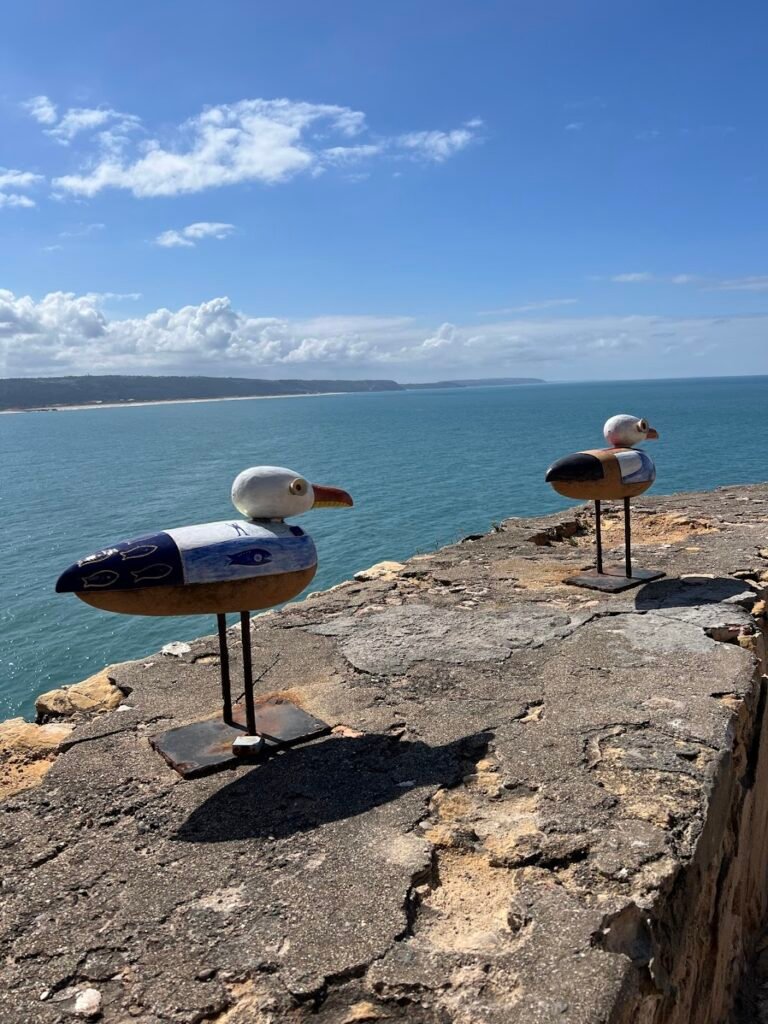
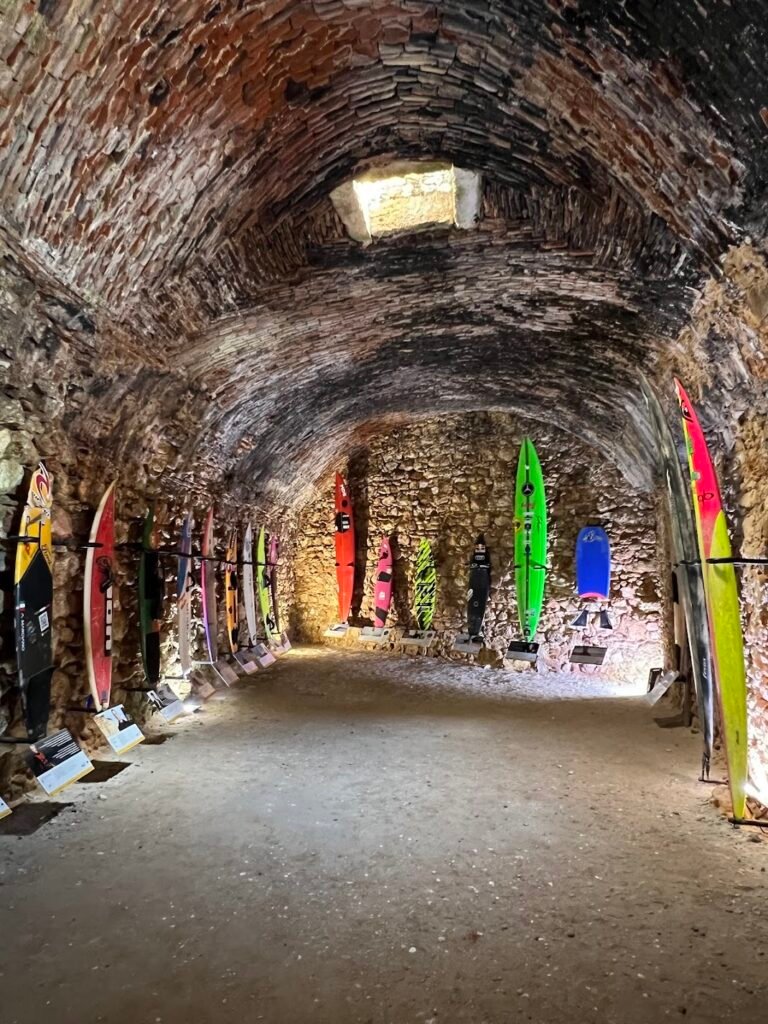
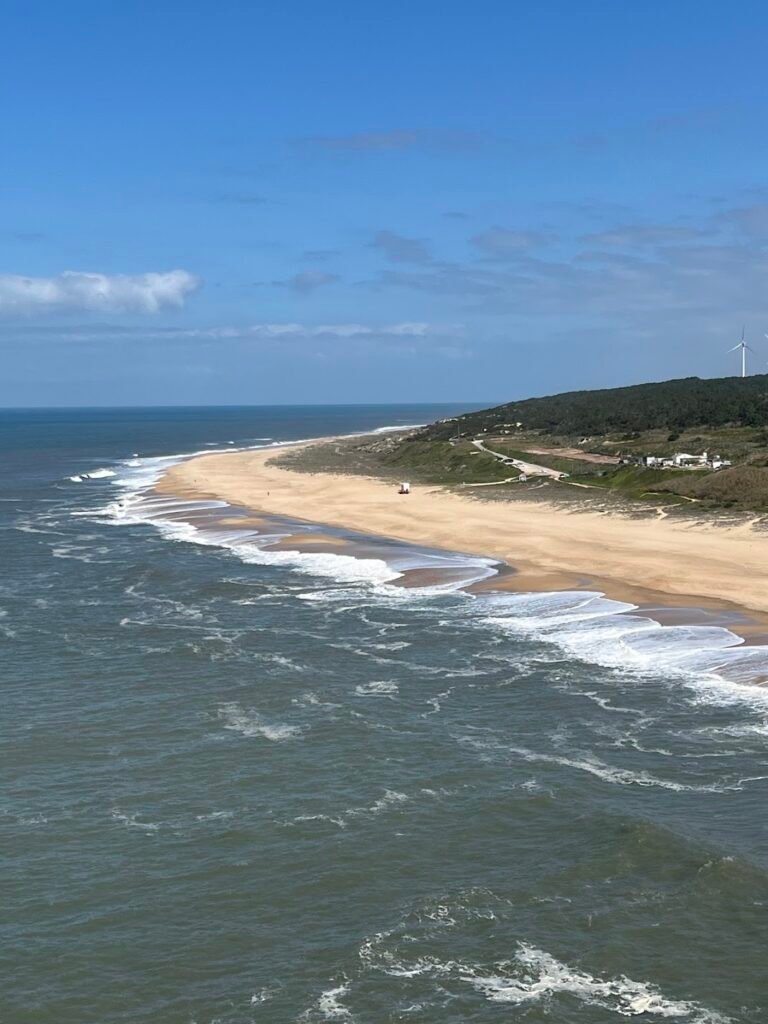
Just past the fort to the right there are sandy paths leading down to the beach below. We walked about halfway down and stopped at a viewpoint to see the waves crashing below.
Lunch at Casa Pires
Casa Pires is a restaurant best known for its grilled sardines and other fresh seafood. We had wanted to try more than just tinned sardines while in Portugal and this was the perfect place to do so! We ordered grilled sardines and octopus rice. Everything was delicious and Mike was a master at picking his sardines clean to the bone! Me, not so much.
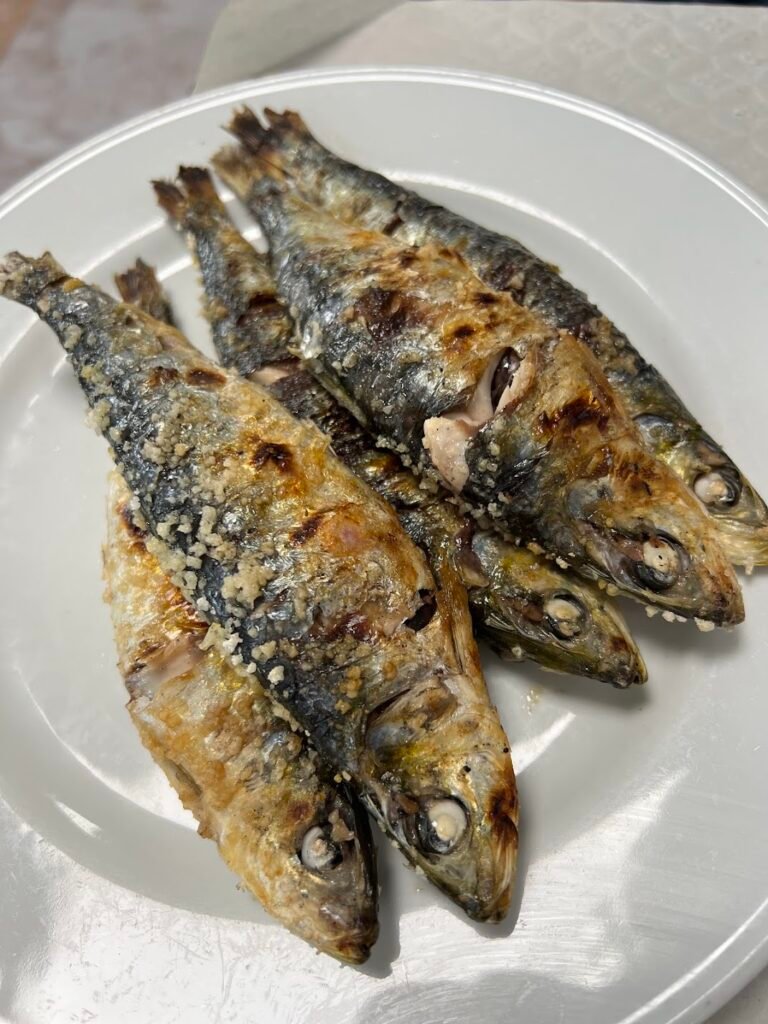
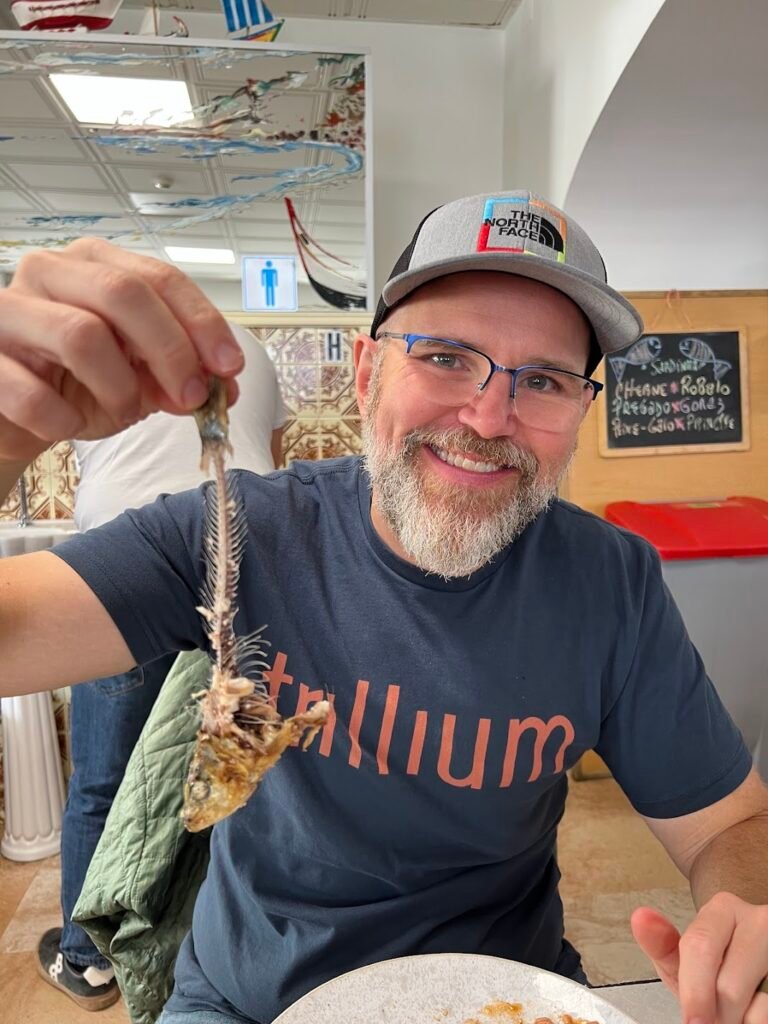
With a long drive ahead of us, we left Nazaré after lunch but there is a lot more to explore if you want to make a full day of it. In particular, the Praia area is located along the beach. Here there are a ton of restaurants, an open-air boat museum, and a dried fish museum. The two neighborhoods are connected by a funicular if you’d like to leave your car in one place.
Lagos
From Nazaré it took us about 4 hours to drive to Lagos, our base for our time in the Algarve. We chose Lagos primarily because it was a good midway point between the Algarve towns of Sagres to the west and Faro to the east. It was very easy to hop on the highway system and explore the many towns dotting the coastline. We were really happy with our choice of location.
Where we Stayed
We stayed at a spacious Airbnb just outside the walls of the Old Town (we could see them from our windows). Old Town is where most of the shops and restaurants are located, but we could easily walk anywhere we wanted within Lagos, even to the waterfront, in about 15 minutes. Our Airbnb had free, designated parking in an underground garage and a well-equipped kitchen so we grocery shopped and ate most of our dinners there.
Day 7|Algarve: Hiking & Boat Tour
Lagoa | Seven Hanging Valleys Trail
The Seven Hanging Valleys Trail is a stunning coastline walk featuring dramatic cliffs, sea arches, and golden sandy beaches. The path mainly skirts the tops of the cliffs and begins at Marinha Beach and ends at Carvalho Beach. If you complete the full hike it is about 8 miles out-and-back.
We went about 3.2 miles and then turned back as we were running short on time, but this was the perfect length for us and this hike was one of our favorite activities in Portugal. We began at 8am and saw virtually no other hikers on the first half of our hike, but by the end it was very crowded. There are multiple free parking lots along the trail, including where we started near Marinha Beach. If you wanted to just walk one way, taking an Uber back to the start is an option.
Our hike lasted around 3 hours, with lots of photo stops. The trailhead was a 45-minute drive from our Airbnb in Lagos.
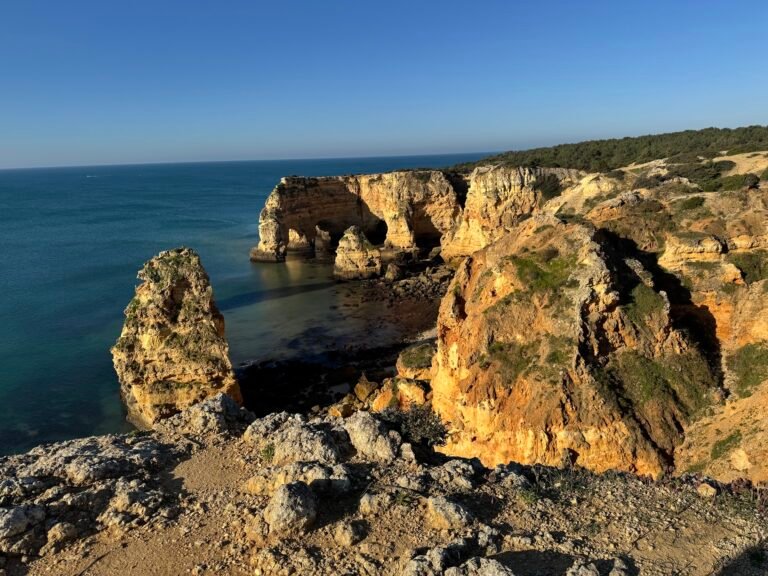
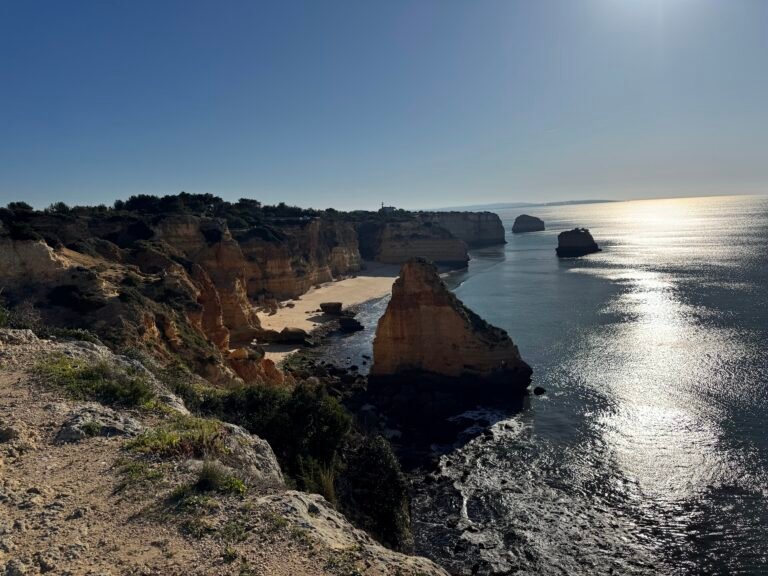
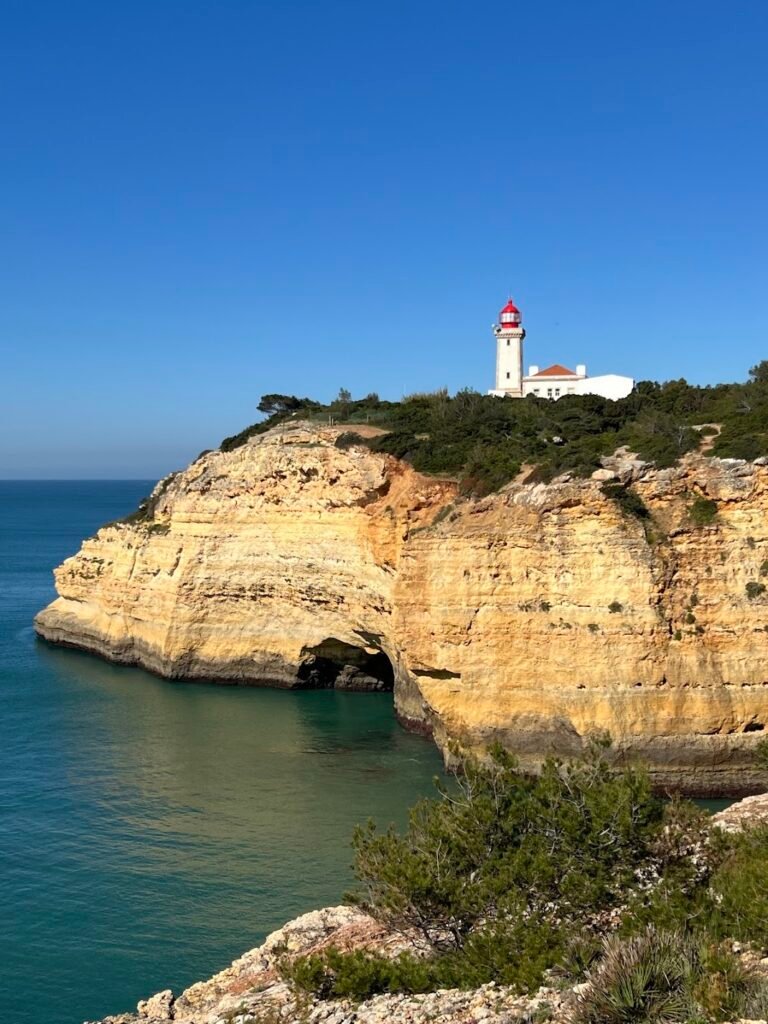
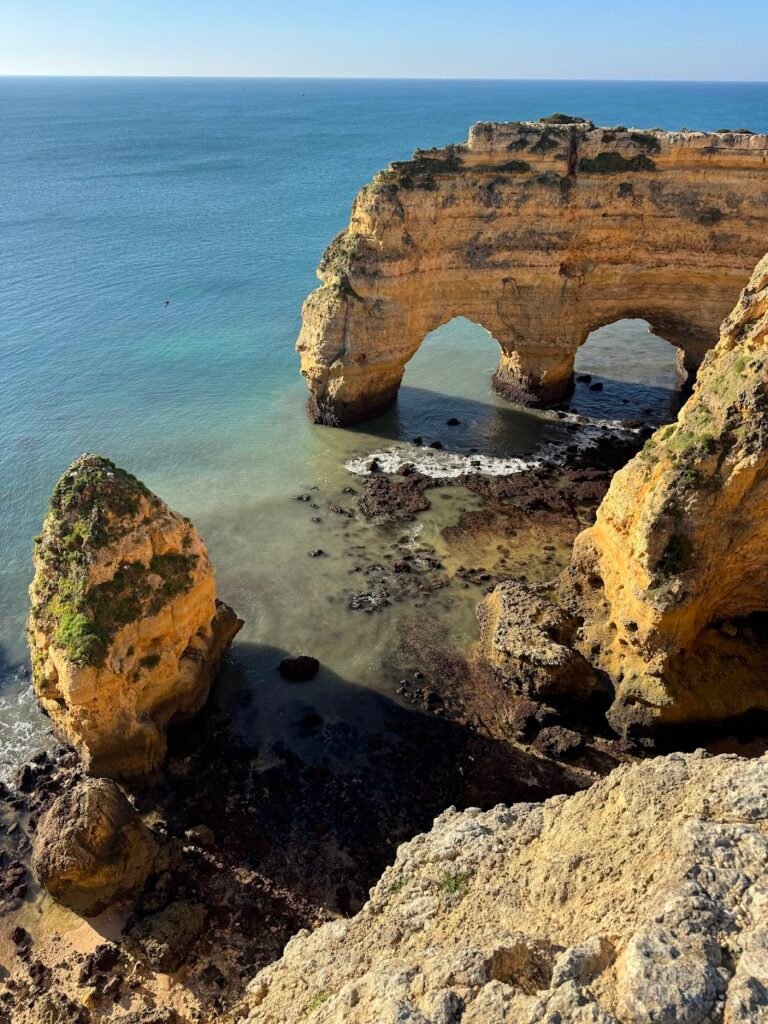
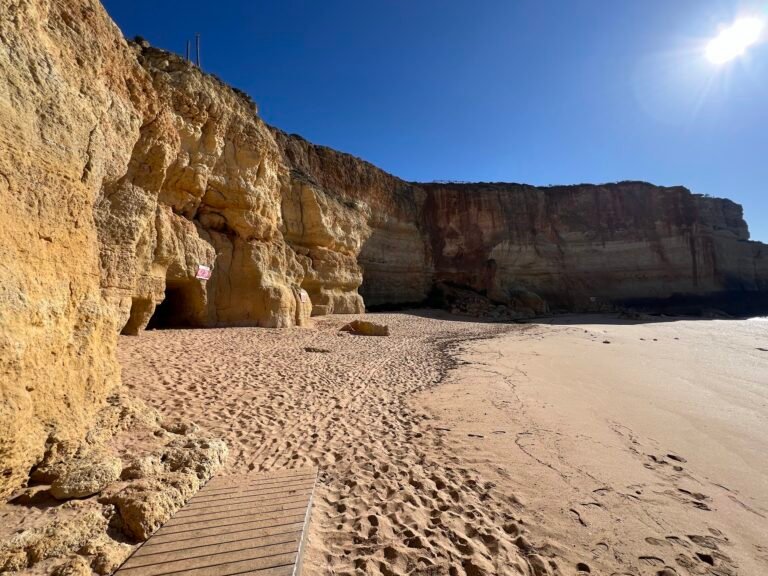
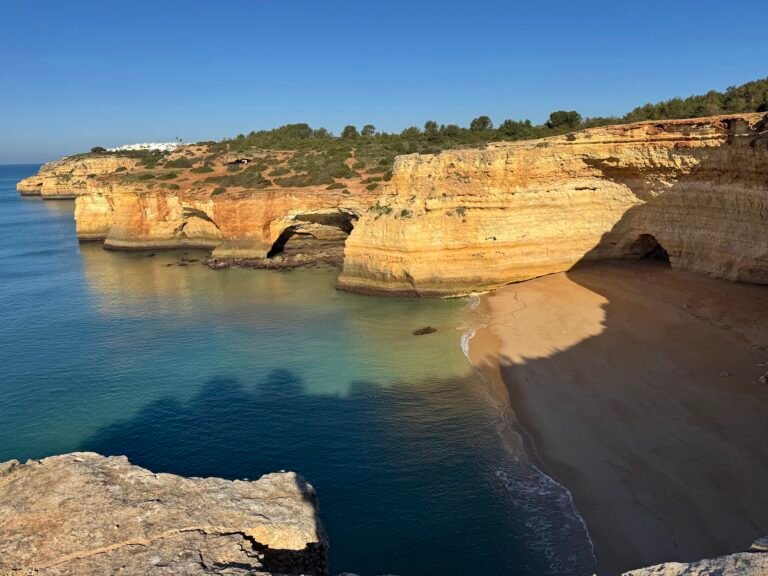
Portimão | Lunch
From the Seven Hanging Valleys trailhead, we drove about 30 minutes to Portimão and had delightful cubano sandwiches for lunch at Café Creme. We were the only non-locals eating there and the food was delicious and very affordable.
Portimão | Caves Circuit and Coast Sightseeing Boat Tour
We love seeing the same place from different perspectives, so we booked an afternoon boat tour of the coast. Our afternoon boat tour went into the caves and under the arches we had just walked past in the morning! The views were fantastic and a real highlight of this tour was entering Benagil Cave. Having been eroded from both the side and the top, boats can enter and venture directly under the opening in the ceiling. When we visited the sunlight streaming through brightened up the whole grotto and made it colorful.
Our boat was a small RIB holding 8 other passengers and our tour lasted about 1.5 hours.


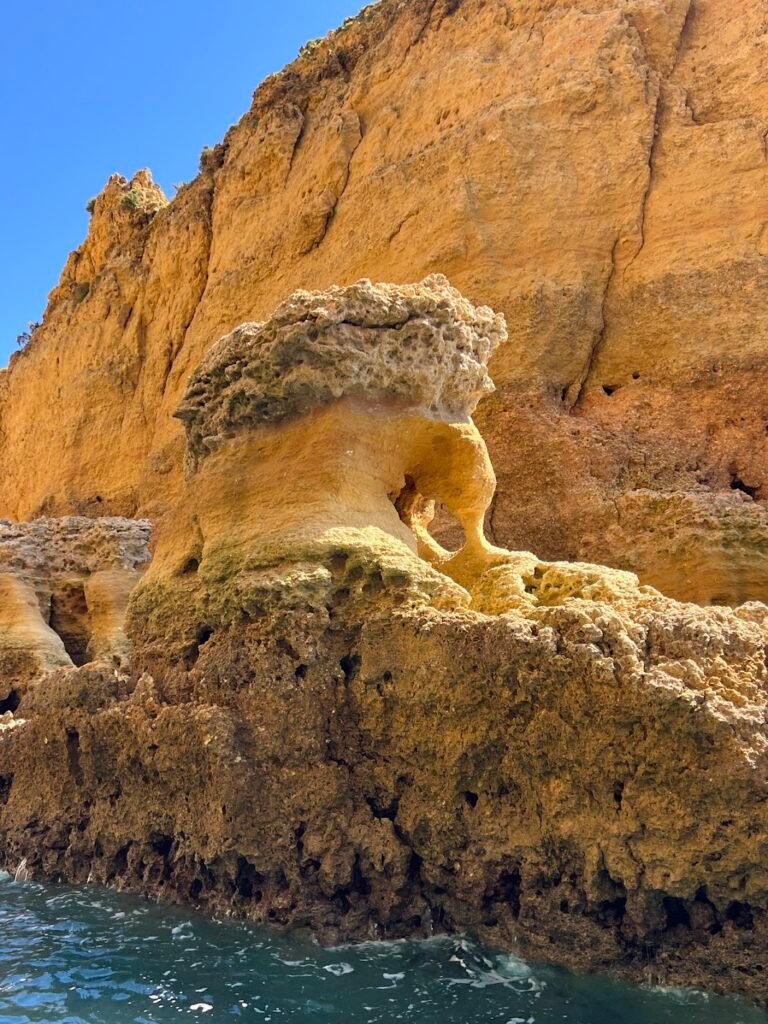
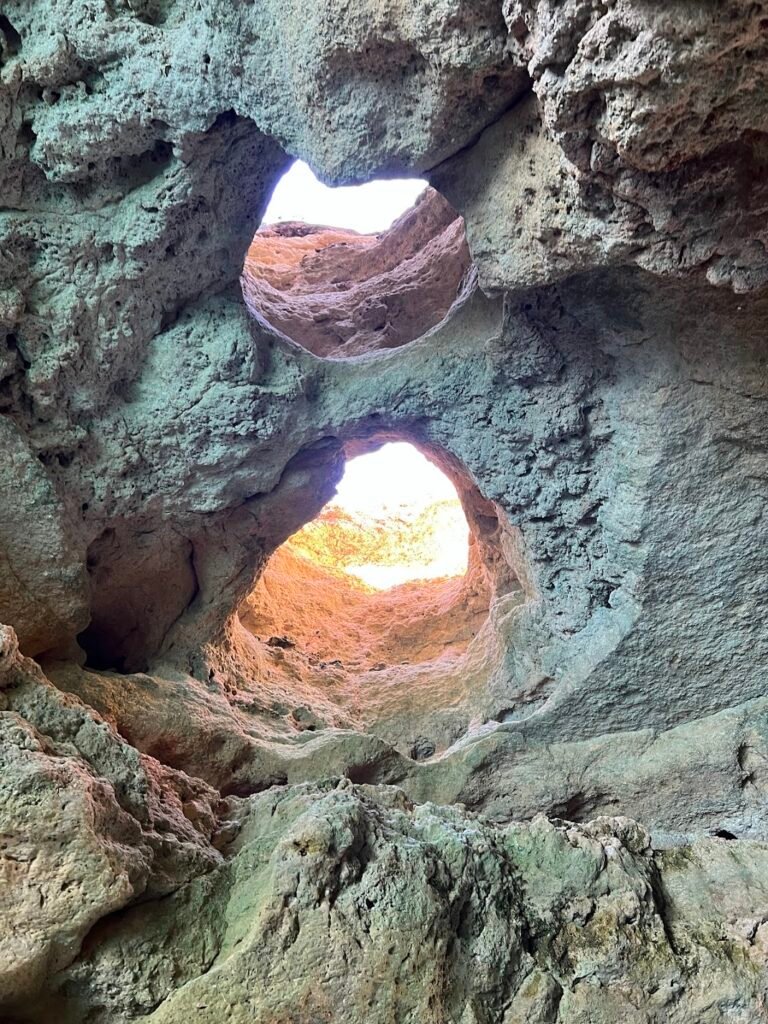
Need to Know
- Tours: There are many companies offering boat tours but we went with Atlantis Tours based on the positive reviews. We paid EUR 35/pp.
- Our Experience: We were very happy with the tour itself. Atlantis Tours provided clear instructions with lots of pictures on how to get to the meeting point, which is not very intuitive. We did try to reach them multiple times to ask if we could change our tour time but never received any response. It all ended up working out in the end but communication/responsiveness could have been better.
Portimão | Cookies
Craving a sweet, on our way out of town we stopped at Le French Cookie. We purchased red velvet and triple chocolate cookies with vanilla ice cream and WOW! The entire dessert was amazing and if we were staying closer, we definitely would have been back for more cookies.
Carvoeiro | Algar Seco
Our last stop of the day was a 25-minute drive away to the town of Carvoeiro to explore Algar Seco. This is an otherworldly collection of rocks, grottoes, and caves lying below the Carvoeiro Boardwalk Trail. This was another highlight for us in the Algarve, so don’t miss this one!
We recommend starting along the boardwalk trail and then turning off and taking the stairs down to the beaches and grottos wherever you see them. There aren’t signs, but this is part of the fun. You never know what amazing features will be just around the corner.
We parked at the free parking area next to the beach labeled “Estacionamento do Algar Seco” on Google maps and spent about an hour exploring.
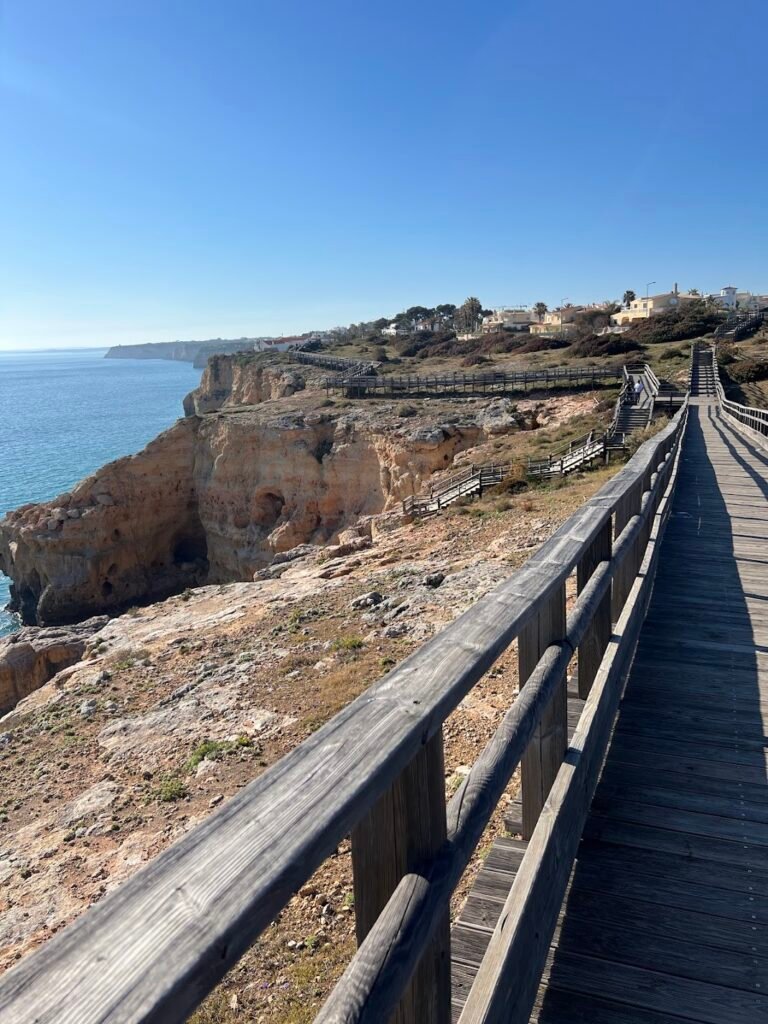
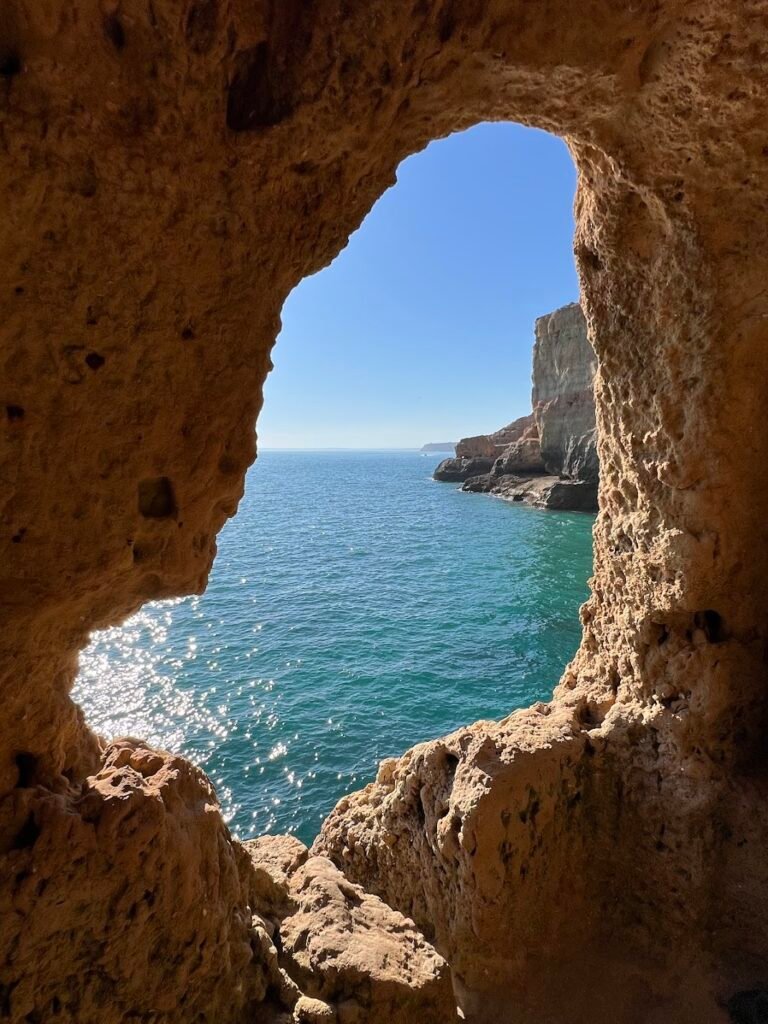
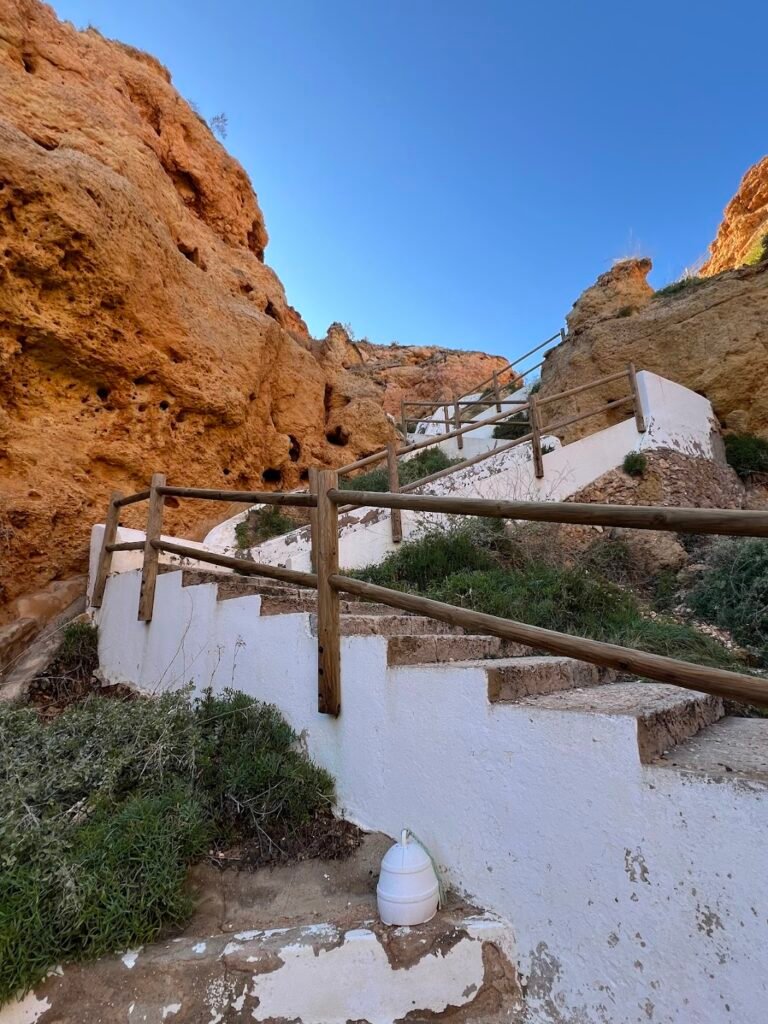
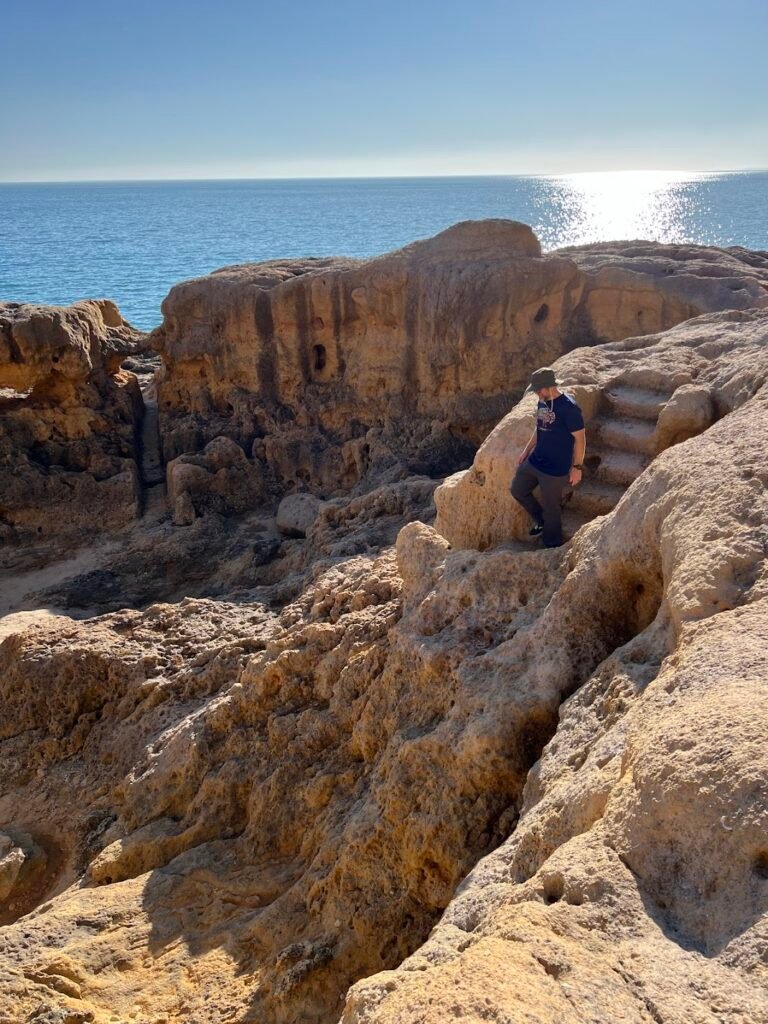
Day 8|Algarve: Hiking & Boat Tour
Lagos | Ponta da Piedade Trail
If you’re staying in Lagos, a walk along the boardwalk trail to Ponta da Piedade is something not to be missed. We began our hike at the Praia de Dona Ana viewpoint where there was a small sign near the parking lot marking the trailhead. We walked to the start from our Airbnb, but the nearby parking lot was free.
Most of the trail follows a series of boardwalks which take you to the Ponta da Piedade Lighthouse at the cape of Ponta da Piedade. Just as with the hike we did the prior day, the rock formations and arches were jaw-dropping. We recommend going down to the beach via the sets of stairs wherever you see them! We promise it’s worth the extra effort to explore down below.
Although the trail extends even further around the cape, we turned back after reaching the lighthouse. All told we walked 3.1 miles and it took about 1.5 hours. We went down the stairs to two different beaches and took lots of pictures along the way.
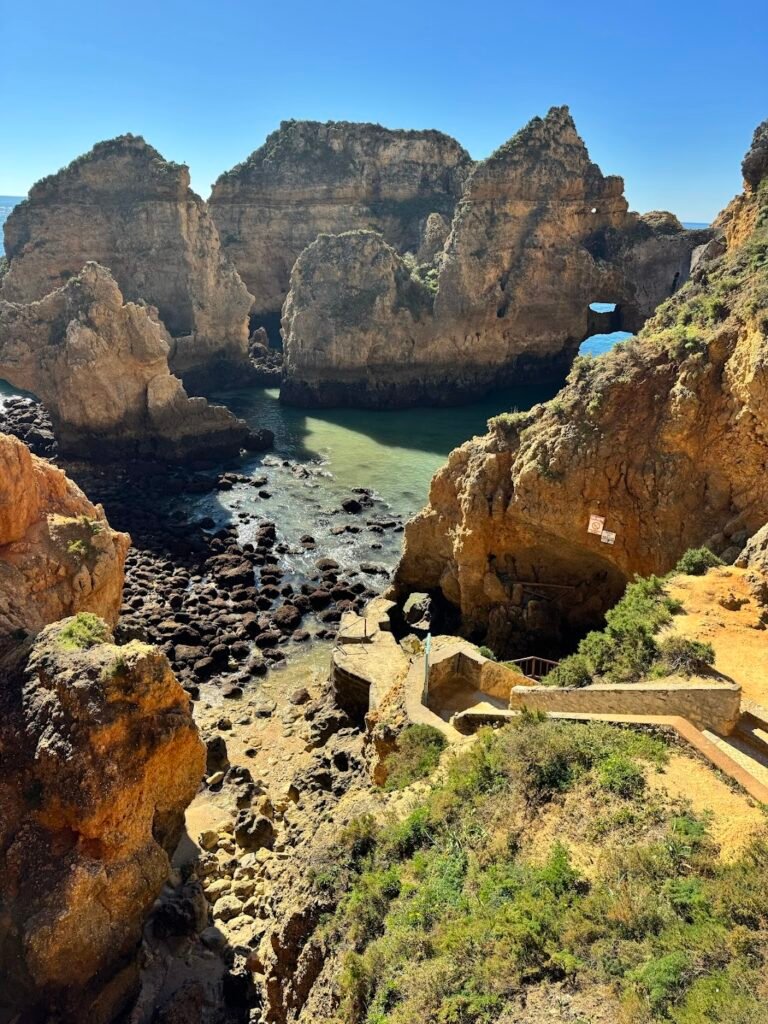
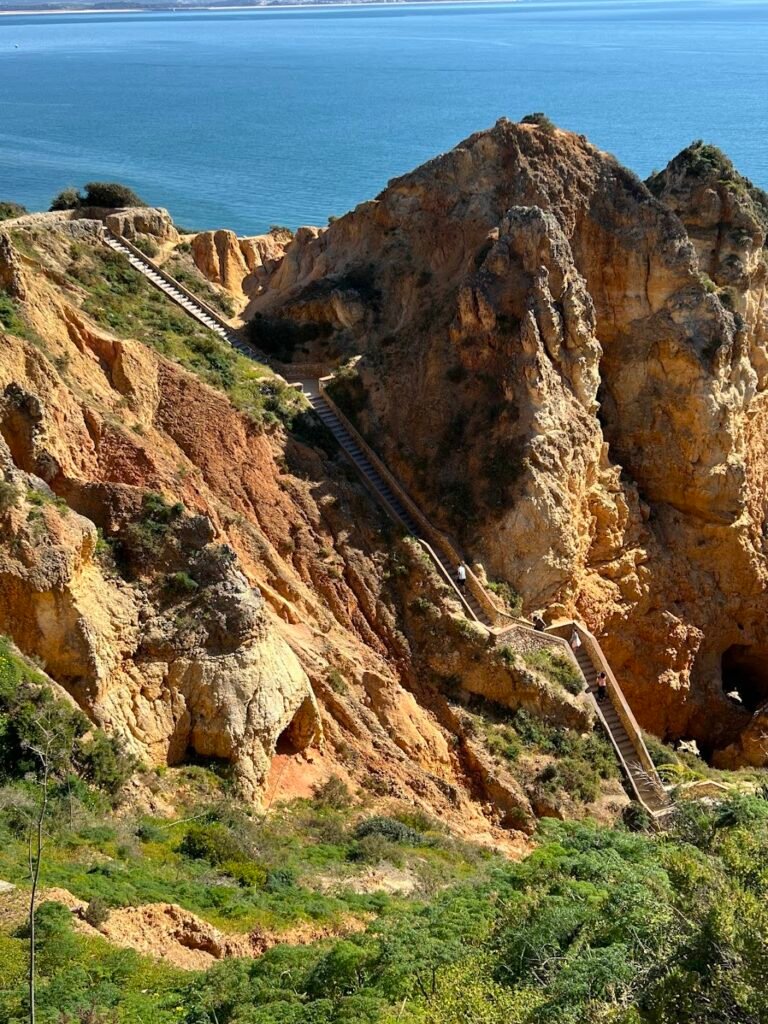
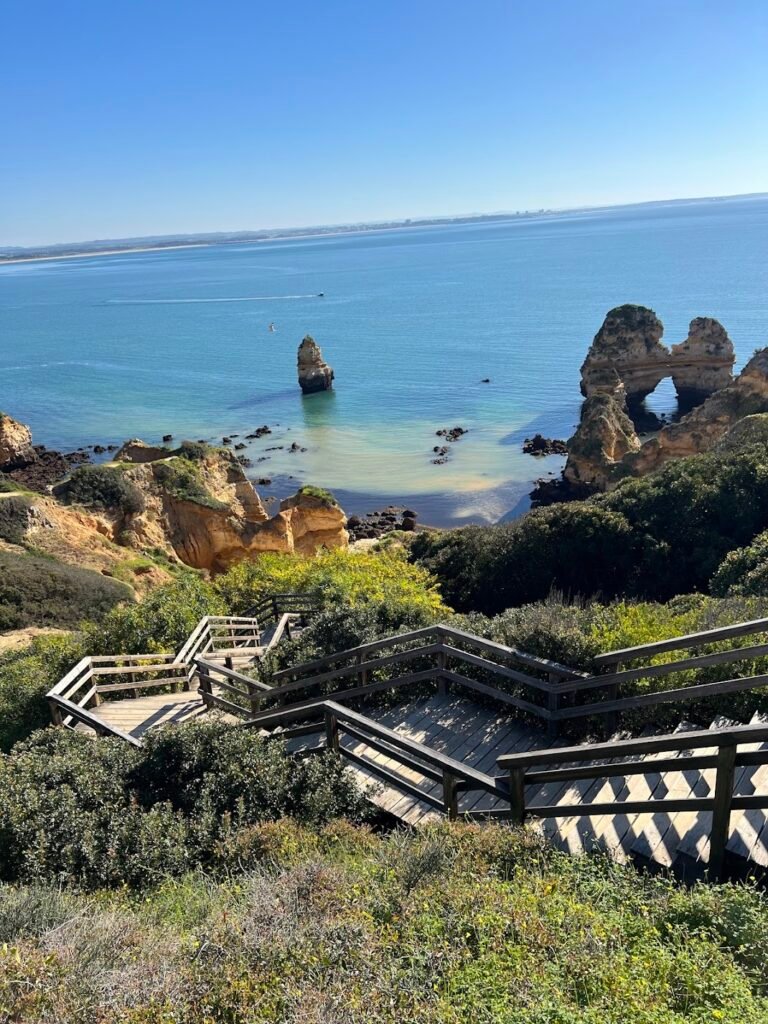
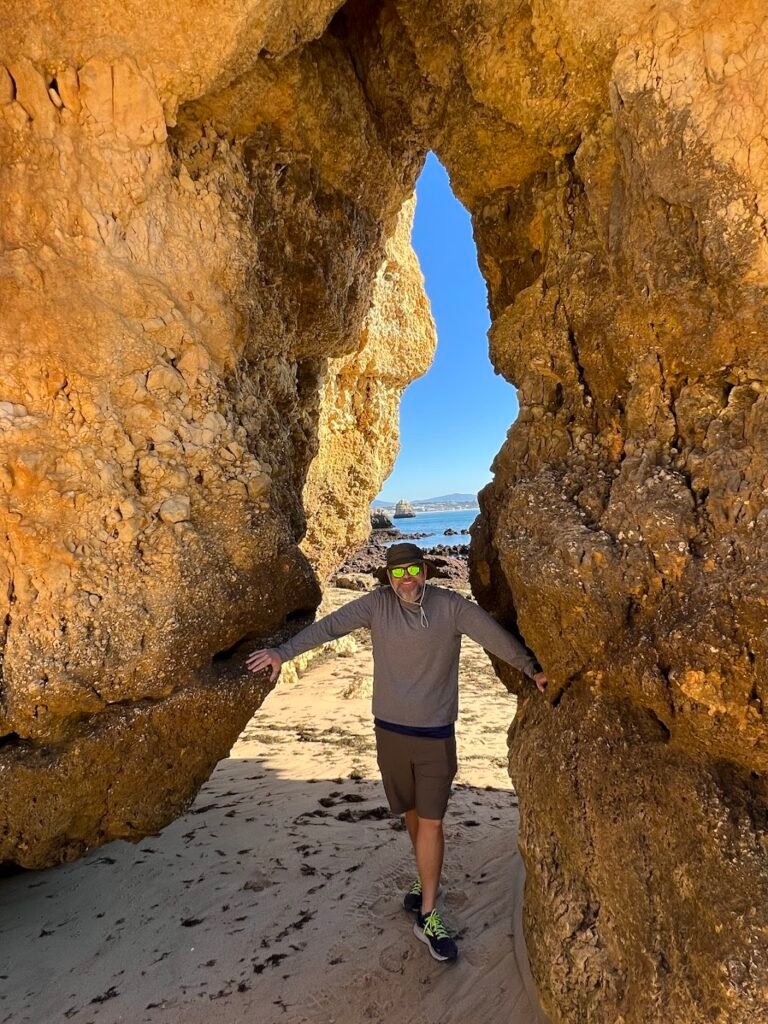
Lagos | Ponta da Piedade Grotto Boat Tour
We know it might seem crazy to do two boat tours in as many days, but we were keen to once again see where we had walked in the morning from a different perspective.
We took part in a late morning boat cruise that departed from the heart of Lagos. There was only one other couple on our RIB, making it feel like a private tour. Once again we weaved in and out of the rock formations, grottos, and arches as high tide was coming in. We really enjoyed our boat tour and both agreed we liked this one even better than the previous day’s tour.
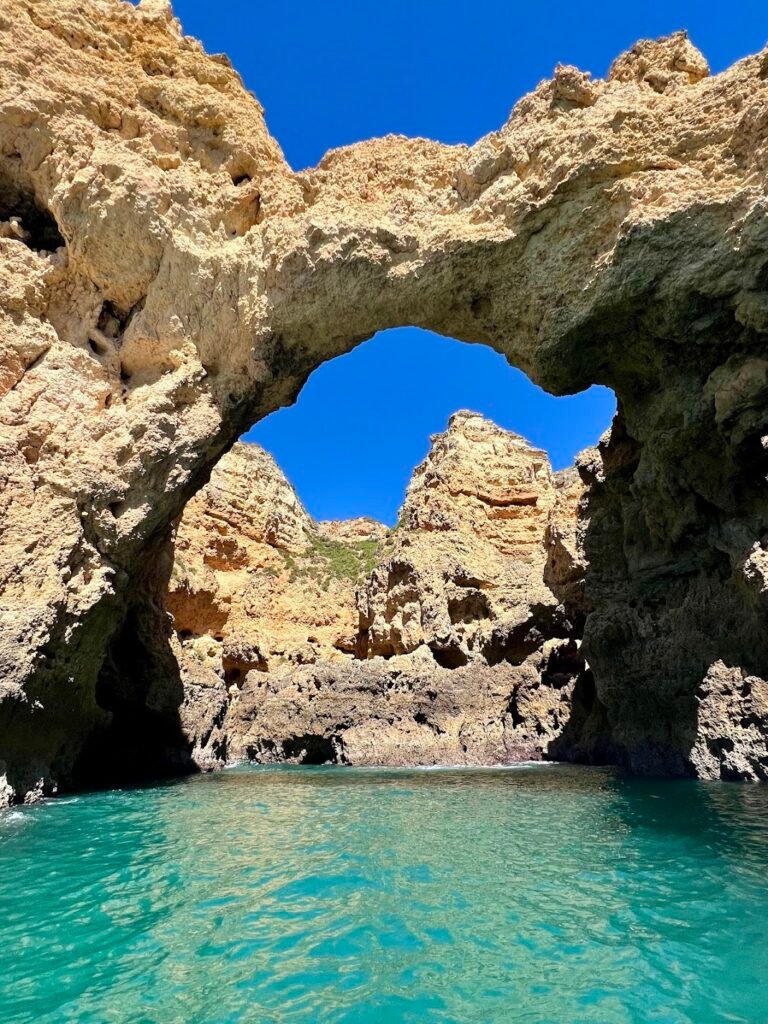
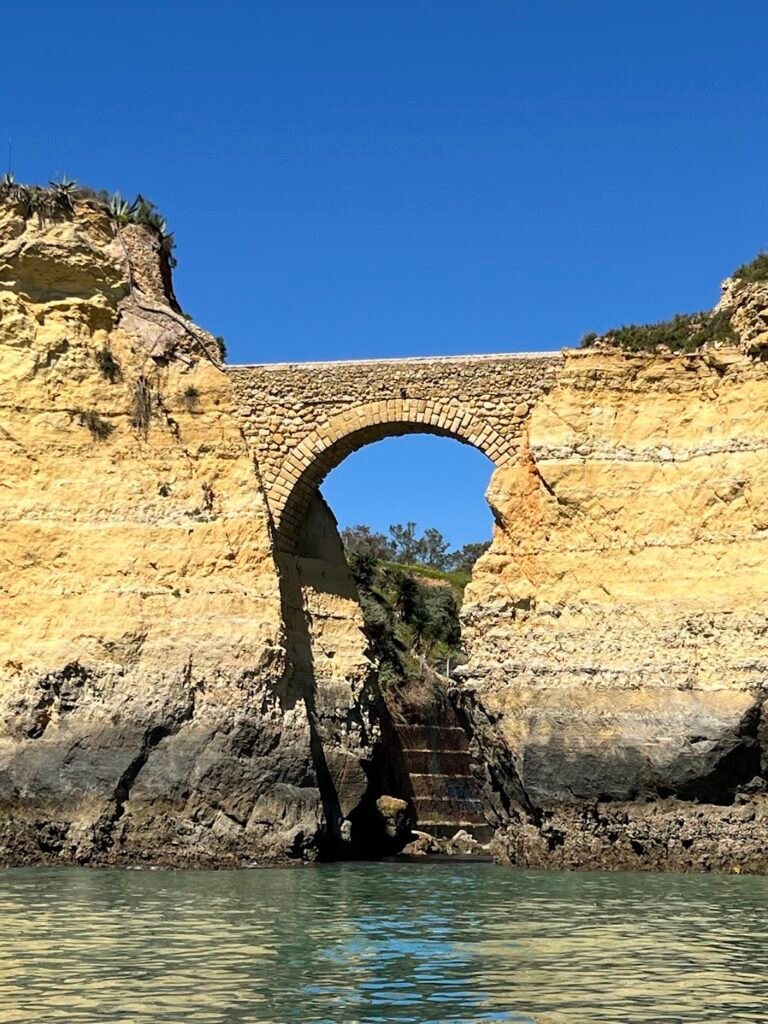
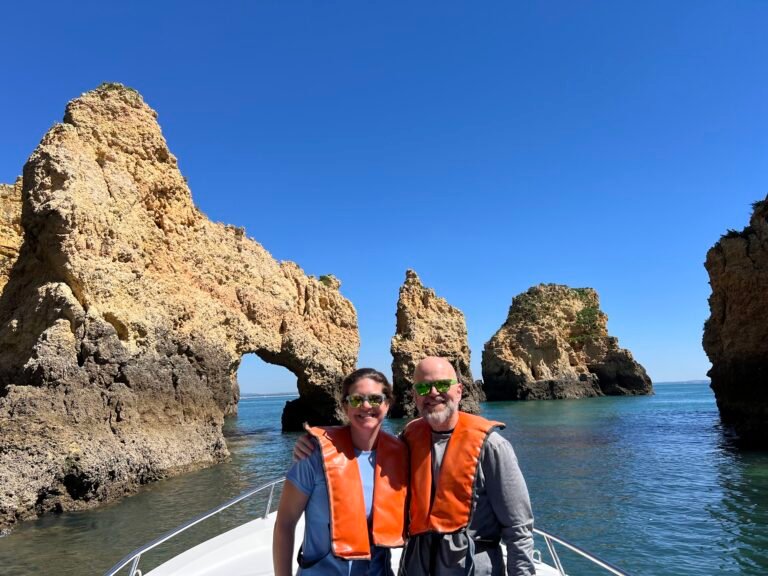
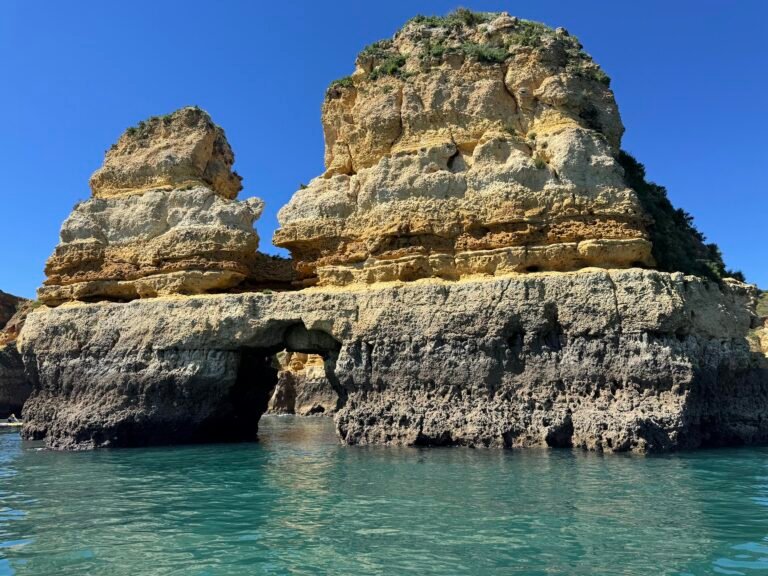
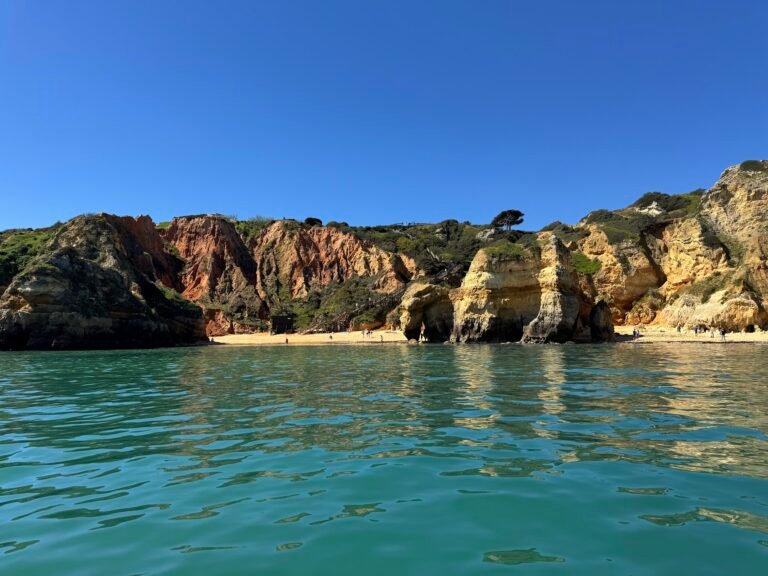
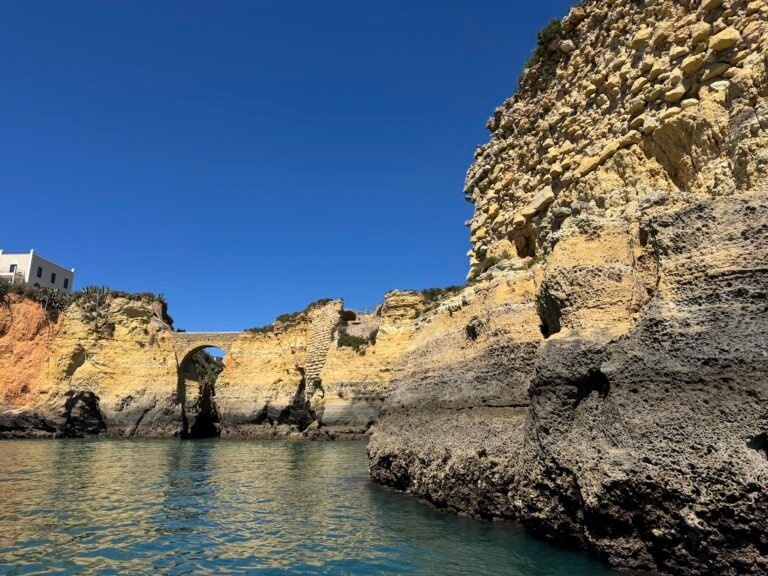
Need to Know
- Tours: There are many companies offering boat tours but we went with BlueFleet based on the positive reviews. We paid ~EUR 20/pp.
- Pro tip!: When booking, be sure to look for and use the 15% discount code on their website’s banner.
- Our Experience: We were very happy with the tour and the scenery was wonderful. The guide harped a lot on what the rock formations looked like (e.g., an elephant, the Titanic, etc.) which got a little old after awhile. We thought the natural beauty of the rocks was enough.
Lagos | Lunch
We stopped in at Pom Pom Bagels in the Old Town area of Lagos for lunch. We had a BLT and a roast beef sandwich on bagels and they were huge and delicious. We recommend Pom Pom Bagels if you’re looking for a satisfying breakfast or lunch in Lagos.
In Lagos, we also had a Pastel de Nata that was second only to the flavor and texture of the Pastel de Belém. This was from the bakery Padaria Central located in the heart of Old Town.
Lagos | Castle of Lagos
When walking around Old Town Lagos, the medieval castle is hard to miss. Its walls once surrounded the entire city of Lagos as a defense and you can still see the remnants today.
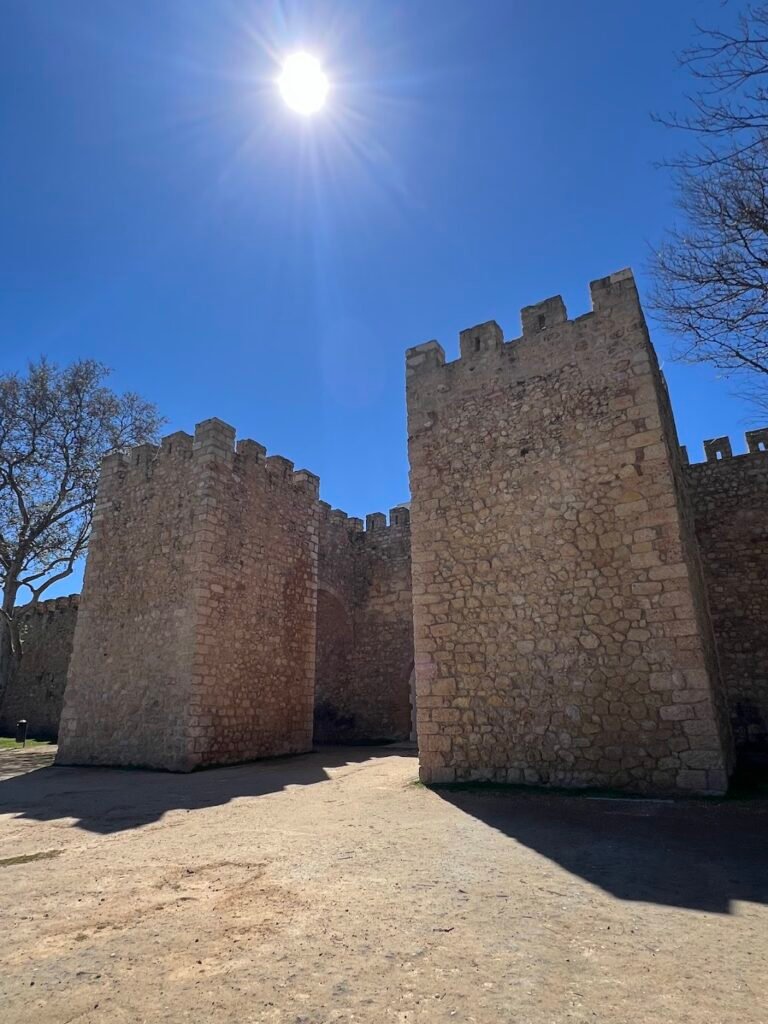
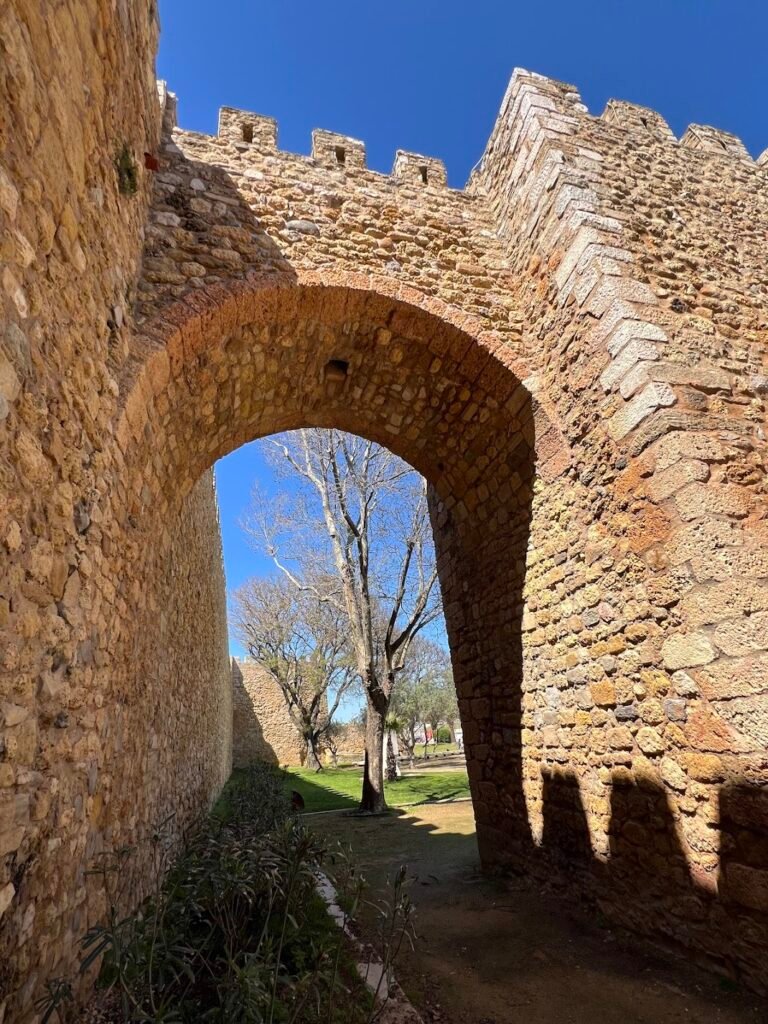
Lagos | Museu de Lagos
Just around the corner from the castle is the Museu de Lagos. This small museum highlights the history, culture, and communities of the Algarve. We particularly enjoyed the “Cabinet of Curiosities” holding all manner of artifacts. Before exiting, we visited the Santo Antonio Chapel with its impressive baroque gilded woodwork. We only spent about half an hour walking through the museum but felt it was worth a visit if time permits.
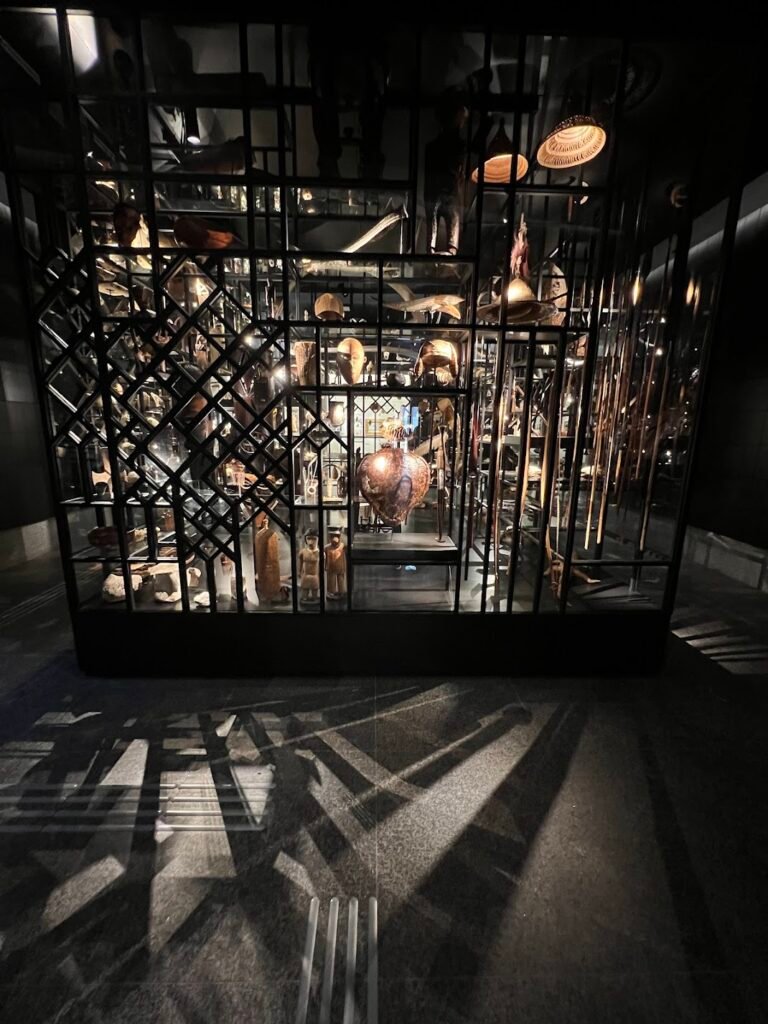
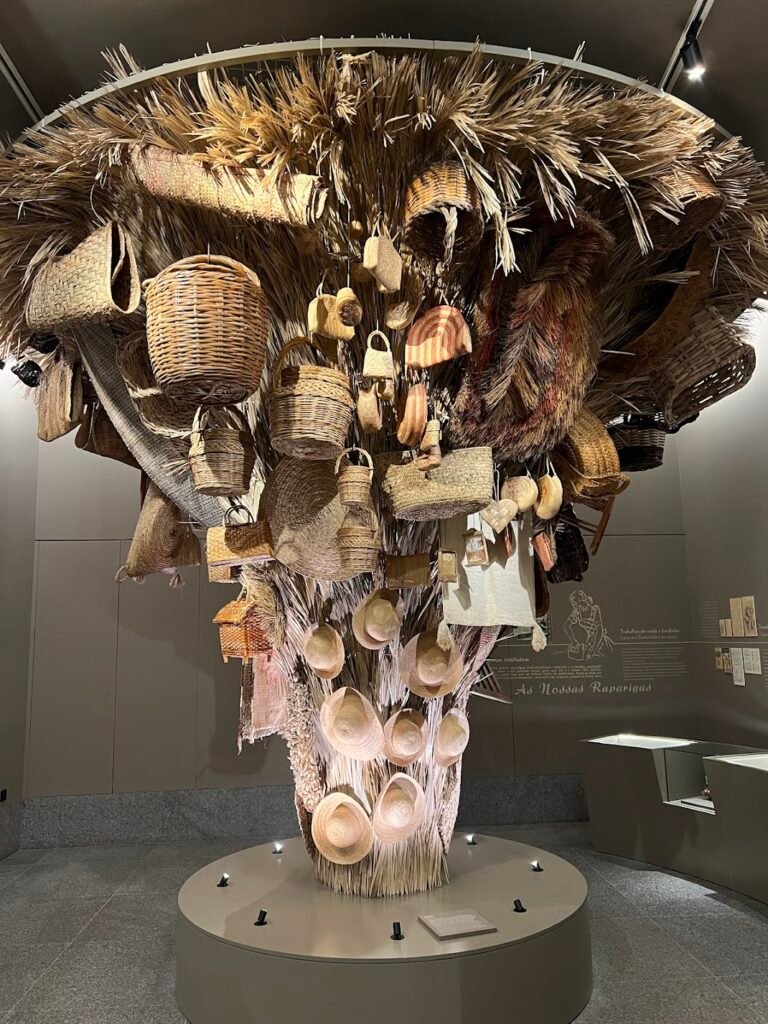

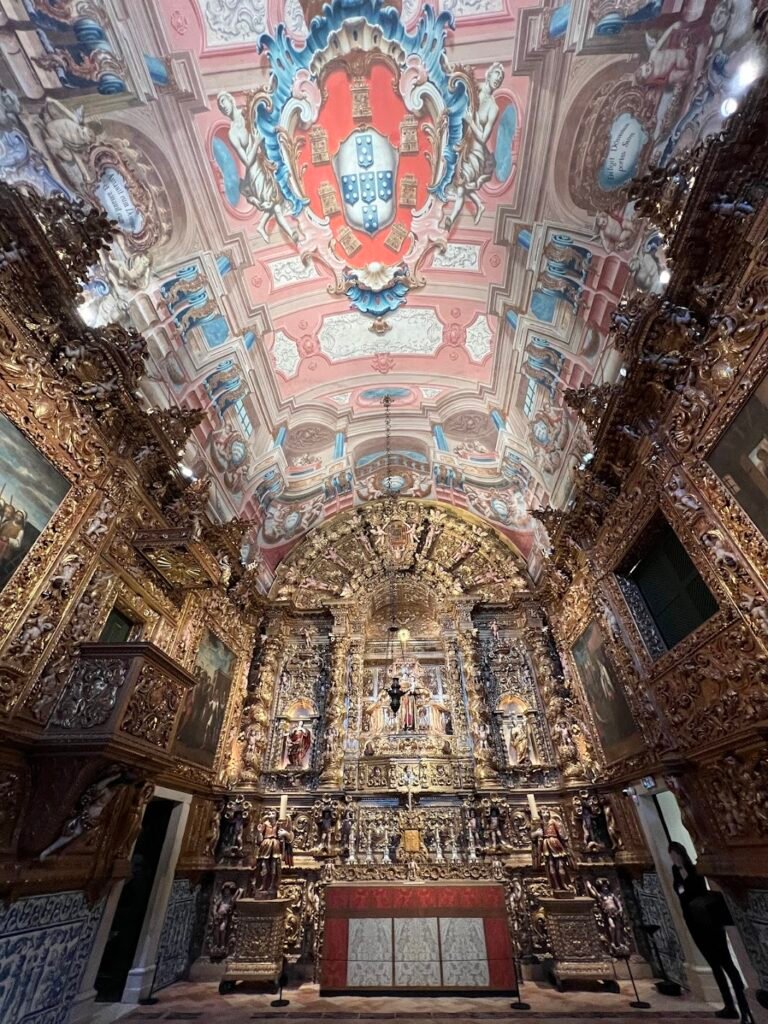
Need to Know
- Hours: Generally open Tuesday-Sunday 10am-1pm and 2-6pm, but check the website for any closures.
- Admission: We paid EUR 3/pp to enter which includes the Santo Antonio Chapel.
- Note: No bags were allowed in the museum at all and had to be checked behind the counter before entry. We thought this a bit odd as this was the only museum in Portugal we had to do so, but the process was easy enough, and free of charge.
Lagos | Dinner
We eagerly anticipated our dinner at Restaurante dos Artistas and it did not disappoint. Recognized by the Michelin Guide as a restaurant of excellence, this was by far the fanciest (and best service) of any restaurant we went to in Portugal. While there were several tasting menus, we chose to order à la carte instead. Along with a bottle of red from Alentejo, we had:
- Chef’s amuse-bouche
- Couvert (fresh bread with three amazing dips)
- Croakerfish ceviche with passion fruit
- Duck breast and croquette with mushrooms, purple carrot puree, and lemon saffron risotto
- Beef filet with asparagus, potatoes, and celery cream
- Portuguese egg pudding with orange foam and honey ice cream
- Glasses of tawny port
- A berry mocktail shot with candies at the end
The overall dining experience was excellent. Definitely make a reservation as it is very popular.

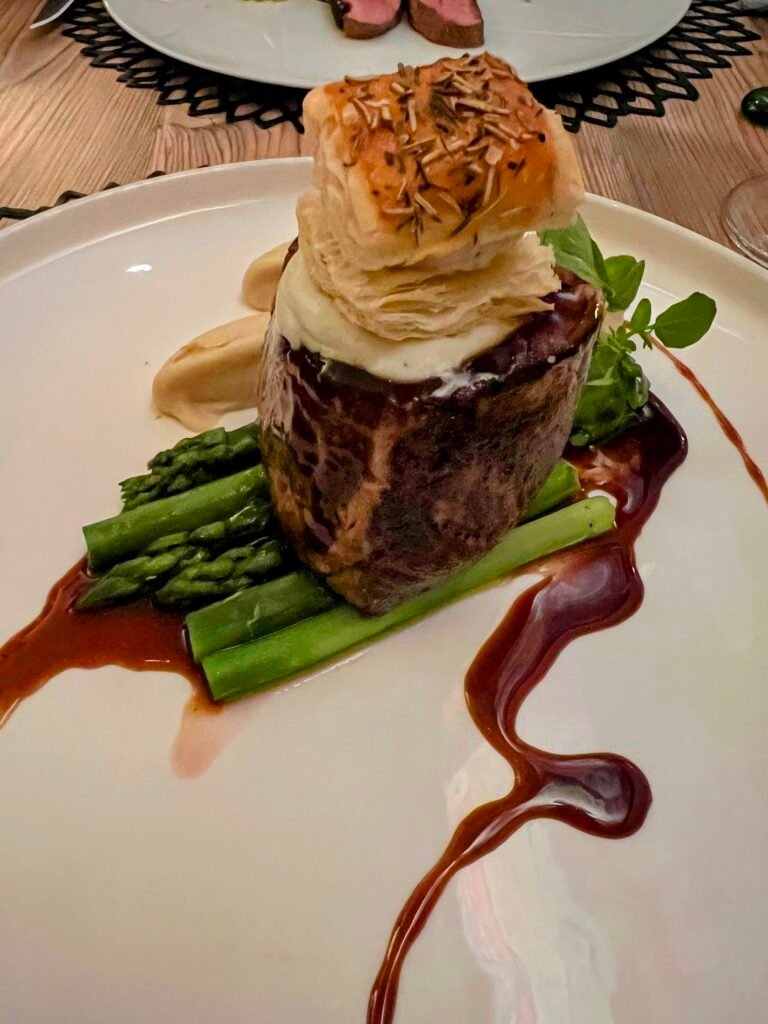
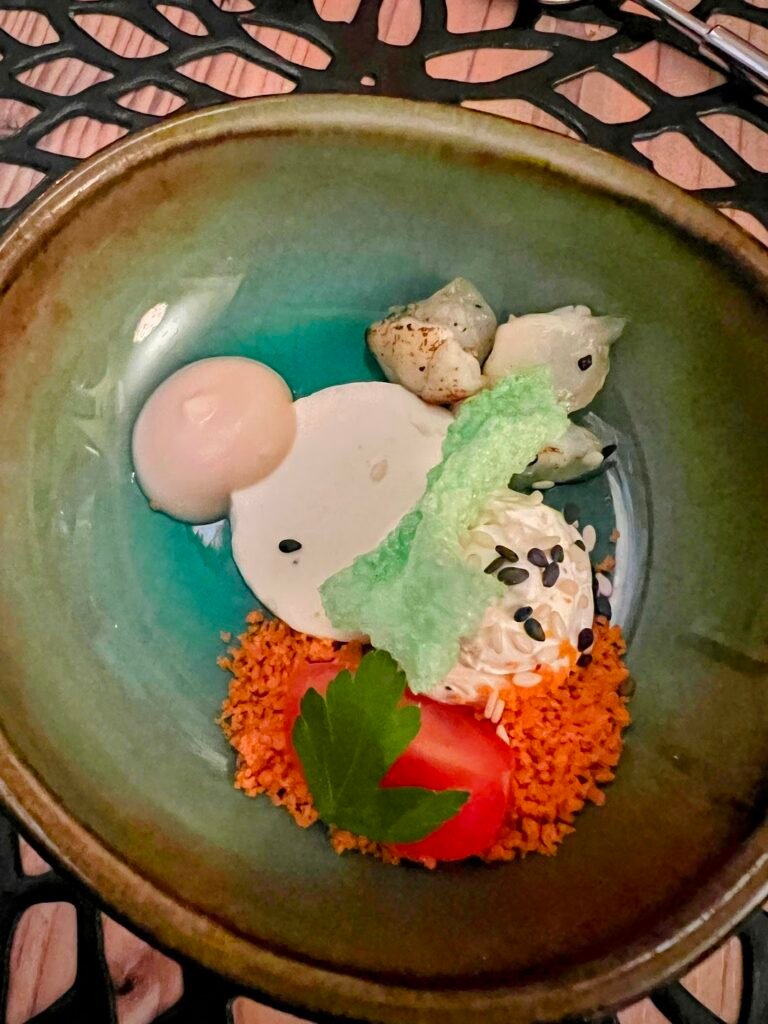

Day 9|Algarve: Beaches, Sagres Fortress, & Cabo de São Vicente
Bordeira | Bordeira’s Beach
Our first stop of the day was Bordeira’s Beach, a 30-minute drive from Lagos. We parked in a large, dirt lot next to the beach (for free). Here, you can explore to your heart’s content. We walked along the beach dune trail and then up to several boardwalk viewpoints along the Carrapateira Cliffs. These are marked with letters and we walked to point “E” and then headed back. Note you can also drive to the top of these cliffs instead of walking.
On the day we visited the ocean was pretty rough and it was windy on the cliffs. That being said, watching the huge swells and frothy surf below was a real treat. There were also plenty of weathered fishermen casting their lines while cliff fishing. We could not get enough of the epic western coastline views which were so different from what we had seen to date in the Algarve.


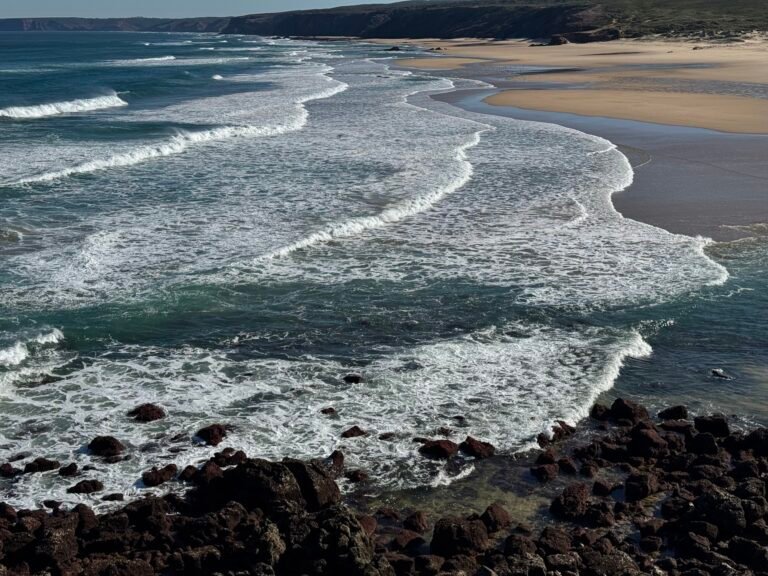

Vila do Bispo | Miradouro da Cordoama
On the way to our next stop, we made a quick detour to Miradouro da Cordoama, a viewpoint in Vila do Bispo. Although the dirt road to get there was very bumpy and rutted, it was passable even in our small rental car. The reward? More amazing views! We only got out to snap a few pictures because it was so windy we felt we might blow away. Far below on the beach at Cordoama we saw a group of hardy souls in the middle of a surf lesson!


Sagres | Lunch
As we drove through, we found the town of Sagres to be SO charming. So much so that we would consider it as a base on our next trip to the Algarve, despite it being at the area’s western edge.
We ate lunch at Three Little Birds and our burgers and grilled cheese with fries were scrumptious.
Sagres | Sagres Fortress
The Sagres Fortress was built in the 15th Century as a strategic place of defense. Once inside, we walked the perimeter and climbed the walls where we could. The interior is deceptively large with a really nice walking path hugging the coastline. The walk was actually our favorite part and there were plenty of signs with information. At one point we even spotted a pod of dolphins in the water below! We spent about an hour walking around the grounds.
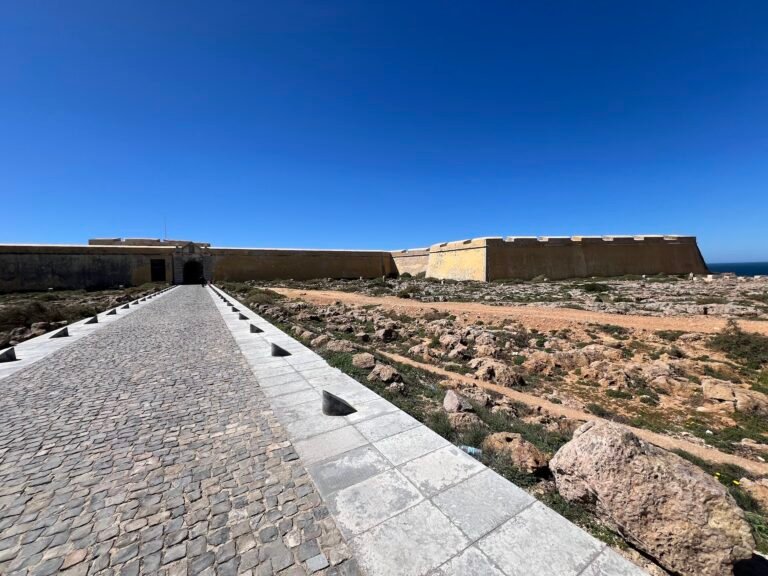
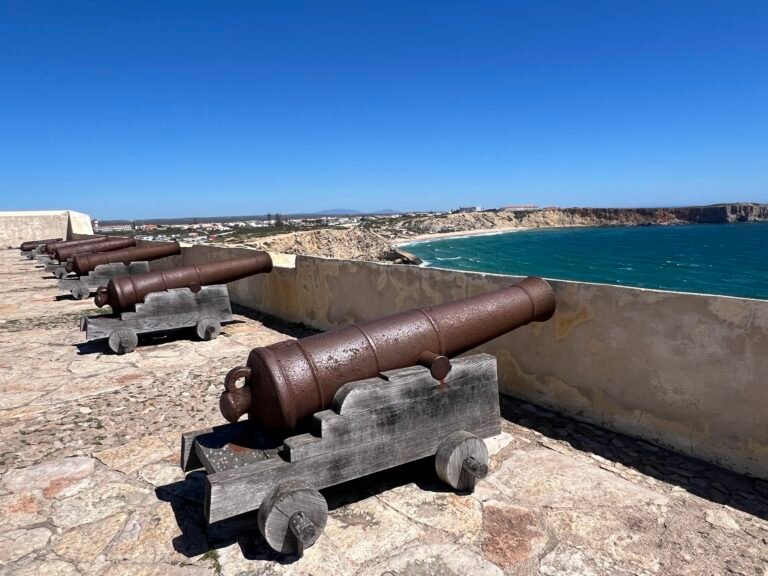
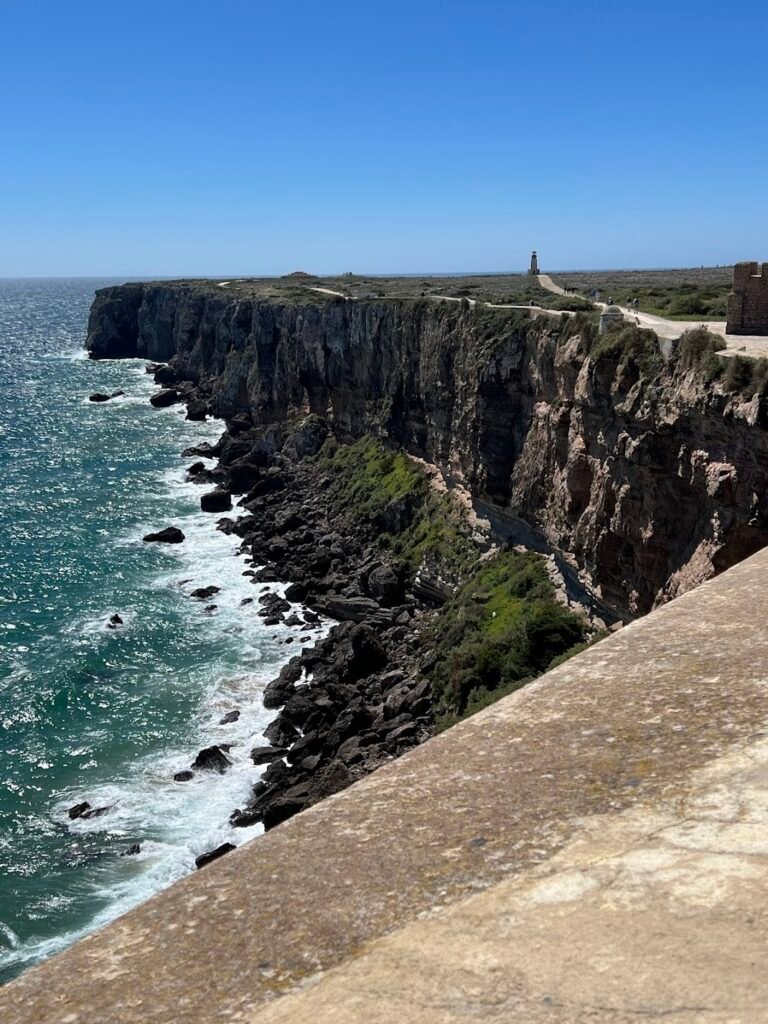
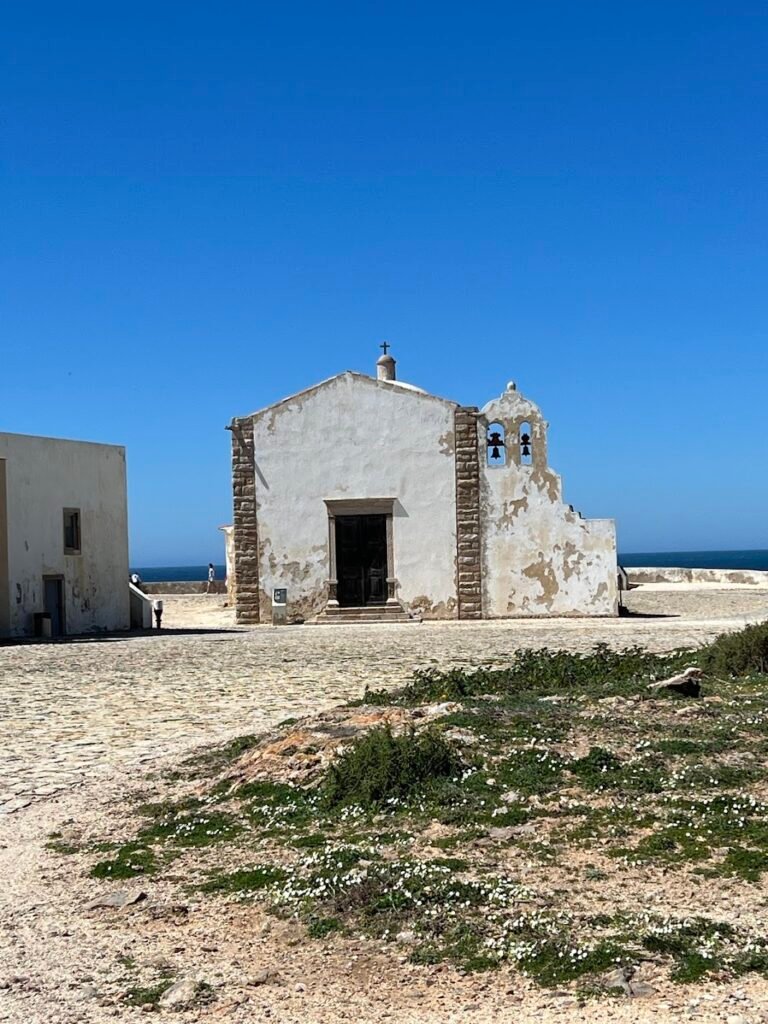
Need to Know
- Hours: Generally open daily 9:30am-5:30pm, but check the website for any closures.
- Admission: We paid EUR 10/pp to enter.
- Note: There is a very large free parking area just outside the entrance to the fortress.
Sagres | Cabo de São Vicente
Our last stop of the day was at Cabo de São Vicente, once thought to be the edge of the world as it is the southwestern most point of mainland Portugal and mainland Europe. We parked along the road and walked out to the lighthouse which was unfortunately closed when we visited, with no stated re-opening date. If you’re hungry, this area is home to the Letzte Bratwurst vor Amerika stand 🙂 and there were plenty of other restaurants along the road to the cape.
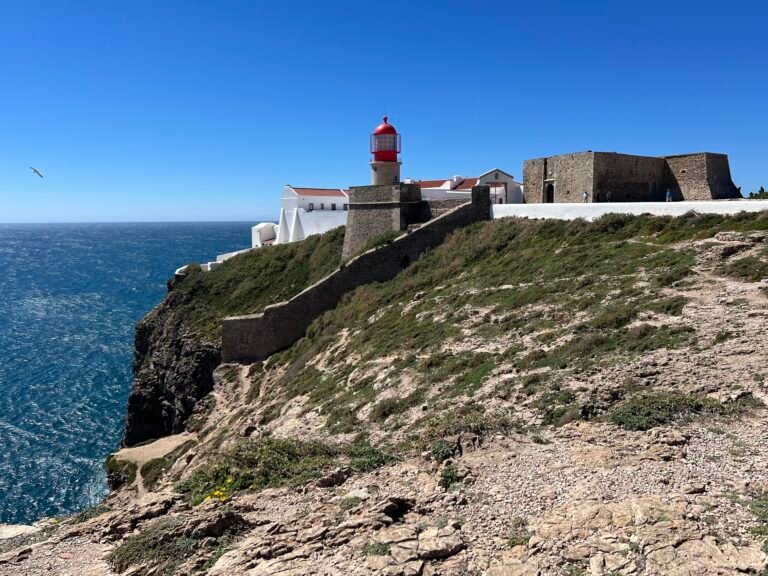
Day 10|Algarve: Jeep Tour & Onward Travel
Albufeira | Algarve Mountains Jeep Tour
On our last morning in the Algarve, we joined this 4-hour jeep tour in the mountains. We ended up getting a private tour because no one else booked and had an incredible time seeing the interior of the Algarve. The coast is beautiful, but there is so much more to the area and we would never have known (or been able to get to) it without this tour.
We rode in the back of a safari-style jeep with very comfortable benches. We were even able to stand up as we drove down a private dirt road among farms out in the country. A 4×4 was absolutely necessary to get to a few of the places we visited. We were crawling up the sides of mountains at the times, but also went through plenty of villages too. Some of the highlights:
- Castle of Paderne: Although we couldn’t go inside, seeing this 12th Century castle and a Roman bridge far below in the valley were very cool.
- Samples of various roadside fruit trees and herb shrubs.
- Leitão Windmill: Unlike any we’ve seen, this wooden cross style windmill could be rotated 360 degrees based on winds, with the aid of the compass inside.
- Goji farm visit replete with samples and adorable farm animals like chickens, roosters, goats, a horse…even an albino peacock!
- Visit to Alte: A town known for its fresh spring water. We stopped at Aqua Mel Cafe for amazing Pastel de Nata (our last of the trip!) and a top-notch cappuccino. If we come back, we’d get fresh-squeezed orange juice, local to the region which is home to dozens of orange groves. We also walked down (175 steps!) to a gorgeous waterfall and local watering hole.
- Our last stop was to a viewpoint high on a mountain, with views of the lush green valley below.

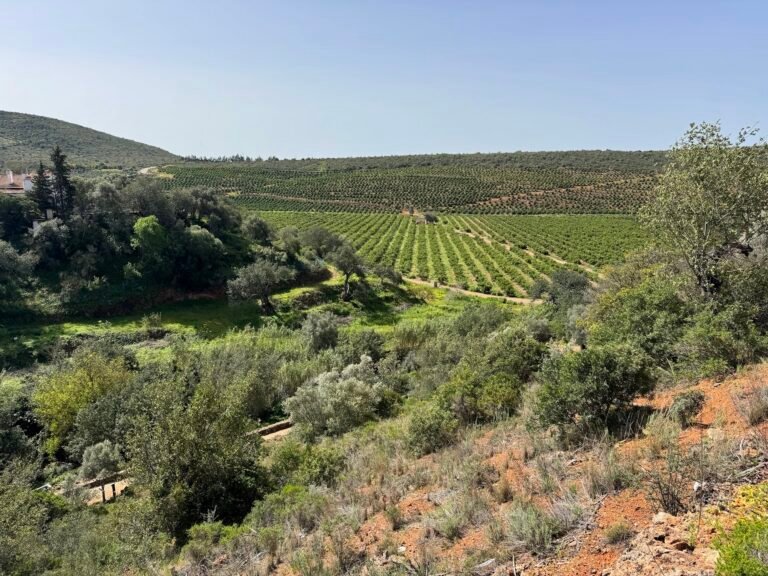

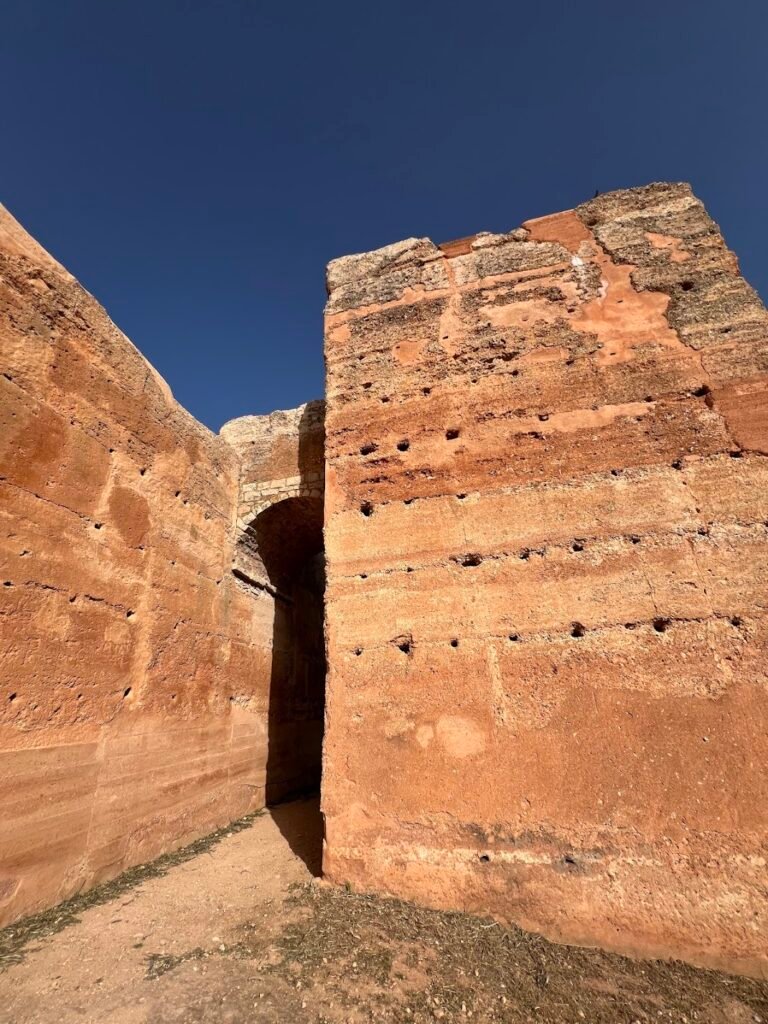

Onward Travel
What We Didn’t Do in the Algarve
Even with almost four full days in the Algarve, there was plenty we didn’t get do based on the weather or running our of time. Some of the things definitely on our “next time” list are:
Coasteering: A way of exploring the coastline involving climbing, scrambling, jumping, and swimming, we had a coasteering expedition booked that was cancelled due to unfavorable conditions. The Algarve is the quintessential spot to coasteer though, so we want to try next time.
Silves: Silves is a town in the Algarve region with a castle, cathedral, archaeological museum and more. We ran out of time to visit on this trip.
Explore More Beaches: We had the cliffside trails near Praia dos Três Irmãos and Praia João de Arens on our list but also ran out of time! We would have also liked to get to the far east of the Algarve and stop in the town of Faro.
Back to Lisbon
After our jeep tour we drove 2.5 hours back to Lisbon to stay overnight before our flight back to the U.S. the next morning. Our hotel,Hotel ibis Lisboa Jose Malhoa, was just okay (the room was small and the A/C didn’t work great), but it was close to the airport and had free parking, so it fit the bill.
We had an unexpectedly wonderful meal at the tasca Mafarrico. Perfectly crispy meat croquettes, Bifana whose bread was so soft, and red wine.
We hope you enjoyed reading our trip to Portugal as much as we enjoyed traveling throughout the country. Despite having traveled to the Azores previously and now taken this 10-day trip, we still want to come back which speaks volumes to our positive experiences. Saúde!


